
- My Interests

Top Stories

How to Win EVERY Game of Warzone 3 (Call of Duty Tips)

Top 10 Best Casinos in Nairobi Reviewed

Esports Entrepreneurs: Build your Business Empire from Pixels and Passion
Stay connected, 10 types of tourist attractions.
When planning a vacation or exploring a new destination, one of the first things that comes to mind is the tourist attractions you can visit. Tourist attractions are places or sites that draw visitors due to their cultural, historical, natural, or entertainment value. These attractions play a pivotal role in attracting tourists worldwide and contribute significantly to local economies.
In this article, we will explore the top 10 types of tourist attractions that you should consider including in your travel itinerary. Each type offers unique experiences and insights into different aspects of our world, from iconic landmarks and natural wonders to theme parks and museums.
1. Iconic Landmarks
Iconic Landmarks are perhaps some of the most well-known tourist attractions globally. They represent a country or city’s identity and are significant symbols recognized worldwide. These landmarks become focal points for travellers seeking memorable photo opportunities or a chance to connect with history.
The Eiffel Tower – Paris, France
One such iconic landmark is The Eiffel Tower in Paris, France. Standing at an impressive height of 330 meters (1080 ft), this wrought-iron lattice tower attracts millions of visitors annually. The observation decks offer breathtaking views of the French capital’s skyline and have become synonymous with romantic moments captured by tourists from around the globe.
The Great Pyramids – Giza Plateau, Egypt
Another famous example is The Great Pyramids on the Giza Plateau near Cairo, Egypt. This ancient wonder remains an enigma for historians and archeologists alike while continuing to captivate travellers with its towering presence as it has for thousands of years.
2. Natural Wonders
Nature has provided us with awe-inspiring landscapes that leave us marvelling at their grandeur and beauty. Natural wonders offer visitors an opportunity to immerse themselves in the breathtaking landscapes and experience the raw power of nature.
The Grand Canyon – Arizona, United States
The Grand Canyon in Arizona, United States, is a prime example of a natural wonder. Carved by the Colorado River over millions of years, this immense gorge stretches approximately 277 miles (446 km) long and up to 18 miles (29 km) wide. Hiking trails allow visitors to explore different canyon sections and witness its ever-changing colours as the sun casts shadows throughout the day.
Victoria Falls – Zimbabwe/Zambia Border
Victoria Falls is one of Africa’s most famous natural attractions located on the border between Zimbabwe and Zambia. They are known locally as “Mosi-oa-Tunya” or “The Smoke That Thunders,” this waterfall measures an astonishing 355 feet (108 meters) in height and spans more than a mile (1.7 km) across. The sheer force and beauty of Victoria Falls make it a must-visit destination for nature enthusiasts.
3. Historic Sites
For those interested in history, visiting historic sites provides an opportunity to step back in time and gain insights into ancient civilizations, significant events, or milestones that shaped our world.
Machu Picchu – Cusco Region, Peru
One such historic site is Machu Picchu , located high in Peru’s Andes Mountains above the Sacred Valley near Cusco. Built by the Incas around AD 1450 but abandoned during Spanish colonization, this mystical city showcases impressive stone architecture that has stood the test of time. Exploring Machu Picchu’s terraces and buildings allows visitors to appreciate Inca ingenuity while admiring breathtaking mountain views.
Petra – Ma’an Governorate Jordan
Hidden amidst rugged desert canyons lay Petra , an ancient city carved into pink sandstone cliffs within present-day Jordan. Dating back to 300 BCE, this UNESCO World Heritage Site features stunning ruins, including the iconic Treasury and Monastery. Walking through the narrow canyon known as the Siq and witnessing these ancient wonders leaves visitors in awe of Petra’s rich history.
4. Museums and Galleries
Museums and galleries explore art, culture, science, and history. These institutions house collections of artifacts, artwork, scientific exhibits or historical documents that aim to educate and inspire visitors.
The Louvre – Paris, France
The Louvre Museum in Paris, France, is one of the world’s largest art museums. Housed within a former royal palace spanning over 600 years of history, it displays iconic masterpieces such as Leonardo da Vinci’s Mona Lisa and Venus de Milo. Visiting The Louvre allows art enthusiasts to immerse themselves in some of humanity’s most outstanding achievements.
Smithsonian Institution – Washington D.C., United States
The Smithsonian Institution is a collection of museums in Washington, D.C., USA. Comprised of 19 museums ranging from natural history to space exploration to African American history, each museum aims to preserve our heritage while enlightening visitors about various fields of knowledge. The Smithsonian offers an unparalleled learning experience for individuals with diverse interests.
5. Theme Parks
Theme parks are designed with entertainment at their core, offering thrilling rides, attractions for all ages and immersive experiences that transport visitors into different worlds.
Disneyland – Anaheim, California
Founded by Walt Disney himself in 1955, Disneyland remains one of the most famous theme parks globally, in Anaheim, California, USA. With its enchanting castles, intertwining pathways, and famous characters such as Mickey Mouse, this magical kingdom still captures the hearts (and wallets) of families looking to share new memories.
Universal Studios Hollywood – Los Angeles, United States
Another renowned theme park is Universal Studios Hollywood , located in Los Angeles, California. It offers visitors the opportunity to enter the world of movies and television with behind-the-scenes tours, thrilling rides styled after blockbuster films such as Jurassic World and Harry Potter, and live entertainment options that keep guests entertained throughout their visit.
6. Cultural Neighborhoods
Exploring cultural neighbourhoods allows one to immerse oneself in local traditions, architecture, cuisine, and community. These neighbourhoods often offer unique experiences through events or authentic shops where you can purchase locally made crafts or taste traditional dishes.
The Medina of Marrakech – Morocco
The Medina of Marrakech in Morocco is a UNESCO World Heritage Site renowned for its vibrant atmosphere and rich heritage. Visitors can wander through labyrinthine streets with colourful souks selling spices, textiles, and handicrafts. The mesmerizing beauty of riads (traditional Moroccan houses) exemplifies the city’s architectural splendour.
Gamla Stan – Stockholm, Sweden
In the heart of Stockholm lies Gamla Stan , also known as “The Old Town.” This well-preserved medieval neighbourhood offers visitors a glimpse into Sweden’s history with its narrow cobblestone streets, charming cafes, and historic buildings like the Royal Palace. A stroll through Gamla Stan feels like stepping back in time.
7. Adventure Destinations
For adrenaline junkies seeking an action-packed vacation,
Queenstown – New Zealand
Queenstown, in New Zealand, is renowned for offering an array of thrilling activities—from bungee jumping to jet boating to skydiving. Nestled between mountains and surrounded by crystal-clear lakes, this picturesque destination serves up exhilaration alongside spectacular natural scenery that appeals to adventure seekers around the globe.
Kruger National Park – South Africa
If wildlife encounters are your idea of adventure, then Kruger National Park should be on your must-visit list. As South Africa’s largest game reserve, it is home to the Big Five (elephant, lion, leopard, rhino and buffalo ) and many other wildlife species. Exploring the park’s vast landscapes on a safari allows one to witness these majestic creatures in their natural habitat.
8. Architectural Marvels
Architecture enthusiasts will be captivated by magnificent architectural marvels showcasing human imagination and ingenuity.
Taj Mahal – Agra, India
The Taj Mahal in Agra, India, is an exquisite example of Mughal architecture renowned for its white marble facade and intricate carvings. Considered one of the New Seven Wonders of the World, this mausoleum was built by Emperor Shah Jahan in memory of his late wife. The Taj Mahal’s beauty at sunrise or sunset is breathtaking.
Sydney Opera House – Sydney, Australia
Designed by Danish architect Jørn Utzon, Sydney Opera House is an iconic symbol for Sydney and Australia. Its distinctive sail-like roof structure overlooks Sydney Harbour, hosting some of the world’s most acclaimed performances. The complex also houses bars, restaurants, and shops where visitors can enjoy stunning views or explore Australian cultural experiences.
9. Religious Sites
Throughout history, religion has significantly influenced art, architecture, and culture. Religious sites hold spiritual significance for many individuals while offering architectural beauty worth admiring regardless of faith.
Angkor Wat – Siem Reap, Cambodia
In Siem Reap, Cambodia, Angkor Wat is not only the largest religious monument globally but also a UNESCO World Heritage Site. This sprawling temple complex serves as a place of worship and an artistic masterpiece reflecting the Khmer Empire’s achievements between the 9th-15th centuries. Encapsulating intricate carvings towers that rise skyward and a sense of serenity, Angkor Wat simultaneously fascinates both historians and tourists alike.
Vatican City – Rome, Italy
Located within the heart of Rome, Vatican City is an independent city-state known for being the spiritual epicentre of Catholicism. Visitors can marvel at architectural wonders like St.Peter’s Basilica and Michelangelo’s frescoes in the Sistine Chapel. Exploring Vatican City often includes admiring priceless masterpieces in the Vatican Museums while experiencing a deep spiritual awe.
10. Scenic Routes
Sometimes, the journey itself is as important as reaching a destination. Scenic routes provide travelers with breathtaking landscapes, helping them connect with nature while driving, cycling or hiking.
Pacific Coast Highway – California, United States
The Pacific Coast Highway , also known as Highway 1, stretches along California’s coastline, offering stunning ocean views, spectacular cliff drops, and charming coastal towns such as Monterey and Santa Barbara. Explore hidden beach coves, breathe in fresh sea air, and enjoy mesmerizing sunsets during one of world’s most scenic drives.
The Great Ocean Road – Victoria, Australia
Spanning approximately 243 kilometres (151 miles) between Torquay and Allansford, The Great Ocean Road provides travellers with magnificent coastal scenery in Australia. An array of cliffs, windswept beaches, and iconic limestone formations like Twelve Apostles make this road trip adventure genuinely unforgettable.
Visiting tourist attractions worldwide allows us to discover new cultures, appreciate nature’s beauty, unravel history’s mysteries, or create lasting memories filled with laughter and joy. Whether you are seeking adventure, cultural experiences, historical insights or serene moments reconnecting with Mother Nature, It is essential to select destinations that align with your interests and preferences. Utilizing planning tools and resources available online can help shape your itinerary, guaranteeing an unforgettable travel experience.
Sign Up For Daily Newsletter
Be keep up get the latest breaking news delivered straight to your inbox..
Leave a Reply Cancel reply
Your email address will not be published. Required fields are marked *
Save my name, email, and website in this browser for the next time I comment.

Sign in to your account
Username or Email Address
Remember Me
Protect Your Trip »
The 50 best tourist attractions in the u.s..
See which American landmarks are worthy of your bucket list.

(Getty Images) |
From national parks to iconic symbols of freedom and democracy, these popular and highly regarded U.S. tourist attractions cannot be missed.

U.S. Space & Rocket Center: Huntsville, Alabama

Denali National Park and Preserve: Alaska

Grand Canyon National Park: Arizona

Hot Springs National Park: Arkansas

Golden Gate Bridge: San Francisco, California

Pikes Peak: Cascade, Colorado

(Courtesy of Mystic Aquarium) |
Mystic Aquarium: Mystic, Connecticut

DiscoverSea Shipwreck Museum: Fenwick Island, Delaware

(Courtesy of Walt Disney World Resort) |
Walt Disney World Resort: Orlando, Florida

(Courtesy of Coca Cola) |
World of Coca-Cola: Atlanta, Georgia

Road to Hana: Hana, Maui, Hawaii

(Courtesy of Idaho Tourism) |
Kirkham Hot Springs: Lowman, Idaho

Chicago River: Chicago, Illinois

Indianapolis Motor Speedway: Indianapolis, Indiana

The Field of Dreams: Dyersville, Iowa

(Courtesy of Oz Museum) |
Oz Museum: Wamego, Kansas

Kentucky Horse Park: Lexington, Kentucky

French Quarter: New Orleans, Louisiana

Acadia National Park: Bar Harbor, Maine

National Aquarium: Baltimore, Maryland

Freedom Trail: Boston, Massachusetts

Mackinac Island: Michigan

(Courtesy of Mall of America) |
Mall of America: Bloomington, Minnesota

(Courtesy of Elvis Presley Birthplace) |
Elvis Presley Birthplace and Museum: Tupelo, Mississippi

Gateway Arch: St. Louis, Missouri

Glacier National Park: West Glacier, Montana

Chimney Rock National Historic Site: Bayard, Nebraska

Las Vegas Strip: Las Vegas, Nevada

Mount Washington Cog Railway: Mount Washington, New Hampshire

Cape May: New Jersey

White Sands National Park: Holloman Air Force Base, New Mexico

Statue of Liberty: New York City, New York

Wright Brothers National Memorial: Kill Devil Hills, North Carolina

Theodore Roosevelt National Park: North Dakota

Rock & Roll Hall of Fame: Cleveland, Ohio

(Courtesy of First Americans Museum) |
First Americans Museum: Oklahoma City, Oklahoma

Mount Hood: Oregon

Liberty Bell: Philadelphia, Pennsylvania

The Breakers: Newport, Rhode Island

Fort Sumter National Monument: Charleston, South Carolina

Mount Rushmore National Memorial: Keystone, South Dakota

(Courtesy of Country Music Hall of Fame and Museum) |
Country Music Hall of Fame and Museum: Nashville, Tennessee

The Alamo: San Antonio, Texas

Zion National Park: Utah

(Courtesy of Smugglers' Notch Resort) |
Smugglers' Notch Resort: Jeffersonville, Vermont

Colonial Williamsburg: Williamsburg, Virginia

Space Needle: Seattle, Washington

White House and the National Mall: Washington, D.C.

Harpers Ferry, West Virginia

Lambeau Field: Green Bay, Wisconsin

Yellowstone National Park: Wyoming

You might also be interested in:
- The Best National Parks in the U.S.
- The Best Hiking Trail in Every State
- Vacation Ideas for Every Type of Traveler
- The World's Best Tourist Attractions
- The Most Famous Landmarks in the World
If you make a purchase from our site, we may earn a commission. This does not affect the quality or independence of our editorial content.
You May Also Like
Top things to do in las vegas with kids.
Holly Johnson and Amanda Norcross July 12, 2024

Top Christmas Cruises
Gwen Pratesi July 11, 2024

Top African Safari Vacations
Christine Smith and Timothy J. Forster July 9, 2024

The 5 Best Memphis Tours
Gwen Pratesi July 8, 2024

The Best Fanny Packs and Belt Bags
Marisa Méndez July 3, 2024

Top Things to Do in Montana
Ben Luthi and Kelsey J. Lawrence July 3, 2024

The 4 Best Temecula Wine Tours
John Rodwan and Nicola Wood July 2, 2024

The Best Puerto Rico Tours
John Rodwan July 2, 2024

Amazon Prime Day Luggage Deals
Amanda Norcross July 2, 2024

Best Monterey Whale Watching Tours
John Rodwan and Ann Henson July 1, 2024

- English (UK)
- English (CA)
- Deutsch (DE)
- Deutsch (CH)
8 types of tourism that you need to know
The three tourism categories, domestic tourism, inbound tourism, outbound tourism, the 8 types of tourism according to motivation, business tourism.
- Meet with business partners or prospects
- Attend an event, conference, or trade show
- Visit another office location of the same company
?)
See how to save money on business travel
Leisure tourism, shopping tourism, cultural tourism, sports tourism, rural tourism, mountain tourism, urban tourism, many people travel – but for completely different reasons.
?)
Make business travel simpler. Forever.
- See our platform in action . Trusted by thousands of companies worldwide, TravelPerk makes business travel simpler to manage with more flexibility, full control of spending with easy reporting, and options to offset your carbon footprint.
- Find hundreds of resources on all things business travel, from tips on traveling more sustainably, to advice on setting up a business travel policy, and managing your expenses. Our latest e-books and blog posts have you covered.
- Never miss another update. Stay in touch with us on social for the latest product releases, upcoming events, and articles fresh off the press.
?)
5 inefficient processes affecting your business and how to fix them
?)
Duty of care in the workplace: everything you need to know
?)
CEO Roles and Responsibilities: conquer your role as CEO
- Business Travel Management
- Offset Carbon Footprint
- Flexible travel
- Travelperk Sustainability Policy
- Corporate Travel Resources
- Corporate Travel Glossary
- For Travel Managers
- For Finance Teams
- For Travelers
- Thoughts from TravelPerk
- Careers Hiring
- User Reviews
- Integrations
- Privacy Center
- Help Center
- Privacy Policy
- Cookies Policy
- Modern Slavery Act | Statement
- Supplier Code of Conduct
🙌 Awesome, you're subscribed!
Thanks for subscribing! Look out for your first newsletter in your inbox soon!
Get us in your inbox
Sign up to our newsletter for the latest and greatest from your city and beyond
By entering your email address you agree to our Terms of Use and Privacy Policy and consent to receive emails from Time Out about news, events, offers and partner promotions.
Awesome, you're subscribed!
The best things in life are free.
Sign up for our email to enjoy your city without spending a thing (as well as some options when you’re feeling flush).
Déjà vu! We already have this email. Try another?
Love the mag?
Our newsletter hand-delivers the best bits to your inbox. Sign up to unlock our digital magazines and also receive the latest news, events, offers and partner promotions.
- Things to Do
- Food & Drink
- Time Out Market
- Coca-Cola Foodmarks
- Los Angeles

The 20 top tourist attractions in the USA
Discover the top tourist attractions in the USA, from national-park essentials to iconic structures to must-see streets
Photograph: Shutterstock

Visiting popular tourist attractions can often mean navigating long lines and crowds—essentially, a lot of work for an experience that sometimes doesn't live up to the hype. While some attractions may be a bust, specific landmarks across the United States are well worth the effort.
The top tourist attractions in the USA span from coast to coast, including iconic buildings like the national monuments in Washington DC, must-stroll neighborhoods like the French Quarter in New Orleans, unique landmarks like the Space Needle in Seattle, or sights within breathtaking national parks .
We have rounded up the top U.S. tourist attractions you should add to your bucket list. In your quest to check them off your list, make a trip out of it and book one of the best hotels in America . And if you’re looking for a bit more travel inspiration, check out the best places to visit in the USA right now.
Been there, done that? Think again, my friend.
Top tourist attractions in the USA
1. national mall | washington dc.

Immaculately maintained by the National Park Service, the National Mall and Memorial Parks feature more than 1,000 acres of must-see monuments, sites and green space. While the Washington Monument towers above all else—quite literally, the city doesn’t zone for buildings taller than the marble icon—the Lincoln Memorial, Thomas Jefferson Memorial, Vietnam War Memorial and Martin Luther King Jr. Memorial are just as magnificent. Though it will take a full day (or two) to see the National Mall, set aside some time to peruse through some of Washington, D.C.’s top museums .
2. Niagara Falls | New York State

Situated on the border of New York and Canada, the three waterfalls (Horseshoe Falls, American Falls and Bridalveil Falls) have the combined highest flow rate of any waterfall worldwide. Their impressive force is nothing short of awe-worthy. A top tourist destination since the 19th century, the unstoppable beauty and charm of Niagara Falls make it a memorable and unique landmark.
3. The French Quarter | New Orleans, LA

The oldest corner of New Orleans remains its most charming attraction. Walk down famous Bourbon Street to enjoy jazz, great nightlife and tons of food. While you travel on a streetcar between destinations, pay close attention to the spectacular architecture. And no trip to the French Quarter would be complete without a taste of authentic Cajun grub or a stop to pay your respects in the Cities of the Dead.
4. Statue of Liberty | New York City, NY

Though she may have been born in France, the Statue of Liberty has become synonymous with America and the country’s highest-held values. True, the 151-foot-tall copper monument can be seen up close from aboard the free Staten Island Ferry, but you can also pay your respects in person and even step inside it while on an official tour.
5. Old Faithful | Yellowstone Park, WY

A cone geyser found in Yellowstone National Park, Old Faithful is not entirely as predictable as it once was (it won’t erupt precisely every 74 minutes, for example) yet remains as historically exciting. When erupting, the geothermal feature unleashes more than 3,700 gallons of piping hot water. When you’re done marveling at the spectacle, spend at least a full day exploring the rest of the park.
6. The Strip | Las Vegas, NV

Immortalized in a seemingly endless amount of movies, the Strip’s bright lights, larger-than-life performers and casinos are burned into our collective subconscious. Whether planning on trying your luck at poker or looking to catch a diva’s residency, the Strip is a top destination for all things entertainment and, yes, a bit of debauchery.
7. Smithsonian Museums | Washington, D.C.

The Smithsonian Institution is the world's largest museum, education, and research complex. Located in the heart of this nation's capital, you can explore the National Air & Space Museum , the National Museum Of Natural History, the National Museum of American History, and many more. The best part? It's all free. The latest addition to the museum line-up, which opened in 2016, is the National Museum of African American History and Culture and is a must-visit.
8. The Grand Canyon | Arizona

So, about five to six million years ago, the Colorado River more or less established its route through the Arizona desert. Glacial erosion, meltwater runoff and the simultaneous counter effect of the land slowly rising—as the weight of the glaciers was reduced—ultimately resulted in one of the most spectacular natural wonders on our modest, little blue-green planet. The Grand Canyon is 277 miles long, varies between four and 18 miles wide and has a maximum depth of 6,000 feet. There are hotels and restaurants in key locations, but for the most part, you should visit and marvel at how incredible this world is—you know, before we ruin it.
9. J. Paul Getty Museum | Los Angeles, CA

The Getty brings visitors from across the country and around the world to California. The $1 billion facility, designed by internationally renowned architect Richard Meier, features travertine and white-metal pavilions highlighting the complex’s futuristic frame. Inside, find one of the most exciting art collections—including Medieval manuscripts, paintings by Van Gogh and Monet, and modern sculptures.
10. Kennedy Space Center | Orlando, FL

If you’ve always dreamed of working in outer space, this is your chance to see and touch models of space shuttles, rockets, satellites, tools and mission control rooms. The simulators and explorable modules will make you feel like an actual astronaut—though if you wonder just how much the experience compares to the real deal, you can meet one of those brave scientists in person at the Astronaut Encounter Theater.
11. Golden Gate Bridge | San Francisco, CA

Name a more iconic bridge—we'll wait. There's a reason the Golden Gate Bridge is so famous. With its vibrant international orange color and spanning from San Francisco to the Marin headlines, stands as a symbol of the West. There are countless ways to take in the stunning bridge views: head to a beach (try Baker Beach), head to the new Presidio Tunnel Tops Park, go to a vista overlook, or get up close and personal by crossing the bridge by foot or bike. A trip to San Francisco isn't complete until you get a picture with the Golden Gate in the background.
12. Little Havana | Miami, FL

After decades of serving as a home to Cuban exiles, Little Havana has become a must-visit destination in its own right. While out on the town, throw back rum-spiked Caribbean drinks and dance the night away to live rumba and salsa music. The food here is legendary : Cuban sandwiches, Colombian arepas, savory tacos and other Latin American dishes will leave your mouth watering.
13. Hoover Dam | Nevada

Perhaps the best example of America’s building prowess in the first half of the 20th century, this dam remains a bewildering feat of engineering and labor. Construction started in 1931 and took five years, 5,000 workers and 3.25 million cubic yards of concrete to complete. Today, you can tour the dam and its power plant to learn more about the facility’s history and unique features.
14. The Gateway Arch | St. Louis, MO

Not only is St. Louis’s premiere attraction the world’s largest arch, but it is also the tallest man-made monument in the Western Hemisphere. Standing proud at 630ft tall, this metal beauty was built in the mid-20th century as a monument to America’s westward expansion and is meant to signify the connection of the East to the West, honoring the country’s first pioneers. To fully understand this architectural wonder, snag a ticket to the Gateway Arch Tram and ride to the top of the monument.
15. Mammoth Cave Park | Kentucky

With more than 400 miles explored, the world’s longest known cave system (by far) is in Kentucky and it welcomes any visitor not afraid of the dark or the damp. See the dramatic passages lined with geological formations that might inspire your inner explorer during a guided tour by a park ranger. The tours vary in length but they always include historic details about how the cave system was formed and how people and other creatures have interacted with it. After several hours in the caverns, appreciate the beauty of the clear waters and the untouched nature of the area while on a bike ride or canoe adventure.
16. Space Needle | Seattle, WA

Like many famous landmarks, Seattle’s iconic Space Needle was built for the World’s Fair, back in 1962 when the theme was “The Age of Space.” Today, it remains one of the most recognizable and photographed landmarks worldwide for its futuristic design. Standing at 605 feet tall, visitors can take an elevator up to the tower’s saucer-shaped top floor with 360-degree views. Recent renovations resulted in a multi-level viewing experience with floor-to-ceiling glass viewing that will make your stomach drop.
17. Navy Pier | Chicago, IL

Clearly, one of the Midwest’s most popular destinations, Navy Pier is visited by roughly nine million people each year. From excellent shopping opportunities to eateries and, of course, Lake Michigan, the destination offers something for everyone. The little ones will be delighted by the Chicago Children’s Museum , while grown-ups should head to the award-winning Chicago Shakespeare Theater .
18. Alcatraz | San Francisco, CA

This formidable fortress in the middle of San Francisco Bay was converted from a lighthouse station to a military prison in the 1870s. However, it found genuine acclaim after being upgraded to a maximum security prison in 1934, home to the early 20th century’s most notorious criminals. Today, the tiny island is only accessible to the public via a ferry from Pier 33 Alcatraz Landing. You should plan to spend about three hours soaking up the amazing history and during that time, a self-guided audio cellhouse tour narrated by former inmates and guards will fill you in on harrowing escape attempts, prison riots and the 19-month-long occupation of the site by Native Americans demanding reparation for broken treaties in 1969.
19. Venice Beach | Venice, CA

Wedged in between Marina del Ray and Santa Monica, Venice Beach is one of the biggest draws for visitors to Los Angeles. It's firmly established as the bohemian epicenter of Southern California and you won't find a higher concentration of recognizable landmarks from film and TV anywhere else in Los Angeles. At weekends, during the summer, it gets pretty packed, but that just adds to the slightly chaotic atmosphere. Street acts add a carnival feel to the proceedings, plus, of course, the beach is just a few feet away. Try Hinano Cafe for a great burger in a back-to-basics, spit 'n sawdust setting and the newly refurbished Pier House for classic cocktails as the sun sets over the Pacific.
20. Alamo Mission | San Antonio, TX

Most Americans know the phrase 'Remember the Alamo' even if they’re not exactly sure what transpired at the 18th-century Spanish mission. Later secularized and used as a fortress, 1836 the Alamo was the site of a bloody and decisive battle of the Texas Revolution between Texas’s early Anglo settlers and Mexico (the latter won). One of the most visited historic sites in the country today, the fort welcomes about three million visitors annually.
[image] [title]
Discover Time Out original video
- Press office
- Investor relations
- Work for Time Out
- Editorial guidelines
- Privacy notice
- Do not sell my information
- Cookie policy
- Accessibility statement
- Terms of use
- Copyright agent
- Modern slavery statement
- Manage cookies
- Advertising
Time Out products
- Time Out Worldwide

44 Different Types of Tourism That You Need to Try
By: Author Zachary Friedman
Posted on Last updated: March 14, 2024
Categories Travel , Travel Destinations
Home » Travel » 44 Different Types of Tourism That You Need to Try
There are a million different ways to travel. Some people prefer to be pampered in a luxury resort while others don’t even care if they have running water. Some people enjoy exploring crowded cities while others would rather venture as far from civilization as possible. To help you plan your next trip, this list outlines 44 different types of tourism. Hopefully, it inspires you to tour the world a bit differently.
One thing to keep in mind is that not all types of tourism will appeal to every traveler. Some are a bit controversial. Some are dangerous. This article is designed to inform you of your options and give you some ideas for future trips.

1. Adventure Tourism
The goal of adventure tourism is to explore remote destinations, participate in adventure activities, and maybe even take a bit of risk.
Many adventure tourists participate in physically challenging outdoor activities during their trips such as mountaineering, rafting, rock climbing, kayaking, or hiking. The United States, New Zealand, and Canada are popular destinations for this type of trip.
Some adventure tourists visit remote, hard-to-reach, or off-the-beaten-path destinations. West and Central Africa, North Korea, Turkmenistan, and New Guinea come to mind.
Adventure tourism can also mean traveling to regions where there is some risk. This could mean a risk of injury, disease, or encountering unfriendly locals. This is a very niche form of Adventure tourism.
2. Dark Tourism

Dark Tourism, a relatively new term, is defined as travel to an area where death, disaster, or tragedy occurred in the past. People visit these sites mostly for historical reasons or simply out of morbid curiosity. Humans seem to have a natural interest in death and disaster. Dark tourist sites are some of the most visited places in the world.
Dark Tourism Destinations include:
- Museums- The September 11 museum in New York City or the War Remnants Museum in Ho Chi Minh City, Vietnam for example.
- Monuments- The Vietnam Veteran’s Memorial in Washington D.C. or the Monument to the Murdered Jews of Europe in Berlin, for example.
- Memorials- The Kigali Genocide Memorial in Kigali or the 911 Memorial in New York City, For example.
- Battlefields- Taking a tour of World War I, World War II, or the United States Civil War battlegrounds is a popular tourist dark tourism activity.
- Natural Disaster Sites- Visiting Pompeii in Italy or Mount St. Helens in Washington State, for example.
- Concentration Camps – Auschwitz-Birkenau in Poland receives over 2 million visitors per year, making it one of the most visited dark tourism sites.
- Human-Caused Disaster Sites- Touring the Exxon-Valdez oil spill zone, for example.
- Sites Where Murders Took Place – For example, the Jack the Ripper tour in London or Lizzie Borden’s house in Fall River Ma.
- Graveyards- Visiting a celebrity’s gravesite for example.
- Catacombs- The catacombs in Paris is popular among dark tourists.
- Nuclear Disaster Sites- Chernobyl in Ukraine is one of the world’s most popular dark tourist sites.
- Shipwrecks- Wealthy tourists have visited the Titanic. There are plenty of fascinating shipwrecks anyone can dive.
- War Zones- People travel to active war zones. A good example would be taking a trip to Syria today.
- Slums- Dharavi in Mumbai or Kibera in Nairobi are some of the largest and most well known.
Some dark tourism sites are pretty controversial. Visiting war zones and slums cause ethical concerns among some groups of people. This is something to take into consideration before you go.
For more info, check out my complete dark tourism guide.
3. Ecotourism

Ecotourists visit exotic destinations to view pristine, fragile, and undisturbed natural environments. Visiting places that have not been affected by human interference. The goal is to experience these places while leaving as little impact on the environment as possible. Ecotourism is sometimes referred to as sustainable tourism.
Ecotourists aim to leave the environment as it was or better than when they arrived. The focus is on conservation. Ecotourists try to improve the well being of the environment and local people in the region. Ecotourism is quickly gaining in popularity as more and more people become interested in conservation and environmentalism.
One major benefit to ecotourism is that some of the money that tourists bring into the country is put into preserving the environment that they are visiting. This makes for a very sustainable form of tourism.
Popular Ecotourism Destinations
- Costa Rica- This is one of the most environmentally friendly countries on earth. The main draws of Costa Rica are rainforests, volcanoes, and both Pacific and Caribbean beaches. The country also has incredible biodiversity. The Costa Rican government works very hard to preserve nature and the environment through legislation and sustainable development.
- Galapagos Islands, Ecuador- Made famous by Charles Darwin, the Galapagos Islands are famous for their unique wildlife. Ecuador enforces strict guidelines for visitors in order to maintain the natural environment of the islands.
- Antarctica- The least-visited continent and one of the most untouched places on earth. Antarctica is an expensive but rewarding destination for ecotourists. The best way to get there is by cruise from Ushuaia, Argentina.
- Alaska- Also called The Last Frontier, Alaska is known for its vast stretches of tundra and wildlife. Visit national parks, glaciers, fjords, and mountains in this beautiful state. Ecotourism here is becoming increasingly popular.
- The Amazon Rainforest- This rainforest has the highest biodiversity of any place on the planet. Unfortunately, it is being destroyed at an unbelievable rate. Ecotourism practiced properly can help to save this special environment, even if only in a small way. You can visit the Amazon in Brazil, Colombia, Ecuador, Peru, or Bolivia.
4. Voluntourism
Voluntourism is a combination of tourism and volunteering. A voluntourist travels to a destination to do volunteer work. Usually for a charity organization. In their off time, voluntourists usually explore their travel destination like a normal tourist. This is becoming a major part of the tourism industry.
The volunteer work could be building homes, working in agriculture, teaching, etc. Anyone can take a volunteer vacation but you really need to have an in-demand skill for the work to be worthwhile.
This is one of the more controversial types of tourism. Before taking a volunteer vacation, you have to do your homework to make sure that your work will be worthwhile. Sometimes volunteer work can do more harm than good.
Popular Voluntourism Destinations
Volunteering opportunities can be found all over the world. Generally, you’ll find more openings in developing countries than in developed countries. A few of the most popular voluntourism destinations include:
- East and Southern Africa- You will find plenty of voluntourism opportunities in Tanzania, Uganda, and Kenya in schools and small farming operations.
- South and Southeast Asia- Cambodia, Vietnam, and Thailand are popular destinations for voluntourists.
- Central and South America- Mexico, Guatemala, Peru, and Ecuador offer plenty of volunteer opportunities.
There are a few arguments against voluntourism. It takes jobs from locals. If the work is unskilled, it is easy to find local labor. It is also inefficient. Flying across the world to do a job that someone who lives there could do doesn’t make any sense. Many charity organizations are corrupt or scams. Some actually charge people to volunteer. In this case, the volunteer is the customer. Sometimes nothing of value is created and the donations get pocketed by corrupt officials.
If you do choose to do volunteer work abroad while traveling, make sure that you understand and trust the organization that you are volunteering for.
5. Domestic Tourism
Domestic tourism is travel within the country in which you reside. This is sometimes referred to as a staycation. Domestic tourism offers an exciting and unique way to experience the beauty of your own country. You can enjoy domestic tourism wherever you live. Even if you don’t leave your city.
The classic road trip is probably the most popular form of domestic tourism. No matter where in the world you live, you can load up your car, motorcycle, or bicycle and set out on an adventure. Every country has camping and hiking opportunities. Domestic tourism is a fun and inexpensive way to explore your home country.
Domestic tourism is more common in some countries than in others. Generally, domestic tourism is more popular in larger countries. For example, domestic tourism is extremely popular in the United States, Japan, Germany, China, and India.
Domestic tourism is particularly popular in my home country, the United States. Because the country is so large and diverse, you could spend a lifetime traveling here and still not see it all. There are bustling cities, theme parks, sandy beaches, and spectacular national parks to visit. Millions of Americans exclusively travel domestically.
In smaller countries, d omestic tourism options are more limited. Having said that, regardless of where you live, there are dozens of interesting sites to visit within a couple of hours of your home. You could even simply tour your home town. Even if you’ve lived there your whole life, there are sure to be some new places you’ve never been.

Benefits of Domestic Tourism include:
- Domestic tourism is cheaper- Many domestic tourists choose to drive to their destination. This way, the only transportation expense is gas. If you choose to fly, domestic tickets are generally cheaper than international tickets. It’s also affordable to travel by bus or train. This makes domestic tourism far cheaper than international tourism.
- You get to see another side of your country- Domestic tourism allows you to experience your home country as a tourist and meet your fellow countrymen.
- Domestic tourism is easier and more convenient- There is no language barrier or culture shock to deal with. You don’t need any travel documents for domestic tourism. You don’t need to exchange money. Much less planning is required to travel domestically.
Domestic tourism may not be as exciting as international tourism. Staying in your home country isn’t s exotic as visiting a foreign country.
6. Medical Tourism
Medical tourism is travel for the purpose of receiving healthcare. This type of tourism is also called health tourism. A few of the most common procedures people travel for include cosmetic surgery, dental care, and cancer treatment. It is becoming increasingly common for people to travel abroad to buy prescription medications as well.
An entire industry is set up around medical tourism. For example, some doctors and dentists cater to foreigners traveling to their countries for treatment. They often hire English-speaking staff and may even offer hotel and food packages to make the process as easy as possible. The medical tourism industry is booming. This is quickly becoming a major part of the tourism industry in some countries.
There are a number of reasons people participate in medical tourism. Treatment may be cheaper in another country. Treatment options may be better. Sometimes a specific treatment is only available in another country.
Popular Medical Tourism Destinations
- The United States
7. Bicycle Tourism

Bicycle tourism is travel by bicycle. The average bicycle tourist covers about 50 miles per day, camps at night, and cooks many of their own meals. All gear is carried in panniers or bikepacking bags on the bike.
The main benefit of this type of tourism is that you get to see parts of the world between cities. Most travelers just take a bus, train, or plane from town to town and miss out on the rural areas in between. When bicycle touring, you get to see every inch of the country that you’re touring. You can smell flowers and feel the topography of the land as you cycle up and down hills.
Bicycle touring is one of the cheapest ways to travel. Accommodation and transportation costs are cut to almost nothing because you camp every night and have your own transport with your bike. You end up saving a lot of money this way. Some frugal bicycle tourists can travel on less than $500 per month.
There are several different styles of bicycle touring. Some bicycle tourists prefer off-road riding while others prefer to stay on paved paths or roads. Off-road bicycle touring is often called bikepacking. Credit card touring is bicycle touring in comfort. Most credit card tourists pack light, stay in hotels every night, and eat most meals in restaurants. Expedition bicycle tourists travel long distances through exotic countries. Some bicycle tourists spend years crossing continents and cycling around the world.
Top Bicycle Tourism Destinations
- Pamir Highway- This is probably the top bicycle touring destination. Here, you can experience the beautiful mountains of Kyrgyzstan and Tajikistan.
- Patagonia- Travel through the rugged south of Argentina and Chile and explore Torres del Paine, Tierra del Fuego, and many other spectacular destinations in the region. The most famous roads include Ruta 40 and Carretera Austral.
- Trans America- Travel across the United States. Most cyclists ride west to east starting in Oregon.
- US Pacific Coast- Travel from Canada to Mexico through the beautiful coasts of Washington, Oregon, and California.
- Nordkapp, Norway (North Cape)- This is the northernmost point in Europe that can be accessed by road.
- Alaska to Argentina- This long-distance rouge takes you across North and South America. Most cyclists take 18-24 months to complete the route.
- Europe to Asia- This popular route takes you across Eurasia. Many cyclists start their tour in their homes in Europe and end in China or Singapore.
- Cairo to Cape Town- This hardcore trip takes you across the entire continent of Africa. Check out my guide How to Plan a Cairo to Cape Town Trip for more info.
- Round the World- A great bucket list trip for bicycle tourists. Check out my guide: How to Plan a Round The World Trip for more info.
8. Sex Tourism and Romance Tourism
Sex tourism is a controversial type of tourism that involves traveling for the purpose of having sex in different countries around the world. People may choose to do this because prostitution isn’t legal in their home country. Some people wish to fulfill a fantasy that they can’t achieve in real life. Others travel abroad for sex because it is cheaper than in their home country. This type of tourism is much more popular among men but women participate as well.
Popular Sex Tourism Destinations
- The Netherlands
- The Philippines
- Dominican Republic
Romance tourism is travel for the purpose of finding a husband or wife. Someone may participate in this type of tourism if they are unable to find the right person in their home country. Sometimes people who have immigrated abroad return to their home country to find a partner.
9. Motorcycle Tourism

Motorcycle tourism is travel by motorcycle. This is a great way to see the world because you always have your own transportation. This means you don’t have to rely on buses or trains. You can stop wherever you want. The absolute freedom is hard to beat. Maybe the biggest benefit of motorcycle tourism is simply the fact that motorcycles are cool. You will make friends everywhere you go.
Adventure touring bikes are probably the most popular these days due to their comfort and off-road capabilities. You can explore places that the average cruiser or touring bike can’t reach. My last bike was a Suzuki DR 650. I regret selling it.
There are drawbacks to motorcycle tourism. Getting started traveling by motorcycle is pretty expensive. You have to buy a bike, protective riding gear, and learn to ride. This sets you back a minimum of a few thousand dollars before you even hit the road.
Some countries also require that you have a carnet du passage to enter with a vehicle. This is a bureaucratic process and also costs money. Shipping the bike between countries is a hassle and expensive as well. Motorcycle tourism is generally not for budget travelers.
Traveling between continents on a motorcycle is also a hassle. It usually involves putting the bike in a crate and shipping it. You can’t just hop on a plane to your next destination.
If you are on a tight budget, there is one way that you can experience motorcycle tourism on the cheap. Starting at about $150, you can buy your own motorcycle in Vietnam and ride it around much of Southeast Asia. For a step-by-step guide to doing this, check out my Guide to buying a motorcycle and riding through Vietnam.
10. Cultural Tourism
Cultural tourism is a form of tourism where the goal is to seek out cultural experiences. On a cultural tour, you might attend festivals and events, visit historical sites and monuments, explore museums, and galleries, take language classes or cooking classes, and participate in traditional activities.
Cultural tourism is an increasingly popular form of travel as it allows people to immerse themselves in new cultures and gain a more global perspective. Cultural tourism also provides economic development opportunities for locals.
A few different examples of culture include:
- Holidays and festivals
- Food and drinks
- Architecture
Culture is interesting because it varies so widely. In some parts of the world, you can travel just a few miles down the road and people completely change. They may speak a different language, eat different food, and pray to different gods. Human culture is diverse. Sometimes even shocking. This is a big part of the appeal of cultural tourism.
Cultural Tourism Activities
- Visit museums- This is one of the most popular cultural tourism activities. You can learn about the history and view the art of the local people.
- Try local restaurants- Sample the local food.
- Visit churches and other religious centers- Learn about the religious beliefs of the locals-
- Meet people inside their homes- See how people live day-to-day.
- Read books about the region- Learn about the origin of the local people and how their society has changed over time.
- Visit during a local holiday, festival, or celebration- Experience how the locals party and celebrate.
- Study the local language- Learning a few words can help you get to know the local people and understand the culture. Language greatly enhances cultural tourism.
Cultural Tourism Destinations
Every country has a different culture to learn about. Depending on where you come from, you may find some more interesting. A few of the most popular countries for cultural tourism include:
11. Rural Tourism

These days, most of the world’s population lives in cities. Some travelers like to take a break from the fast-paced and stressful urban lifestyle and travel to slower-moving rural areas. This is rural tourism. Rural tourism usually involves living a rural lifestyle, experiencing local culture, and learning local history.
Rural tourism has a lot of overlap with cultural tourism and ecotourism. Because rural areas don’t offer many major tourist attractions, you’ll mostly spend your time learning about and experiencing the rural lifestyle. You’ll also spend much of your time enjoying the outdoors.
One major benefit of rural tourism is that it provides economic opportunities for locals by allowing them to offer services such as farm stays, guided tours, homestays, and meals. This is important because rural areas tend to be poorer than cities.
Rural Tourism Activities
- Learning about agriculture- Wine tours or working with animals are common forms of rural tourism.
- Outdoor activities- Hiking, fishing, hunting, camping, etc. are considered rural tourism
- Relaxing- Read a book, take a walk, or enjoy the sun.
- Getting to know the local people- See culture tourism.
Best Destinations for Rural Tourism
- Much of Africa
12. Tribal Tourism

Tribal tourism involves travel to visit tribes or indigenous people that have had little contact with the outside world. The goal is to experience the culture and lifestyle of the locals. These areas are becoming rarer and rarer as the world becomes more developed and connected. There are only a few regions left on the planet where you can take an authentic tribal tour.
Many of the world’s tribes are no longer authentic. The people wear traditional clothing and basically put on a show for tourists. They may dance and perform ceremonies that their ancestors did. While it is interesting to see, it isn’t really authentic. There are a handful of places left where you can experience a real and thriving tribal culture.
This is another controversial kind of tourism. Many people argue that tourism to these regions is voyeuristic. Like looking at animals in a zoo. Some complain that visiting these tribes degrades their culture. After all, local community will be introduced to modern ways of living and thinking. These are valid points that should be considered before visiting. Is it ethical to visit tribal regions? I’ll let you decide.
Tribal Tourism Destinations
- The Omo Valley of Ethiopia- This incredibly diverse region in Southwestern Ethiopia is home to dozens of unique tribes. For a step-by-step guide to visiting, check out my guide: How to Visit the Omo Valley Independently and on a Budget. It includes everything you need to know about getting there from Addis Ababa, costs, etiquette, hotel recommendations, guides, and more.
- Papua New Guinea- The tribes of New Guinea are some of the most unique culturally. To visit, you’ll most likely have to hire a guide or join a tour group.
- The Amazon- To visit the tribes of the Amazon, you have several options. The best places to start are can Brazil, Peru, or Venezuela. Tours can also be organized from Colombia or Ecuador.
- India- Hundreds of fascinating tribes inhabit the country.
13. Business Tourism
Business tourism is travel for a professional purpose rather than leisure. Some companies send employees abroad for business meetings, conferences, trade fairs, consulting, negotiation, or various corporate events. While participating in business tourism, an employee is still doing work, just away from the office or home. During time off, a business tourist may have time to visit the tourist sites of the region that they are visiting. Various types of tourism can be combined with business tourism.
Business tourism is different from being an expat, digital nomad, or living abroad because it is only temporary. Generally, a business tourist is someone who is working abroad for one year or less. Most business trips last less than a week. Business tourists generally stay in hotels or accommodation provided by the company that they work for.
Business is conducted all over the world. This type of travel is slightly less common than it used to be because of the internet. Many meetings can be conducted online over video. Business tourism is still common.
Some of the most common business tourism destinations include Berlin, Dubai, New York, Paris, Shanghai, Tokyo, and London.
14. Birth Tourism
Birth Tourism is a controversial form of tourism where a pregnant woman travels to a foreign country to give birth to her child. The main reason for this practice is so the child obtains citizenship in the country where it was born. Once the child has citizenship, the parents will generally use it as a means of obtaining citizenship for themselves. The baby is often referred to as an anchor baby.
Laws vary from country to country. In the past, birth tourism was much more common. Laws were much less strict and allowed pretty much anyone born within the country’s borders to become citizens from birth.
These days, most countries either don’t allow birth tourism or don’t grant citizenship to children born there unless they meet specific requirements. Usually, one of the parents also has to hold citizenship in order for the child to be eligible for citizenship. Birth tourism is still common in North and South America but has been abolished in most of the rest of the world.
15. Sports Tourism
Sports tourism is defined as travel for the purpose of watching or participating in a sporting event. This type of tourism could involve professional sports, armature sports, team sports, or individual sports. This type of tourism is one of the fastest-growing in the tourism sector. Some of the world’s biggest events cater to sports fans. These include:
- Olympics Games
- Tour de France
- World Series
- and many more
Anyone who travels to watch a football game, basketball game, tennis match, auto race, etc. is also considered a sports tourist.
Those who travel to participate in sports are considered active sports tourists. The players and coaches and support all fall into this category of tourist. Some tourists travel to participate in extreme sports like skydiving, mountain climbing, mountain biking, surfing, skateboarding. These are also sports tourists.
16. Slum Tourism

Slum tourism, also called ghetto tourism, involves travel to some of the poorest neighborhoods around the world. Tourists come to see what life is like for the poorest people on earth. Mostly out of curiosity.
This type of tourism is not new. It originated in the 19th century in the slums of New York and London where wealthy tourists would travel to see how the impoverished lived in the two cities. These days, slum tourism almost exclusively occurs in the developing world.
Slum tourism is another controversial type of tourism. Many people claim that it is unethical to tour slums because it basically treats people like zoo animals. You are essentially entertaining yourself by touring areas where people are living in extreme poverty. Traveling to people watch just doesn’t sit well with some.
While I understand this argument, these neighborhoods are public places where anyone is free to wander. For this reason, it’s an acceptable activity in my mind. You are simply visiting a neighborhood within a city.

Slum Tourism Destinations
- Kibera in Nairobi, Kenya- This neighborhood claims to be the biggest slum in Africa. For info on visiting, check out my guide: How to Visit Kibera Without a Tour.
- Dharavi in Mumbai, India- Maybe the world’s most famous slums and also one of the biggest. This is where the 2008 movie Slumdog Millionaire takes place.
- Favelas in Rio de Janeiro, Brazil- For safety reasons, visiting the favelas is best done on an organized tour.
- Townships in South Africa- These are segregated communities outside of South African cities that were created during apartheid times.
- Skid Row, Los Angeles, California- This area contains possibly the largest homeless populations in the United States. Around 8000 people live in tents and in the street in this little square of downtown Los Angeles. This is one of the only slum tourism destinations in the developed world.
17. Genealogy Tourism
Genealogy tourism is a type of tourism where travelers visit the places their ancestors came from. This could be recent ancestry or distant ancestry. This type of tourism is much more common in countries with a high level of emigration.
Genealogy tourism is quickly growing in popularity because of the rise in interest in DNA testing from companies like Ancestry.com and 23andme.com. For less than $100 people can find out exactly where in the world their ancestors originated. As the technology develops, these services get more and more accurate. In some cases, they can pinpoint exact villages where your ancestors lived hundreds of years ago.
Some genealogy tourists visit places where they have much more recent roots. For example, if a couple immigrated to another country before having children, their child may wish to visit their parent’s homeland later in life. This is also considered genealogy tourism. In this case, the person may have living relatives in the place that they are visiting.
18. Package Tourism (Group Tourism)
Package tourism is a type of travel where accommodation, transportation, and excursions are combined and sold in a single package. Sometimes meals, drinks, and guides are also included. This can be a private tour or a group tour. A package tour is also called a package vacation or package holiday.
The main draw of this type of tourism is the simplicity. You pay once and the tour operators take care of everything for you. It’s easy and stress-free. You don’t have to worry about finding a hotel, choosing a restaurant, or struggling to figure out public transportation systems. This is a style of tourism many beginner travelers choose to participate in because it requires basically zero planning. This is one of the most popular types of tourism.
There are packaged tours available to pretty much every region. Many travelers choose to take packaged tours to Africa. Check out my guide to overland tours vs independent travel for more info.
Drawbacks to Package Tourism
- It takes away your freedom- With package tours, you’re pretty much stuck on a schedule. You can’t choose your own hotel, restaurant, or activity. Everything is pre-planned.
- Annoying people in your group- If you are traveling in a group, you may end up traveling with people that you just don’t like. Some people are entitled, some are picky, and some are just plain annoying. If you are on a private tour, however, this isn’t a problem.
- Bad guides- I have had some bad experiences with guides in my travels. Many give inaccurate facts, don’t know what they are talking about, or just don’t care about their jobs. Getting stuck with a bad guide on your packaged tour could ruin the whole trip.
- Expensive- Package tours almost always cost more than traveling independently.
19. Culinary Tourism (Food Tourism)

Culinary tourism, also called food tourism, is travel for the purpose of exploring different types of food and drinks around the world. Many travelers consider a destination’s cuisine to be as important as the climate, scenery, or accommodation. The popularity of culinary tourism has exploded over the past decade.
Culinary Tourism Activities
- Trying different restaurants- Some travelers plan their trips by eating at one specific restaurant. For example, Michelin star restaurants are popular tourist destinations.
- Taking cooking classes- Learning how to cook a new cuisine or dish at home is a popular form of food tourism. For example, Thai cooking classes are incredibly popular.
- Food festivals- Around the world, festivals are held to celebrate specific foods. Most large cities hold some type of annual food and drink festival. You’ll also find festivals that celebrate specific foods.
- Trying new foods- Sampling foods that you haven’t tried before is a major part of culinary tourism. This is one of my favorite things to do while traveling.
- Alcohol tasting- Including wine tasting, beer tasting, whiskey tasting, etc. Tasting different recipes of the same foods- Some dishes have many variations around a country. Try them all to find your favorite.

Culinary Tourism Destinations
Pretty much every country has at least one decent dish to try. Having said that, some countries just have better food than others. This could be for a number of reasons. Some parts of the world have benefited from trade and migration. New people come and bring their favorite foods along with them. Over the years, fusions develop and a new cuisine is born. Some parts of the world are just lucky and have unique flavors available in their region. Some of the top countries for food tourism include:
- France- Probably the top culinary tourism destination in the world. France has some of the best restaurants in the world. The quality level of the food here is top notch. Also known for the selection of cheeses and some of the best wines in the world.
- Italy- Everyone loves Italian food.
- China- The country offers an incredibly varied and delicious cuisine. Because the country is so large, Chinese food comes in a staggering number of varieties. Dishes vary greatly from region to region.
- Thailand- Some of the best curries and excellent street food. This is a great tourist destination for culinary tourists on a budget.
- India- This is the top destination for vegetarians. Options are endless. India has some of the best curries and spices. Street food here is also incredible. The food is also very affordable. For meat-eaters, options are a bit limited.
- Mexico- A very complex cuisine. Specialties vary by region. Try Oaxaca for the best Mexican food. For tacos, head to Tijuana. This is probably my favorite cuisine.
- Ethiopia- In general, East African food isn’t too interesting, in my opinion. Ethiopia is different. The country has a very unique and tasty cuisine.
- The United States- Due to a large amount of immigration, you can find restaurants serving pretty much any cuisine you can think of in the US. Portion sizes are also generous. San Francisco and New York are the top food tourism destinations in the country.
- Japan- Another favorite. Some of the finest seafood in the world is found in Japan.
20. Wellness Tourism
Wellness tourism is travel for the purpose of increasing your health. This could be physical health or mental health. Wellness tourism often involves some sort of spiritual activity like yoga, meditation, or prayer for example. This is quickly becoming a major part of the tourism industry.
Wellness tourism is similar to medical tourism with one major difference. G enerally, w ellness tourists don’t have anything in particular wrong with their health. They travel to maintain or improve their quality of life in general. The goal is often to prevent future health problems. This style of tourism focuses on low stress and relaxation. This is the main distinction between wellness tourism and medical tourism.
Wellness Tourism Activities
- Spa treatments- Great for relieving stress and relaxation.
- Cruises- A stress-free way to see the world.
- Resort stays- As the wellness tourism industry grows, many resorts are offering wellness-related activities.
- Medical treatments- Some clinics offer alternative medical treatment to improve health and well-being.
- Meditation- A popular stress-relieving activity that promotes mental health. Yoga- Promotes physical and mental health.
- Exercise- Many people don’t get enough exercise during their normal life. Vacations are a great time to develop new healthy habits. Nature hiking is a popular form of wellness exercise.
- Prayer- Wellness tourism can integrate some religious activities.
While it is generally agreed upon that vacationing is good for health and well-being, it has not yet been established whether wellness-related activities offer any benefit over normal vacation activities. Many of these activities can be fun and relaxing, but offer no benefits after the vacation is over.

Top Destinations for Wellness Tourism
Wellness tourism is currently a very niche market. North America currently has the largest wellness tourism infrastructure followed by Europe. A few top destinations include:
- British Colombia, Canada
21. Recreational Drug Tourism
Recreational drug tourism is travel for the reason of purchasing or using drugs. People travel to use drugs because they are illegal, difficult to obtain, or more expensive in their own country. This is different from medical tourism where people may travel to purchase prescription drugs. In the case of recreational drug tourism, the drugs are not for health purposes, rather just for fun.
Recreational Drug Tourism Destinations
- Peru- Ayahuasca tours in the Amazon rainforest are popular.
This is a very controversial type of tourism because many people around the world are against the use of drugs for moral, religious, or economic reasons.
22. Nautical Tourism
Nautical tourism as a type of travel involving boating. This includes both motor boating and sailing. A few popular nautical tourism activities include:
- Cruising- Travel from port to port by boat. A vacation on a cruise ship can also be considered nautical tourism.
- Sailing- If you know how to sail, you can rent a sailboat at yacht clubs around the world. Sailing lessons are also popular in warm weather destinations.
- Regattas- Travel for boat racing.
- Attending boat shows- Some tourists travel to view classic wooden boats.
Top Nautical Tourism Destinations
Nautical tourism is most popular during the summer and in warm weather tourist destinations. You can go on a nautical tour anywhere where there is a body of water. This includes oceans, lakes, or rivers. The Caribbean and Mediterranean are probably the most popular regions for nautical tourism.
23. Agritourism (Agrotourism)
Agritourism is travel which involves agriculture. Generally, this means visiting a farm or ranch. This style of tourism is quickly growing as people become more and more interested in the foods they eat and where they come from. Sustainability is a big part of agritourism. Agritourism is quickly becoming a major part of the tourism industry. This is similar to rural tourism.
Agritourism Activities
- Farm stays- This generally means staying on a farm and working. Farm work is a good way to clear the mind and learn new skills. It is also a method backpackers and budget travelers use to expand the length of their trip. Websites such as WWOOF International and Workaway allow travelers to work in exchange for room and board. Farm work is a popular option because everyone can contribute in some way.
- Buying meat, eggs, or produce directly from a farm or ranch – Some people like to know exactly where their food comes from. Traveling to purchase fresh or organic food can be made into a vacation.
- Picking fruits and veggies- Visiting a farm and harvesting your own food can be a fun way to spend an afternoon. As a bonus, you know that the food is fresh. Strawberries, pumpkins, and cherries are popular crops you can harvest.
- Working with animals- Collecting chicken eggs, milking cows, feeding pigs, etc.
- Learning new skills- Agritourism can be an educational activity. For example, you could learn about planting seeds, raising animals, harvesting produce, etc. Learning how food is made and where it comes from can be fascinating.
- Wine tasting- Visiting vineyards and learning about wines and how they are made is a popular activity in many regions throughout the world.
- Staying at a bed and breakfast- Vacationing in rural areas offers a different experience from the city. See rural tourism above for more info.
- Beekeeping- Visit an apiary and learn about how honey is made.
Popular Agritourism Destinations
Pretty much every country has agricultural regions that you can visit. A few of the best agritourism destinations include:
- The United States- Farming and ranching is a big part of American culture. The US is the top tourist destination for agritourism.
- Canada- A large country with plenty of rural areas to explore.
- Australia- Many backpackers visit Australia on working holiday visas. They spend part of their time working on farms and ranches. This is a style of agritourism.
- France- The top wine destination in the world.
24. Religious Tourism

Religious tourism is one of the oldest forms of tourism. Religious tourism, also known as faith tourism, is a growing trend, where travelers visit places that are either the birthplace of a major figure in their religious faith, memorialize important events in their religion, or simply experience the culture and spiritual practices of another faith. Pilgrimages can also be considered religious tourism. Non-religious people can also participate in religious tourism by visiting religious sites and learning about the history of various religions.
Religious Tourism Activities
- Pilgrimages- This is a journey that is usually made for religious purposes. This is the most common type of religious tourism. It is estimated that around 300 million people participate in pilgrimages each year.
- Missionary work- Many religions require that their members take time to travel to spread the ideas of their religion.
- Faith-based vacations- This includes cruises, resorts, camps, etc which cater to people belonging to a certain religion.
- Religious ceremonies- Some religions hold meetings , conventions, or ceremonies where members from around the world can get together.
- Visits to holy cities- Vatican City, Jerusalem, and Varanasi are examples of holy cities which are popular with religious tourists.
- Visits to shrines, churches, monasteries, temples, or any religious site- This is a religious tourism activity that non-religious people participate in. Everyone can appreciate the architecture of a beautiful cathedral or ancient religious structure. If you travel to Europe and visit a cathedral, you’re participating in religious tourism.
Popular Religious Tourism Destinations
- Vatican City- St. Peter’s Basilica sees about 7 million visitors per year.
- Jerusalem, Israel- The Western Wall is one of the most sacred sites in Judaism.
- Mecca, Saudi Arabia- Muslims from around the world make the pilgrimage to the Great Mosque of Mecca each year for Hajj. Up to 5 million Muslims make this pilgrimage each year.
- Varanasi, India- Over 21 million religious tourists travel to Varanasi to visit the Kashi Vishwanath Temple each year.
- Mexico City, Mexico- Basilica of Our Lady of Guadalupe receives around 20 million visitors per year.
- Paris, France- Notre Dame Cathedral receives almost 14 million visitors per year.
25. Solo Tourism (Solo Travel)

Solo Tourism is any kind of travel that is done alone. This means without a guide and without any friends or family. You organize everything by yourself including transportation, accommodation, and activities. You choose what you eat and how you organize your days. A solo tour can be a simple weekend getaway or a multi-year sabbatical.
Reasons to Travel Alone
- Getting out of your comfort zone- When you’re traveling alone, nothing is familiar. This is a great experience if you’ve fallen into a routine that you don’t enjoy.
- The feeling of independence- When traveling alone, you rely on yourself for everything. If you get into a situation, you have to find a way to get yourself out of it. This leads to a feeling of accomplishment.
- The absolute freedom- There is no one there to tell you what to do. If you feel like going out for pizza, no one can stop you. If you feel like catching a bus and heading east, that is your decision to make.
- No one else to travel with- Sometimes it’s difficult to find a travel buddy for certain trips. Rather than not going at all, you may prefer to travel alone. For example, when I went to Africa, I knew that none of my friends would have any interest in tagging along so I happily went solo.
Drawbacks of Solo Tourism
- Doing things alone- After years of solo travel, I’ve gotten pretty comfortable spending time with myself. With that being said, I still have trouble going to bars alone. I just don’t find it very fun.
- You have to be more careful- If you get sick or injured while traveling alone, it’s up to you to make sure you make it to a hospital or clinic for treatment. No one else is going to help you. For more info, check out my guide: Is Solo Travel Safe? Avoiding Crime and Scams.
- Some people think it’s strange- There is a bit of a negative stigma to solo travel. For whatever reason, some people just don’t get it.
For help deciding whether or not this type of tourism is for you, check out my guide: Solo Travel Vs. Groups Travel: My Pros and Cons List
Top Solo Tourism Destinations
- Southeast Asia- From my experience, this region contains the greatest concentration of solo travelers. Thailand, Cambodia, Laos, Vietnam, Malaysia, and Indonesia are all popular tourist destinations in the region. Southeast Asia is also affordable and easy to get around. One thing I love about this destination is the street food. It allows me to enjoy the cuisine without having to eat in restaurants alone.
- Western Europe- This is another region that sees a large number of solo travelers. It’s also incredibly easy to get around with the extensive train and bus network. Hostels are available in almost every decent-sized city.
- Central and South America- These regions see a lot of tourists. They are also affordable and easy to get around.
- India- An affordable country to travel with great transportation infrastructure, world-class food, and a fascinating culture.
For more solo travel ideas, check out my guide: The Best Solo Travel Destinations. Also, check out my first solo trip review.
26. Extreme Tourism
This is a type of tourism which involves travel to dangerous areas or participating in dangerous sports or events. In most cases the danger is not real, rather perceived. The goal is an adrenaline rush. Extreme tourism is very similar to adventure tourism.
Extreme Tourism Activities
- Bungee jumping
- White water rafting
- Mountain climbing
- SCUBA diving
- Shark cage diving
Top Extreme Tourism Destinations
Generally, extreme tourism activities take place in the mountains or the ocean. A few popular destinations include:
- New Zealand
27. LGBT Tourism
Also called Gay tourism, LGBT tourism is a type of travel designed for people who are gay, lesbian, bisexual or transgender. Unfortunately, many countries around the world are dangerous or unwelcoming to LGBT people so they must put extra care when traveling or planning a vacation for the following reasons:
- Some countries criminalize homosexuality- This is particularly common in African and middle eastern countries. For example, in Uganda, homosexuality is punishable with life in prison. When I was traveling in Ethiopia, I asked a guy how gay people are treated in the country. He explained to me that the punishment is 18 years in prison.
- Some businesses do not serve gay people- Even in my home country, the United States, there are stories of bakeries refusing to make wedding cakes for gay couples. Around the world, many hotels and restaurants refuse service to gay people.
- In some regions, local people are violent against gays- This happens in many regions across the world.
Popular LGBT Tourism Destinations
- Pride parades
- LGBT friendly cities and neighborhoods
28. Experimental Tourism
In an experimental tour, destinations and itineraries are chosen based on a game, idea, or experiment. This often involves some kind of humor or chance. Examples of experimental tourism include:
- Throwing a dart at a map and going wherever it lands- This is probably the most classic example of experimental tourism.
- Walking down a street and turn in alternate directions at each corner- For example, turn left on the first corner, turn right at the next, etc.
- Going to the airport and buying the next available ticket- Another classic example.
- Going to a popular tourist site and taking a photo in the opposite direction- This gives you a different perspective of your destination.
- Traveling separately to the same city with a friend and finding each other once you arrive- This turns travel into a game of hide and seek.
- Taking a map of the region you are visiting and randomly selecting a location on the map grid then going there- Similar to throwing a dart.
- Visiting multiple locations of a particular business- For example, this experimental tourist has traveled to over 14,000 Starbucks locations around the world.
29. Danger Tourism
Similar to extreme tourism, danger tourism involves travel to dangerous places or participating in dangerous events or activities. In this type of tourism, there is a real risk of injury or death involved.
Examples of Danger Tourism
- Travel to regions that are at war or in states of unrest- Visiting Syria during the civil war or visiting Somalia, for example.
- Travel to regions where terrorists are known to operate- Traveling to Northern Nigeria, for example.
- Participating in extreme sports- Diving with sharks without a cage or wingsuit diving, for example.
- Travel to high crime cities or regions- Visiting Caracas, Venezuela or Tijuana, Mexico for example.
- Traveling through inhospitable regions- Antarctica or the Sahara, for example.
There is a certain level of risk in all travel. Some trips are just on another level. In a danger tour, there is some chance that you are injured or killed.
30. Suicide Tourism
This isn’t a type of tour you want to go on, but I’ll describe it anyway because it is a type of tourism that, sadly, seems to be growing. Also known as euthanasia tourism, suicide tourism is traveling with the intent of committing suicide.
The main reason people choose to travel to commit suicide is because in some countries physician-assisted suicide is legal. Some countries sell drugs over the counter that can be used to commit suicide.
Suicide Tourism Destinations
- Switzerland- The law allows the right to assisted suicide to foreigners.
- The Netherlands- Dutch law permits physician-assisted suicide in some cases.
- Mexico- A particular drug, which is manufactured to euthanize pets, is sometimes purchased by humans trying to commit suicide.
- The United States- Currently Oregon and Washington have laws that allow residents the right to euthanasia under a strict set of circumstances.
31. Disaster Tourism
Disaster tourism is travel to a location where an environmental disaster is currently occurring or has occurred in recent years. This disaster could be man-made or natural. Most tourists choose to visit these destinations out of curiosity. Viewing an area that has been destroyed is interesting in a morbid kind of way. Looting could also be a motivation for criminals.
Examples of Disasters
- Terrorist attack
- Nuclear accident
- Accidental explosion
This is a controversial type of tourism. There are two schools of thought when it comes to the ethics of disaster tourism. Some people believe that it is immoral for tour companies to profit off of the bad fortune of others. Also that it is voyeuristic to essentially people watch during a low point in someone’s life.
Others say that disaster is good because it allows people to see first hand what exactly is happening. This raises awareness and allows people to be empathetic to fellow human beings going through a rough time. Disaster tourism may also stimulate the local economy during a time where money is needed.
Both sides have a point. In my opinion, disaster tourism is fine as long as you aren’t adding to the suffering by making the life of the victims harder. For example, looting during a disaster situation is unacceptable.
Disaster Tourism Destinations
- The site of the 1986 Chornobyl nuclear disaster- This is probably the most famous disaster tourism destination. Even though it’s been over 30 years since the meltdown, the region is still suffering from the effects of radiation. Most tourists visit the site on organized tours from Kyiv.
- New Orleans after Hurricane Katrina- Even after almost 15 years, effects from the hurricane can still be seen in the city. Organized tours take visitors to different neighborhoods to teach about the events and history of the city.
- Pompeii- The city was destroyed during the eruption of Mount Vesuvius in 79 AD. Today, over 2.5 million tourists visit each year.
- The site of the Hindenburg incident- On May 6, 1937, the Hindenburg airship blew up near Lakehurst Naval Air Station in New Jersey. Today, a plaque marks the site of the accident.
32. War Tourism
War tourism is defined as recreational travel to a former or active war zone. The purpose is usually to better understand the history of a particular war or battle.
The most common form of war tourism is travel to battlegrounds from famous wars. At these sites, you’ll find plaques, museums, artifacts, and tours of the actual battle sites.
Some hardcore travelers choose to visit active war zones for the thrill and unique experience. Of course, this practice is incredibly dangerous and controversial.
War Tourism Destinations
- WWI Battlegrounds- Including Verdun, Somme, Ypres, and more.
- WWII Sites- Including the site of the D day landing in Normandy, Oradour-Sur-Glane in France, Warsaw Ghetto, Concentration camps, Anne Frank’s House, Oscar Schindler’s factory in Krakow, and many more.
- US Civil War Battlegrounds- Including Fort Sumter, Shiloh, Antietam, Gettysburg, and more.
- Active war zones- A few possible destinations include Ukraine, Yemen, and Syria. Some sources also consider parts of Mexico to be active war zones in the war on drugs.
33. Urban Exploration Tourism
Urban exploration is a type of tourism that involves exploring man-made structures. Usually, these are places that have been abandoned and left to sit for long periods without any upkeep. These sites are in a state of ruin and decay. Urban exploration can also involve visiting sites that are just hidden or difficult to access.
This type of tourism usually involves trespassing and can result in fines or punishment. There can be some danger involved as well. Dilapidated buildings may not be structurally sound. It would be easy to fall and injure yourself. You could inadvertently expose yourself to asbestos as well as toxic chemicals and gasses. There is a high level of risk involved.
Urban Exploration Tourism Destinations
- Abandonments- Visiting abandoned places of any kind including houses, factories, asylums, amusement parks, schools, etc. are all forms of urban exploration tourism. For example, some tourists visit Detroit to view the large number of homes and factories that were abandoned during the population decline of the city. Japan also has a large amount of abandoned infrastructure due to its rapid industrialization and economic decline of the late 80s and early 90s. The Salton Sea in California is another popular destination to view abandoned homes, roads, and other infrastructure.
- Rooftops- Some urban explorers climb to the top of buildings and structures to enjoy a bird’s eye view of the area. These structures could be in use or vacant.
- Catacombs- A number of cities have underground catacombs including Paris, Odessa, Rome, and Naples. Explorers usually find an entrance and visit parts of the tunnels that are not open to tourists.
- Tunnels- Utility and transit tunnels are popular areas for urban explorers to visit. They seek out an access location, enter the tunnel, and begin exploration. Many large institutions like hospitals and universities have utility tunnels. Large cities have transit tunnels where underground trains run. These tunnels could be in use or abandoned.
- Sewers and storm drains- This type of urban exploration involves finding an entrance to a city’s underground water and waste management system.
34. Budget Tourism (Budget Travel)
Budget tourism involves travel on with a small amount of money. Limiting your budget can be done for the purpose of adventure or simply due to a lack of funds. Budget tourism proves that you don’t have to be wealthy to travel.
Backpackers are the most common type of budget tourist. This style of travel involves traveling by public transportation and staying in hostel dorms most nights. Bicycle tourists, hitchhikers, vagabonds, campers, and hikers can also be considered budget tourists.
The budget depends on where you’re traveling and how many comforts you’re willing to give up. Some travelers can get by on $5-$10 per day. This is what I would consider budget travel. Other travelers consider $100 per day to be a low budget. The average budget tourist probably spends somewhere around $1000 per month on average.
A few ways to cut your travel budget include:
- Hitchhiking- This is a great way to cut your transportation budget. In much of the world, it’s easy to get a free ride between cities. In some places, you’re expected to help with gas money.
- Wild camping- If you travel with a shelter and sleeping bag, you can sleep for free in many places around the world. Sometimes this is legal and sometimes it’s not.
- Foraging- If you’re familiar with the local flora, you can harvest many types of berries, mushrooms, nuts, etc. This can help you cut your food budget.
- Couchsurfing- Another great way to cut your accommodation budget. Several websites exist which can help you find a host including Couchurfing.com and Warmshowers.org.
- Walking and Cycling- Cut your transportation budget by traveling under your own power.
- Cooking your own food- It’s much cheaper to buy groceries and cook for yourself than to eat in restaurants. Even if you don’t have a kitchen, you can cook up some basic meals in your hotel room.
Budget Tourism Destinations
- India- This is the ultimate budget tourism destination. Shoestring travelers can get by on as little as $15 per day while maintaining a comfortable diet and lifestyle.
- Southeast Asia- This is the top destination for budget tourists. It’s fairly easy to get by on $20 per day and live in relative comfort. The cheapest countries in the region include Cambodia, the Philippines, and Indonesia. Thailand, Vietnam, Laos, and Malaysia are also very affordable to travel.
- Central America- This is another incredibly affordable region. It’s possible to get by on around $20 per day in most of the region. Some of the cheaper countries include Guatemala, El Salvador, Honduras, and Nicaragua. Costa Rica and Panama are not budget tourist destinations.
- Eastern Europe- This region isn’t the cheapest but it offers excellent value. Some of the cheaper countries include Bulgaria, Romania, Ukraine, Moldova, Albania, and Macedonia.
35. Space Tourism
This type of tourism involves travel to space for recreational purposes. This could mean orbital, suborbital, or lunar space.
So far, only a handful of people have traveled to space recreationally. Between 2001 and 2009, the Russian Space Agency allowed civilians to travel to the International Space Station in a Soyuz spacecraft. This is no longer an option.
At this time, there are no available space tourism options but there are a few companies working on it. Within the next few years, aerospace companies like Boeing, Space X, Blue Origin, and Virgin Galactic plan to begin offering recreational trips into space.
36. Wildlife Tourism

Wildlife tourism is travel for the purpose of viewing and interacting with animals and plants in their native habitat. Most wildlife tourism takes place in protected areas such as national parks and game reserves.
The best example of wildlife tourism is a safari. Millions of people travel to Africa every year to view elephants, rhinos, giraffes, zebras, leopards, and lions in their natural habitat. A few top destinations include Kenya, Tanzania, and South Africa. Some popular safari parks include Serengeti National Park, Masai Mara National Reserve, Ngorongoro Crater, Kruger National Park, Ambroseli National Park, and Chobe National Park. Another example of wildlife tourism is whale watching.
A few more popular wildlife tourism destination is the Galapagos Islands, Borneo, Madagascar, and Costa Rica.
37. Sustainable Tourism
Sustainable Tourism is an approach to travel that focuses on environmental, social, and cultural conservation. It involves minimizing the negative impacts of tourism while maximizing its potential for benefiting local communities and providing an enjoyable experience for tourists.
Sustainable tourism emphasizes awareness of environmental challenges, caring for both people and the planet by reducing the consumption of natural resources, supporting local economies, and preserving local culture. The goal is to create a better environment for future generations.
38. Educational Tourism
Educational tourism is a type of tourism where the goal is to learn something new and broaden your horizons. This could be formal education through a university or school. For example, study abroad is a form of educational tourism.
Traveling to learn another language could also be a form of educational tourism. Many people travel to Latin America to take Spanish language courses.
Traveling to learn a new skill could also be a form of educational tourism. For example, maybe you’re traveling to take surf lessons, ski lessons, or SCUBA diving lessons.
Traveling to learn about history or culture could also be a form of educational tourism. Maybe you’re visiting museums, battlegrounds, or attending a cultural event with the goal of learning.
39. Mass Tourism
Mass tourism involves thousands or even tens of thousands of people traveling to the same destination for the purpose of tourism. They could be traveling to a resort, city, or a particular event. Mass tourism is one of the most common types of tourism.
For example, a good example of mass tourism is Disney theme parks. Around 161,000 people visit a Disney park per day. Cruises are another good example of mass tourism. The largest cruise ship can hold almost 10,000 passengers.
Some cities also attract massive amounts of foreign tourists. For example, Venice is probably the best example. Bali, Barcelona, and Amsterdam also experience mass tourism.
Events such as Carnival, Oktoberfest, and Mardi Gras also attract mass tourism. Religious events such as Hajj can also be considered mass tourism.
40. Music Tourism
Music tourism is travel for the purpose of attending music festivals or watching a musical performance. If you travel to see your favorite artist perform, you’re a music tourist. A few of the most popular music tourism destinations include Memphis, Berlin, Havana, London, Vienna, and Tokyo.
41. Wine Tourism
Wine tourism involves travel for the purpose of tasting, drinking, and buying wine. During a wine tour, you could visit different wineries, sample different wines, walk around the vineyard, or even learn about wine making. It is a type of food tourism. Wine tourism is also known as Enotourism, oenotourism, or vinitourism.
A few of the most popular destinations for wine tourism include France, Italy, Portugal, Argentina, Greece, Australia, Spain, New Zealand, Georgia, South Africa, and the United States.
42. Beach Tourism

Beach tourism involves visiting beaches, coastal cities, and beach resorts with the intention of enjoying the beach, sun, sand, and water sports. This is one of the most common types of tourism. Millions of people travel to the beach every year.
A few of the top beach tourism destinations include Spain, Thailand, Australia, the United States, Brazil, Mauritius, the Bahamas, the Philippines, and more. There are thousands of spectacular beaches around the world.
43. International Tourism
International tourism is travel to another country. It is an important aspect of the global economy, as tourists contribute by spending money on hotels, restaurants, transportation, and entertainment. International tourism is a major part of the tourism industry. In addition to money, international tourism also brings culture, knowledge, and understanding. This can help to bridge divides between nations and cultures.
Whenever you travel to another country, you are participating in international tourism. Even if you just cross over the border for a day. International tourism is generally more expensive than domestic tourism.
International tourism is also known as outbound tourism when leaving your home country. It is considered inbound tourism for the country you’re visiting. Many travel agencies specialize in international tourism.
The top 10 most popular international tourism destinations include:
- The United Kingdom
44. Atomic Tourism
This unique type of tourism involves traveling to learn about the atomic age to learn about history. For example, you could visit an atomic test site, museum, missile silo, delivery vehicle, nuclear disaster site, nuclear power plant, or a memorial.
A few of the most well-known atomic tourism sites include the Chornobyl Exclusion Zone, Hiroshima Peace Memorial Park, Bikini Atoll, The National Museum of Nuclear Science & History, the Nevada Test Site, the Trinity Site, Hanford, and more.
Final Thoughts
According to the World Tourism Organization, “Tourism is a social, cultural and economic phenomenon which entails the movement of people to countries or places outside their usual environment for personal or business/professional purposes.”
As we have seen, there are many different types of tourism. The tourism industry is a major part of the global economy. Traditional vacations to a resort or the beach are great but sometimes it’s nice to try something a bit different. Hopefully, this list of 44 types of tourism helps you expand your horizons while planning your next big trip.
One thing to keep in mind is that you don’t need to plan your whole trip around one type of tourism. For example, maybe you’re a foodie but you also want to give surfing a try. You can be a food tourist and extreme tourist in the same trip. Simply choose a destination that allows you to do both. Mexico would work great for this example.
I’m pretty open-minded. Personally, I always like to try something different when I travel. I believe that tourists should be able to go anywhere they want, see anything they want, and do anything they want as long as they don’t harm anyone or cause any damage to the natural areas. I always try to choose a destination that allows me to experience something that I’ve never experienced before.
What are your favorite types of tourism? Share your experience in the comments below!
Pin it for later!

More from Where The Road Forks
- 17 Free Airline Stopover Options
- The Ultralight Travel Packing List For Men
- 30 Free Things to do While Traveling
- Bus Vs Train Vs Plane Travel
Zachary Friedman is an accomplished travel writer and professional blogger. Since 2011, he has traveled to 66 countries and 6 continents. He founded ‘Where The Road Forks’ in 2017 to provide readers with information and insights based on his travel and outdoor recreation experience and expertise. Zachary is also an avid cyclist and hiker. Living as a digital nomad, Zachary balances his professional life with his passions for hiking, camping, cycling, and worldwide exploration. For a deeper dive into his journey and background, visit the About page. For inquiries and collaborations, please reach out through the Contact page. You can also follow him on Facebook.
Sharing is caring!
Sign me up for the newsletter!
Sunday 7th of January 2024
What an interesting read! I’d never thought about some of these. Sober travel is also very popular these days and has some popular destinations.
Zachary Friedman
Friday 12th of January 2024
Thanks for reading. Sober travel is a great idea! I'll add that one to the list
The Ultimate Guide To Types of Tourism: From Active to Zoological and More
Welcome to our ultimate guide to types of tourism! This collection is a comprehensive exploration of the diverse world of travel.
In this guide, we delve into an extensive array of tourism types, each offering unique experiences and perspectives on the world. From thrill-seekers to animal enthusiasts and more, this guide covers a spectrum that caters to every traveler’s preference and style.
Our aim is to enlighten both seasoned and novice tourism professionals and providers about the myriad ways people can explore, learn, and interact with different cultures, environments, and communities.
Join us as we journey through each type of tourism, uncovering the nuances and specialties that make each one distinct and worthwhile.
3 Benefits to Understanding Types of Tourism
3 limitations of tourism typologies, active tourism, adventure tourism, accessible tourism, agritourism, alternative tourism, archaeological tourism, birth tourism, business tourism or mice tourism, bird tourism, coffee tourism, community-based tourism, craft tourism, cruise tourism, culinary tourism or food tourism, cultural tourism, dark tourism, dental tourism, disaster tourism, domestic tourism, drug tourism, educational tourism, enotourism/wine tourism, experiential tourism, extreme tourism, fashion tourism, film tourism, genealogy tourism, halal tourism, health tourism, heritage tourism, honeymoon tourism, industrial tourism, jungle tourism, justice tourism, lgbt tourism, literary tourism, medical tourism, militarism heritage tourism, music tourism, nautical tourism, ocean tourism, photography tourism, political tourism, rail tourism, regenerative tourism, religious tourism, rural tourism, science tourism, senior tourism, sex tourism, slow tourism, slum tourism, snow and ice tourism, space tourism, sports tourism, sustainable tourism, virtual tourism, voluntourism, war tourism, wellness tourism, wildlife tourism, zoological tourism, what other types of tourism are out there, what are the benefits of understanding types of tourism.
As you explore this guide, consider both the benefits and limitations of these tourism types.
Use them as a lens to view the vast, dynamic landscape of travel, keeping in mind that the real essence of tourism often lies in the unique, unclassifiable experiences that transcend these categories.
This guide aims to spark ideas, foster understanding, and offer a structured overview while celebrating the diversity and complexity of travel experiences worldwide.
- Identifying Personal Preferences and Destination Offerings – By exploring the different types of tourism, you can better understand what appeals to you as a traveler or what your destination can uniquely offer. This knowledge helps in tailoring travel experiences to personal tastes or in marketing a destination effectively.
- Competitive Analysis – For travel professionals and destination planners, understanding the breadth of tourism types provides a valuable tool for competitive analysis. By seeing what other destinations are doing, you can identify trends, gaps, and opportunities in the market.
- Learning from Successes and Failures – This guide serves as a repository of diverse tourism practices, allowing you to see what works and what doesn’t in different contexts. Such insights are invaluable for refining strategies and offerings in the tourism industry.
- Academic Orientation – While the categorization of tourism types is insightful, it’s important to recognize that this approach can be somewhat academic. The way these categories are defined and discussed may not always align with the more fluid, real-world experiences of travelers and industry practitioners.
- Tourist Self-Identification – Many tourists may not consciously identify with specific tourism labels like “wellness tourism seekers” or “adventure tourists.” Their motivations and behaviors might overlap across several types of tourism, making it challenging to pigeonhole their experiences into a single category.
- Guidelines, Not Rules – Consequently, it’s crucial to view these categories as flexible guidelines rather than rigid classifications. They offer a framework for understanding the broad spectrum of tourism, but they should be adapted and interpreted in the context of real-world experiences and market dynamics.
Now, I would like to begin expanding our list of types of tourism. I would like to give you 5 at a time. For each type of tourism, please give a 4-5 sentence paragraph explaining generally what this type of tourism consists of. Then give 3 bullets of examples from around the world that classify this type of tourism. Does that sound doable?
64 Types of Tourism (and Counting!)
Active tourism is centered around travel experiences that involve physical activities and outdoor adventures. It’s ideal for those who seek an energetic and health-conscious way to explore new destinations.
This type of tourism includes a range of activities such as hiking tours, cycling tours, and running tours, each offering a unique way to connect with the landscape and culture of a place.
Examples of active tourism :
- Hiking Tours in the Swiss Alps – Trekking through scenic mountain trails and enjoying breathtaking views.
- Cycling Tours in the Loire Valley, France – Exploring picturesque villages and vineyards on bike.
- Run Tours in the Italian Dolomites – Self-guided and guide-led tours through one of the most challenging and dramatic run destinations.
Adventure tourism is characterized by its focus on active, outdoor experiences that often involve an element of risk or physical exertion. It caters to travelers seeking excitement, adrenaline, and exploration in natural or exotic environments.
This type of tourism usually involves activities like trekking, mountain biking, rock climbing, or water sports. It appeals to those who want to step outside their comfort zone and embrace nature’s challenges.
Examples of Adventure Tourism :
- Trekking in the Himalayas, Nepal – Offering some of the world’s most breathtaking treks, including the famous Everest Base Camp trek.
- White-water Rafting in the Grand Canyon, USA – Navigating the rapids of the Colorado River amidst stunning canyon scenery.
- Safari Adventure in Kruger National Park, South Africa – Experiencing wildlife up close on guided safaris and bush walks.
Accessible tourism ensures travel and tourism opportunities are available to all people, regardless of their physical limitations, disabilities, or age.
This form of tourism focuses on creating inclusive environments, from transportation to accommodations and attractions, ensuring accessibility for everyone. It’s about removing barriers to travel and embracing a diverse range of travelers.
Examples of accessible tourism :
- Barrier-Free Travel in Berlin, Germany – Known for its accessible public transportation and facilities.
- Accessible Beaches in Gold Coast, Australia – Featuring beach wheelchairs and accessible walkways.
- Disney World, Florida, USA – Offering extensive accessibility options for visitors with various disabilities.
Agritourism, or agricultural tourism, involves visiting a working farm or any agricultural, horticultural, or agribusiness operation to enjoy, be educated, or be involved in activities.
This type of tourism includes a wide range of activities like fruit picking, farm stays, wine tasting, and learning about rural ways of life. It’s a way for tourists to experience and understand the agricultural landscape and traditions.
Examples of agritourism :
- Wine Tours in Tuscany, Italy – Exploring vineyards and tasting world-class wines.
- Farm Stays in Vermont, USA – Participating in farm activities and enjoying local, farm-to-table meals.
- Tea Plantation Tours in Kerala, India – Witnessing tea production and enjoying scenic plantation walks.
Alternative tourism is an approach that emphasizes travel outside of the conventional mass tourism model. It focuses on smaller groups, less trodden destinations, and experiences that promote environmental sustainability, cultural understanding, and local community engagement.
This type of tourism often involves eco-friendly practices, cultural immersion, and responsible travel ethics.
Examples of alternative tourism:
- Eco-Lodges in the Amazon Rainforest, Brazil – Providing sustainable accommodation and immersive rainforest experiences.
- Community-based Tourism in Chiang Mai, Thailand – Engaging with local hill tribes and participating in their daily activities.
- Responsible Wildlife Tours in Galapagos Islands, Ecuador – Promoting conservation and responsible interaction with unique wildlife.
Archaeological tourism involves traveling to sites of historical and archaeological significance. It appeals to those interested in the ancient history and civilizations of different cultures.
Tourists get to explore ruins, artifacts, and museums, often with the guidance of experts to enrich their understanding of the site’s historical context.
Examples of archaeological tourism :
- Pyramids of Giza, Egypt – Exploring one of the most iconic and ancient wonders of the world.
- Machu Picchu, Peru – Visiting the well-preserved ruins of an Incan city set high in the Andes Mountains.
- Roman Colosseum, Italy – Touring the remains of the ancient Roman amphitheater, rich in historical significance.
Birth tourism refers to the practice of traveling to another country for the purpose of giving birth in that country. The primary motivation is often to obtain certain benefits for the child, such as citizenship or access to superior healthcare.
This type of tourism involves extended stays and often requires considerable planning and understanding of the destination’s legal and medical systems.
Examples of birth tourism :
- Canada and the United States – Popular destinations for birth tourism due to the automatic right to citizenship for children born in these countries.
- Brazil – Known for its high-quality healthcare facilities attracting birth tourists.
- Germany – Offers excellent healthcare and allows children born to foreign parents to apply for citizenship under certain conditions.
Business tourism, also known as corporate or MICE (Meetings, Incentives, Conferences, and Exhibitions) tourism, involves travel for business-related purposes. This includes attending conferences, meetings, trade shows, and corporate events.
It’s a major sector of the tourism industry, often involving high-level logistics and luxury accommodations.
Examples of business tourism/MICE tourism :
- Dubai, UAE – Frequently hosts international business conferences and exhibitions.
- Las Vegas, USA – Known for its large convention centers and hosting major trade shows.
- Singapore – A hub for corporate meetings and international business events in Asia.
Bird tourism, or birding, is a form of natural tourism where individuals travel specifically to observe and study birds in their natural habitat. This type of tourism is popular among wildlife enthusiasts and nature photographers.
It contributes to conservation efforts and promotes awareness of bird species and their environments.
Examples of bird tourism :
- Costa Rica – Home to a diverse range of bird species, attracting bird watchers from around the world.
- Kruger National Park, South Africa – Offers birding safaris to see African bird species.
- Papua New Guinea – Known for its endemic bird species, including the famous Birds of Paradise.
Coffee tourism centers around visiting coffee plantations, learning about the coffee production process, and tasting various types of coffee. It provides insight into the journey of coffee from bean to cup, including cultivation, harvesting, and roasting.
This type of tourism is especially popular among coffee enthusiasts and those interested in agritourism. It’s also a way to understand the cultural and economic importance of coffee in different regions.
Examples of coffee tourism :
- Coffee Plantations in Colombia – Exploring the renowned coffee-growing regions and experiencing the rich flavor of Colombian coffee.
- Café Tours in Vienna, Austria – Discovering the historic coffee houses and the city’s coffee culture.
- Coffee Farms in Uganda – A special recommendation from Travel Marketing School’s founder, as he conducted a research project in Uganda, delving into the local coffee industry and its impact on communities.
Community-based tourism focuses on local communities and their cultures, traditions, and daily lives. It’s a form of sustainable tourism that aims to benefit local residents directly, often through immersive cultural experiences.
This tourism type encourages respectful and meaningful interactions between tourists and host communities.
Examples of community-based tourism :
- Sapa, Vietnam – Visitors engage with local hill tribes and experience traditional lifestyles.
- Masai Mara, Kenya – Offers cultural experiences with the Maasai people, including village tours and traditional dance performances.
- Oaxaca, Mexico – Known for community-based cultural tours, artisan workshops, and local cuisine.
Craft tourism involves traveling to destinations known for unique local crafts and artisanal products. Tourists get the chance to see artisans at work, learn about traditional crafting techniques, and purchase handmade goods.
This type of tourism supports local artisans and preserves cultural heritage.
Examples of craft tourism :
- Marrakech, Morocco – Famous for its souks with traditional crafts like pottery, leather goods, and textiles.
- Kyoto, Japan – Offers experiences in traditional Japanese crafts such as kimono making and woodworking.
- Santa Fe, New Mexico, USA – Known for Native American and Spanish colonial crafts, including jewelry and pottery.
Cruise tourism involves traveling on cruise ships that offer various on-board amenities and stop at multiple destinations. It’s a unique way to explore different places while enjoying the luxury and entertainment provided on the cruise.
This type of tourism is popular for its convenience, all-inclusive packages, and the ability to visit multiple locations in a single trip.
Examples of cruise tourism :
- Caribbean Cruises – Known for their scenic island stops and vibrant on-board activities.
- Mediterranean Cruises – Offering a journey through historic ports in countries like Italy, Greece, and Spain.
- Alaskan Cruises – Showcasing stunning glacier views, wildlife, and unique shore excursions.
Culinary tourism, also known as food tourism, involves traveling primarily for experiencing the food and culinary traditions of a particular region.
This type of tourism is not just about dining out, but also includes activities like food tours, cooking classes, wine tastings, and visiting farmers’ markets. It appeals to those keen on exploring a destination’s culture through its gastronomy.
Examples of culinary tourism or food tourism :
- Bologna, Italy – Known for its rich food culture, including dishes like Bolognese sauce and Parmigiano Reggiano cheese.
- Bangkok, Thailand – Famous for its street food tours offering a taste of authentic Thai cuisine.
- Oaxaca, Mexico – Offers culinary experiences centered around traditional Mexican cuisine, including mole and mezcal tasting.
Cultural tourism involves traveling to experience the culture, traditions, and lifestyle of a particular area. This includes visiting historical sites, festivals, art galleries, theaters, and experiencing local customs.
Cultural tourists seek to gain an authentic experience and a deeper understanding of the destination’s heritage.
Examples of cultural tourism :
- Kyoto, Japan – Renowned for its temples, traditional tea ceremonies, and Geisha culture.
- Paris, France – Offers a rich cultural experience with its world-famous museums, art galleries, and historical architecture.
- Marrakech, Morocco – Known for its vibrant souks, historic palaces, and Berber culture.
Dark tourism involves visiting sites associated with death, suffering, or tragedy. This controversial form of tourism is often educational and thought-provoking, aiming to commemorate and remember historical events.
It includes visiting war zones, genocide memorials, disaster sites, and prisons.
Examples of dark tourism :
- Auschwitz-Birkenau, Poland – A former Nazi concentration and extermination camp, now a museum and memorial.
- Chernobyl, Ukraine – Tours to the site of the Chernobyl nuclear disaster.
- Ground Zero, New York, USA – The site of the September 11 attacks, now home to a memorial and museum.
Dental tourism involves traveling abroad for affordable dental care, surgery, or procedures that are more expensive in one’s home country. It’s often combined with the opportunity to vacation and relax during the recovery period.
This type of tourism is popular due to the cost savings and quality of care available in certain countries.
Examples of dental tourism :
- Bangkok, Thailand – Known for high-quality dental services at a fraction of the cost compared to Western countries.
- Budapest, Hungary – A popular destination for dental care, offering modern clinics and experienced dentists.
- Costa Rica – Attracts dental tourists with its combination of professional dental care and beautiful vacation spots.
Disaster tourism is the practice of visiting locations that have experienced natural or man-made disasters. It can be controversial, but when managed ethically, it can offer educational value and support for the affected communities through tourism revenue.
This type of tourism includes visiting areas hit by hurricanes, earthquakes, or industrial catastrophes.
Examples of disaster tourism :
- New Orleans, USA – Tours of areas affected by Hurricane Katrina, focusing on the disaster’s impact and recovery efforts.
- Pompeii, Italy – An ancient city preserved in volcanic ash from Mount Vesuvius, offering insights into the life and sudden end of a Roman city.
- Fukushima, Japan – Guided tours in the regions affected by the 2011 tsunami and nuclear disaster, focusing on the impacts and ongoing recovery.
Domestic tourism involves traveling within one’s own country rather than going abroad. This type of tourism allows individuals to explore different regions, cultures, and attractions within their national borders. It’s a way to support local economies and discover the diversity of one’s own country.
Domestic travel can range from weekend getaways to extended tours and can include a variety of activities like city breaks, countryside excursions, or coastal holidays.
Examples of domestic tourism :
- The Lake District, England – Known for its stunning landscapes, hiking trails, and quaint villages.
- Yellowstone National Park, USA – Attracts visitors with its geothermal features and wildlife.
- Great Ocean Road, Australia – A scenic drive famous for its rugged coastline, including the Twelve Apostles.
Drug tourism refers to travel to a region to obtain or use drugs that are illegal in one’s home country. This controversial type of tourism often involves substances that are culturally or legally accepted in the destination.
It’s important to approach this topic with an understanding of the legal and ethical implications involved.
Examples of drug tourism :
- Amsterdam, Netherlands – Known for its coffee shops where certain types of cannabis are legally sold and consumed.
- Ayahuasca Retreats in Peru – Offering spiritual experiences with the traditional Ayahuasca brew, often under the guidance of a shaman.
- Certain States in the USA – Where the recreational use of cannabis is legal, attracting tourists from other states or countries.
Ecotourism focuses on responsible travel to natural areas, conserving the environment, and improving the well-being of local people. It emphasizes minimizing the impact of tourism, promoting environmental awareness, and providing direct financial benefits for conservation and community development.
Ecotourism experiences often include wildlife viewing, nature hikes, and educational activities about local ecosystems.
Examples of ecotourism :
- Costa Rica – A global leader in ecotourism, known for its rainforest tours and conservation efforts.
- The Galapagos Islands, Ecuador – Offers unique wildlife experiences with a strong emphasis on preserving the islands’ delicate ecosystem.
- Kenya – Renowned for its safari experiences in national parks that combine wildlife viewing with conservation efforts.
Educational tourism is travel aimed at acquiring knowledge or learning something new, including student exchanges, study tours, and academic sabbaticals.
This type of tourism can encompass a wide range of subjects, from language learning to cultural studies, and is often facilitated by educational institutions.
Examples of educational tourism :
- Language Schools in Spain – Offering immersive Spanish language learning experiences.
- Historical Tours in Rome, Italy – Focusing on the city’s rich ancient history and architecture.
- Cooking Schools in Thailand – Where tourists learn to cook traditional Thai dishes in a hands-on setting.
Enotourism, or wine tourism, involves visiting vineyards, wineries, wine festivals, and tasting rooms to experience the process of wine production and to taste wines in their natural setting.
This type of tourism often includes learning about viticulture and winemaking processes, and experiencing the culture and cuisine associated with wine regions.
Examples of enotourism or wine tourism :
- Bordeaux, France – Famous for its wine tours and tastings in renowned vineyards.
- Napa Valley, California, USA – Known for its world-class wineries and beautiful landscapes.
- Tuscany, Italy – Offers picturesque vineyards, wine tastings, and tours of historic wineries.
Experiential tourism focuses on creating immersive experiences for travelers, allowing them to actively engage with the history, people, culture, food, and environment of a destination. Instead of being passive observers, tourists are encouraged to participate actively in the local way of life.
This type of tourism often involves authentic, hands-on activities that provide a deeper understanding of the local culture.
Examples of experiential tourism :
- Live Like a Local in Bali, Indonesia – Engaging in traditional Balinese daily activities, from rice farming to temple rituals.
- Culinary Classes in France – Learning to cook regional French dishes with local chefs.
- Maori Cultural Experiences in New Zealand – Immersive experiences in Maori history, art, and traditional ceremonies.
Extreme tourism caters to tourists seeking adrenaline-pumping activities and experiences that involve a high level of risk. This type of tourism is for thrill-seekers who enjoy challenging themselves physically and mentally.
Activities often take place in extreme or unusual environments, from remote wilderness to harsh climates.
Examples of extreme tourism :
- Mount Everest Expeditions, Nepal – Attempting to summit the world’s highest peak.
- Volcano Boarding in Nicaragua – Sliding down the slopes of an active volcano on a specialized board.
- Ice Diving in Antarctica – Exploring underwater environments beneath the ice.
Fashion tourism revolves around traveling to destinations known for their influence in the world of fashion. This includes visiting fashion capitals for events like Fashion Week, exploring famous shopping districts, and attending fashion shows.
It’s a blend of travel and the love of fashion, style, and shopping.
Examples of fashion tourism :
- Milan Fashion Week, Italy – Attending one of the most prestigious events in the fashion world.
- Shopping in Paris, France – Exploring high-end fashion boutiques in areas like the Champs-Élysées.
- Garment District Tour in New York City, USA – Discovering the heart of America’s fashion industry.
Film tourism involves visiting locations where famous movies or TV shows were filmed. This type of tourism allows fans to connect with their favorite media by seeing and experiencing the actual places featured on screen.
It includes guided tours of film sets, themed attractions, and visiting iconic locations from popular films.
Examples of film tourism :
- Hobbiton Movie Set, New Zealand – Exploring the filming location of “The Lord of the Rings” and “The Hobbit” trilogies.
- Game of Thrones Tours in Dubrovnik, Croatia – Visiting key filming locations from the popular TV series.
- Harry Potter Studio Tour in London, England – Experiencing the behind-the-scenes of the Harry Potter movie series.
Genealogy tourism, or ancestry tourism, involves individuals traveling to explore their family roots and heritage. This journey often includes visiting ancestral hometowns, exploring archives and libraries, and connecting with distant relatives.
It’s a personal form of tourism that provides a deeper understanding of one’s family history and cultural background.
Examples of genealogy tourism :
- Visiting Ellis Island, USA – Exploring the gateway for millions of immigrants and searching historical records.
- Ancestral Villages in China – Travelers visit their ancestral villages to learn about family history and participate in traditional customs.
- Genealogy Research in Ireland – Utilizing resources like the National Library of Ireland to trace Irish ancestry and visiting ancestral homes.
Geotourism focuses on the geographical characteristics of a destination, including its culture, aesthetics, heritage, and well-being of its inhabitants. It emphasizes a deep respect and appreciation for the intrinsic natural and cultural features of a place.
Geotourism often involves exploring unique geological features, landscapes, and local traditions in a sustainable manner.
Examples of geotourism :
- Grand Canyon, USA – Marveling at one of the world’s most renowned geological wonders.
- Icelandic Geothermal Springs – Experiencing geysers, hot springs, and volcanic landscapes.
- The Great Barrier Reef, Australia – Exploring the world’s largest coral reef system, renowned for its vibrant marine life.
Halal tourism caters to Muslim travelers who wish to adhere to their Islamic beliefs while traveling. This includes access to Halal food, prayer facilities, and accommodation that aligns with Islamic practices.
Halal tourism also often involves experiences that respect Islamic culture and heritage.
Examples of halal tourism :
- Istanbul, Turkey – Offering a rich Islamic heritage, Halal-friendly hotels, and mosques.
- Kuala Lumpur, Malaysia – Known for its Halal culinary scene and Islamic art museums.
- Dubai, UAE – Providing luxury Halal travel experiences, from shopping to accommodation.
Health tourism involves traveling to improve one’s physical or mental health, often including medical treatments, wellness retreats, or fitness programs.
This type of tourism can range from spa and wellness retreats to undergoing medical procedures or therapies in specialized facilities abroad.
Examples of health tourism :
- Spa Retreats in Bali, Indonesia – Offering holistic wellness experiences, including traditional Balinese treatments.
- Yoga Retreats in Rishikesh, India – Known as the ‘Yoga Capital of the World’, offering a range of yoga and meditation retreats.
- Thermal Baths in Budapest, Hungary – Famous for its thermal springs and spa culture.
Heritage tourism involves visiting sites of historical or cultural significance to understand and appreciate the past. It includes exploring ancient ruins, historical landmarks, museums, and culturally rich neighborhoods.
This type of tourism is about connecting with the history, traditions, and heritage of a place.
Examples of heritage tourism :
- The Pyramids of Giza, Egypt – Exploring one of the most significant archaeological sites in the world.
- The Historic Center of Rome, Italy – Immersing in the rich history of the Roman Empire.
- The Great Wall of China – Visiting the iconic symbol of China’s historical defense architecture.
Honeymoon tourism caters to newlyweds seeking a romantic and memorable experience post-wedding. It often involves luxury accommodations, picturesque settings, and romantic activities.
Destinations range from tropical beaches to cozy mountain retreats, tailored to provide an intimate and special experience for couples.
Examples of honeymoon tourism :
- Maldives – Known for its overwater bungalows and idyllic island settings.
- Paris, France – Often dubbed the ‘City of Love’, popular for its romantic ambiance.
- Santorini, Greece – Famous for its stunning sunsets, white-washed buildings, and beautiful beaches.
Industrial tourism involves visiting industrial sites, factories, or other facilities to learn about their history, operations, and contributions to society. This type of tourism offers insight into various industries, from traditional manufacturing to high-tech sectors.
Visitors get a chance to see how products are made and understand the industrial heritage of a region.
Examples of industrial tourism :
- Boeing Factory Tour, Seattle, USA – Observing the assembly of airplanes in the world’s largest building by volume.
- Guinness Storehouse, Dublin, Ireland – Exploring the history and production of the famous beer.
- BMW Welt, Munich, Germany – Showcasing the brand’s history and offering insights into modern car manufacturing.
Jungle tourism focuses on exploring dense rainforests or jungles, offering an immersive experience in rich, biodiverse environments. This type of tourism often includes guided treks, wildlife watching, and learning about the ecosystem and indigenous cultures.
It’s popular among nature enthusiasts and adventure seekers.
Examples of jungle tourism :
- Amazon Rainforest, Brazil – Experiencing the world’s largest tropical rainforest and its diverse wildlife.
- Taman Negara, Malaysia – Exploring one of the world’s oldest rainforests with guided jungle treks.
- Madagascar – Visiting unique ecosystems with a vast array of endemic species, from lemurs to exotic plants.
Justice tourism is a form of travel concerned with social justice and human rights. It involves visiting places significant to historical or contemporary struggles for justice and equality.
This type of tourism aims to educate travelers about issues like poverty, oppression, and civil rights, often involving interactions with local communities.
Examples of justice tourism :
- Robben Island, South Africa – The prison where Nelson Mandela was held, now a symbol of the struggle against apartheid.
- Civil Rights Trail, USA – Visiting key sites of the American Civil Rights Movement.
- Memorial to the Murdered Jews of Europe, Berlin, Germany – Reflecting on the history and impact of the Holocaust.
LGBT tourism caters to members of the LGBT community and is focused on destinations, accommodations, and events that are welcoming and inclusive. This type of tourism includes pride festivals, cruises, and destinations known for their supportive and vibrant LGBT scenes.
It promotes a safe and open environment for LGBT travelers.
Examples of LGBT tourism :
- San Francisco, USA – Known for its inclusive and vibrant LGBT community and history.
- Amsterdam, Netherlands – Hosting one of the world’s most famous pride parades and offering a welcoming atmosphere.
- Mykonos, Greece – A popular LGBT-friendly island with a lively nightlife and beautiful beaches.
Literary tourism involves visiting locations associated with famous authors, literary works, or literary history. This can include authors’ homes, settings of famous novels, or literary festivals.
It appeals to book lovers and those interested in the world of literature and storytelling.
Examples of literary tourism :
- Stratford-upon-Avon, England – The birthplace of William Shakespeare, with various related sites and theaters.
- Brontë Parsonage Museum, England – The former home of the Brontë sisters, set in the landscape that inspired their novels.
- Joyce’s Dublin, Ireland – Exploring the city through the lens of James Joyce’s works, particularly “Ulysses.”
Medical tourism involves traveling to another country for medical care, often driven by lower costs, higher quality services, or access to specific treatments not available in one’s home country.
This can include a wide range of medical services, from elective procedures like cosmetic surgery to complex treatments such as organ transplants or fertility therapy.
Examples of medical tourism :
- Bangkok, Thailand – Renowned for high-quality medical care at affordable prices, especially in cosmetic and reconstructive surgery.
- India – Offers advanced medical treatments like cardiac surgery and orthopedics at competitive prices.
- South Korea – Known for its advanced medical technology, particularly in areas like dermatology and plastic surgery.
Militarism heritage tourism involves visiting sites significant to military history, such as battlefields, war memorials, and military museums.
This type of tourism is aimed at understanding the historical context of wars and conflicts and honoring the memory of those who served.
Examples of militarism heritage tourism :
- Normandy, France – Visiting the D-Day landing beaches and war cemeteries from World War II.
- Gettysburg, USA – Exploring the site of the pivotal battle in the American Civil War.
- Hiroshima Peace Memorial, Japan – Reflecting on the impact of the atomic bomb and promoting peace.
Music tourism is travel motivated by the love of music, whether it’s visiting famous music destinations, attending concerts and festivals, or exploring the history of certain music genres.
This type of tourism can include a variety of musical experiences, from classical music concerts to rock festivals.
Examples of music tourism :
- Nashville, USA – Known as the “Music City” and famous for its country music scene and attractions like the Grand Ole Opry.
- Vienna, Austria – Celebrated for its classical music heritage and venues like the Vienna State Opera.
- New Orleans, USA – Renowned for its jazz music, lively music festivals, and vibrant street performances.
Nautical tourism encompasses activities and experiences related to sailing and boating. This can include yacht chartering, sailing regattas, and visiting maritime museums.
Nautical tourism is popular among those who enjoy the sea and water-based activities.
Examples of nautical tourism :
- Greek Islands Yacht Tour – Exploring the Aegean Sea and visiting various Greek islands by boat.
- Croatian Coastline – Offering sailing experiences along its scenic Adriatic coast.
- Monaco Yacht Show – One of the most prestigious nautical events showcasing luxury yachting.
Ocean tourism focuses on activities and experiences in and around the ocean. This includes a wide range of water-based activities such as scuba diving, snorkeling, ocean kayaking, and whale watching.
It’s ideal for those who wish to explore marine life and oceanic environments.
Examples of ocean tourism :
- Great Barrier Reef, Australia – World-famous for scuba diving and snorkeling, showcasing an array of marine life.
- Whale Watching in Maui, Hawaii – Offering opportunities to see humpback whales in their natural habitat.
- Surfing in Bali, Indonesia – Known for its excellent surfing spots and vibrant marine life.
Photography tourism caters to those who travel specifically to capture photographs of scenic, cultural, or unique subjects. This can include wildlife photography safaris, visits to picturesque landscapes, or urban photography tours.
It’s ideal for both amateur and professional photographers looking to expand their portfolios with diverse and compelling images.
Examples of photography tourism :
- Iceland – Popular for capturing natural phenomena like the Northern Lights and dramatic landscapes.
- Masai Mara, Kenya – A prime destination for wildlife photography, especially during the Great Migration.
- Paris, France – Offering classic urban photography opportunities with iconic landmarks like the Eiffel Tower.
Political tourism involves traveling to sites of significant political interest, including historical landmarks, political institutions, or locations known for political events.
This type of tourism is aimed at those interested in political history, activism, or contemporary political scenes.
Examples of political tourism :
- Washington D.C., USA – Visiting the U.S. Capitol, White House, and various political memorials.
- Berlin, Germany – Exploring sites like the Berlin Wall and Reichstag building, rich in political history.
- Beijing, China – Home to the Forbidden City and Tiananmen Square, significant in Chinese political history.
Rail tourism is centered around journeys on trains, offering a unique way to view landscapes and explore regions. This can range from luxury train experiences to scenic rail routes that traverse through picturesque countryside, mountains, or coastal areas.
It appeals to those who enjoy the romance and nostalgia of train travel.
Examples of rail tourism :
- Trans-Siberian Railway, Russia – One of the world’s longest train journeys, crossing diverse landscapes from Moscow to Vladivostok.
- The Ghan, Australia – A coast-to-coast rail journey across the Australian continent, from Darwin to Adelaide.
- Glacier Express, Switzerland – Renowned for its panoramic views of the Swiss Alps.
Regenerative tourism goes beyond sustainability, aiming to leave a place better than it was found. This approach involves engaging in travel practices that restore and enhance the environment, local culture, and community well-being.
It’s about creating a positive impact and contributing to the regeneration of the ecosystems and communities visited.
Examples of regenerative tourism :
- Reforestation Projects in the Amazon Rainforest, Brazil – Participating in efforts to replant and restore parts of the rainforest.
- Cultural Preservation Programs in Bali, Indonesia – Supporting initiatives that maintain and rejuvenate traditional Balinese arts and crafts.
- Ecosystem Restoration Camps, Various Locations – Joining camps that focus on restoring degraded landscapes and promoting ecological health.
Religious tourism, or pilgrimage, involves traveling to religious sites, temples, churches, or regions significant to specific faiths.
This type of tourism can be a spiritual journey or a way to explore the historical and cultural aspects of different religions.
Examples of religious tourism :
- Mecca, Saudi Arabia – The holiest city in Islam, visited by millions of Muslims for the Hajj pilgrimage.
- Vatican City – Attracting millions of Christian pilgrims and tourists to St. Peter’s Basilica and the Sistine Chapel.
- Varanasi, India – One of the oldest and most sacred cities in Hinduism, famous for its ghats and temples.
Rural tourism focuses on visiting rural areas to experience and understand the rural lifestyle, culture, and traditions. It often involves staying in villages, farmhouses, or homestays, and participating in activities like hiking, local crafts, and agriculture.
This type of tourism is popular among those seeking a tranquil and authentic experience away from urban centers.
Examples of rural tourism :
- Tuscany, Italy – Known for its picturesque countryside, vineyards, and traditional farm stays.
- Shirakawa-go, Japan – Offers a unique experience in traditional thatched-roof villages.
- Lancaster County, Pennsylvania, USA – Provides insight into the Amish lifestyle and culture.
Science tourism is centered around visiting sites of scientific interest, such as observatories, science museums, and research facilities. It appeals to those interested in learning about various scientific fields, from astronomy to geology.
This type of tourism often includes educational tours and interactive experiences designed to enhance understanding of scientific principles and discoveries.
Examples of science tourism :
- CERN, Switzerland – Touring the world’s largest particle physics laboratory.
- Kennedy Space Center, Florida, USA – Exploring NASA’s launch complex and space exploration exhibits.
- Galapagos Islands, Ecuador – Known for their unique biodiversity, offering insights into evolutionary biology.
Senior tourism caters to older travelers, often offering tailored travel experiences that are accessible and comfortable for them. This can include cultural tours, cruise trips, and leisure destinations with a focus on health, relaxation, and low-impact activities.
Senior tourism prioritizes ease of access, quality of services, and opportunities for social interaction.
Examples of senior tourism :
- Cruise trips in the Mediterranean – Providing accessible and leisurely travel experiences with stops at historical cities.
- Health resorts in Baden-Baden, Germany – Offering therapeutic spa treatments in a serene environment.
- Cultural tours in Japan – Guided tours with a focus on comfort and accessibility, exploring traditional Japanese culture.
Sex tourism involves traveling to engage in sexual activities, often with commercial sex workers. This controversial and often illegal form of tourism raises significant ethical and legal concerns.
It’s important to approach this topic with an understanding of the legal, social, and human rights implications involved.
Examples of sex tourism :
- Bangkok, Thailand – Known for its red-light districts, though this aspect is controversial and subject to legal and ethical scrutiny.
- Amsterdam, Netherlands – Notable for its legalized and regulated Red Light District, though the city has been taking measures to address issues related to sex tourism.
- Nevada, USA – Certain areas in Nevada have legal brothels, though this is a highly regulated industry.
Slow tourism emphasizes taking time to enjoy and experience the destination deeply rather than trying to see everything in a rush. It’s about immersing oneself in the local culture, environment, and way of life, often involving longer stays, and sustainable and mindful travel practices.
Examples of slow tourism :
- Canal Boating in France – Exploring the countryside at a leisurely pace through its network of canals.
- Walking tours in Tuscany, Italy – Enjoying the landscape, cuisine, and culture at a relaxed pace.
- Stay in a Ryokan, Japan – Experiencing traditional Japanese hospitality and culture in a serene setting.
Slum tourism involves visiting impoverished urban areas to see firsthand the life of residents in these communities. While it can raise awareness about poverty and social issues, it also raises ethical concerns about exploitation and voyeurism.
Responsible slum tourism should focus on respectful engagement and supporting local communities.
Examples of slum tourism :
- Dharavi, Mumbai, India – Guided tours that aim to break stereotypes and highlight the industriousness of the community.
- Township tours in South Africa – Visits to townships with a focus on cultural exchange and understanding the local history and social challenges.
- Favela tours in Rio de Janeiro, Brazil – Offering insights into the vibrant culture and community resilience in favelas.
Snow and ice tourism is all about travel experiences in cold and snowy environments. This type of tourism is popular for winter sports enthusiasts and those who enjoy the beauty of snowy landscapes.
Activities include skiing, snowboarding, ice skating, and visiting ice hotels or festivals.
Examples of snow and ice tourism :
- Skiing in Aspen, Colorado, USA – Offering world-class ski resorts and winter sports facilities.
- Ice Hotel Stay in Jukkasjärvi, Sweden – Experiencing unique accommodation entirely made of ice and snow.
- Harbin Ice Festival, China – Visiting one of the world’s largest ice and snow sculpture festivals.
Space tourism represents the cutting-edge of travel, offering civilians the opportunity to experience space. This emerging type of tourism includes suborbital flights that provide a few minutes of weightlessness and an incredible view of Earth from space.
It’s a frontier for wealthy adventurers and science enthusiasts.
Examples of space tourism :
- Virgin Galactic – Offering suborbital spaceflights for tourists.
- SpaceX – Developing orbital space tourism missions.
- International Space Station – Proposed private visits facilitated by companies like Axiom Space.
Sports tourism involves traveling to participate in or observe sporting events. This includes international competitions like the Olympics, marathons, football matches, or golf tournaments.
Sports tourism appeals to fans and athletes alike, offering them a chance to experience the excitement and camaraderie of sports in different locales.
Examples of sports tourism :
- FIFA World Cup, Various Locations – Attending one of the most prestigious and widely-viewed sports events in the world.
- Boston Marathon, USA – Participating or spectating in one of the oldest annual marathons.
- The Masters Golf Tournament, Augusta, USA – Observing one of the four major championships in professional golf.
Sustainable tourism focuses on traveling in a way that minimizes environmental impact and promotes conservation while benefiting local communities.
It involves responsible travel practices, supporting eco-friendly accommodations, and participating in activities that respect local culture and the environment.
Examples of sustainable tourism :
- Eco-lodges in Costa Rica – Staying in accommodations dedicated to conservation and sustainability.
- Community-based Eco Tours in Kenya – Participating in wildlife safaris that support conservation efforts and community development.
- Responsible Trekking in Nepal – Following eco-friendly practices and supporting local Sherpa communities.
Virtual tourism offers the experience of visiting a place through digital means, such as virtual reality (VR), augmented reality (AR), or online tours. It’s a way to explore destinations from home, making travel accessible to those unable to travel physically.
Virtual tours can cover historic sites, museums, natural wonders, and more.
- Virtual Reality Tours of the Louvre, France – Exploring the world-famous museum from the comfort of home.
- Online Guided Tours of the Great Wall of China – Experiencing one of the world’s most iconic landmarks digitally.
- Augmented Reality Experiences of Rome’s Ancient Sites – Using AR technology to see historical ruins in their original glory.
Voluntourism combines travel with volunteering for a cause, typically involving work towards environmental conservation, education, or community development.
While it allows travelers to contribute to positive change, it’s important to choose programs that genuinely benefit the local community and environment.
Examples of voluntourism :
- Teaching English in Rural Schools, Nepal – Assisting in educational institutions in underprivileged areas.
- Marine Conservation in the Great Barrier Reef, Australia – Participating in coral reef restoration and research projects.
- Community Building Projects – Helping construct basic infrastructure like schools and healthcare facilities.
War tourism involves visiting sites significant to wartime history, such as battlefields, war memorials, and museums.
It’s a form of tourism that seeks to understand the history of conflicts and honor the memories of those who fought in them.
Examples of war tourism :
- Vietnam War Sites, Vietnam – Exploring locations like the Cu Chi Tunnels and War Remnants Museum.
- Normandy Beaches, France – Visiting WWII D-Day landing sites and memorials.
- Somme Battlefields, France – Touring sites and cemeteries from one of the largest battles of the First World War.
Wellness tourism is centered around health and well-being, offering activities and experiences that promote physical, mental, and spiritual health. This type of tourism often includes spa retreats, yoga and meditation workshops, fitness programs, and holistic wellness therapies.
Examples of wellness tourism :
- Yoga Retreats in Rishikesh, India – Engaging in yoga and meditation in the birthplace of yoga.
- Thermal Spas in Iceland – Relaxing in natural hot springs surrounded by unique landscapes.
- Wellness Resorts in Bali, Indonesia – Participating in holistic wellness programs in a serene, tropical setting.
Wildlife tourism involves traveling to observe and interact with animals in their natural habitats. It’s a way for tourists to experience wildlife up close while promoting conservation and awareness of biodiversity.
Activities can include safaris, wildlife sanctuaries, and bird watching.
Examples of wildlife tourism :
- African Safaris, Kenya or Tanzania – Experiencing the diverse wildlife of the African savannah, including the “Big Five.”
- Gorilla Trekking in Rwanda and Uganda – Encountering mountain gorillas in their natural rainforest habitat.
- Penguin Colonies in Antarctica – Observing penguins and other Antarctic wildlife in one of the most remote areas of the world.
Zoological tourism focuses on visiting zoos, aquariums, and wildlife parks where visitors can see and learn about various animal species.
This form of tourism is educational, often highlighting conservation efforts and providing insights into animal behavior and habitats.
Examples of zoological tourism :
- San Diego Zoo, USA – Known for its vast variety of species and conservation efforts.
- Singapore Zoo, Singapore – Offering an immersive experience with its open-concept enclosures and diverse wildlife.
- Monterey Bay Aquarium, USA – Renowned for its marine life exhibits and ocean conservation education.
Have we missed any types of tourism that you think should be included on this list? Are there other examples you’d like to share? Send us a message and let us know what else should be included on this list.
Exploring the World of Tourism: A Comprehensive Guide to 49 Types of Tourism
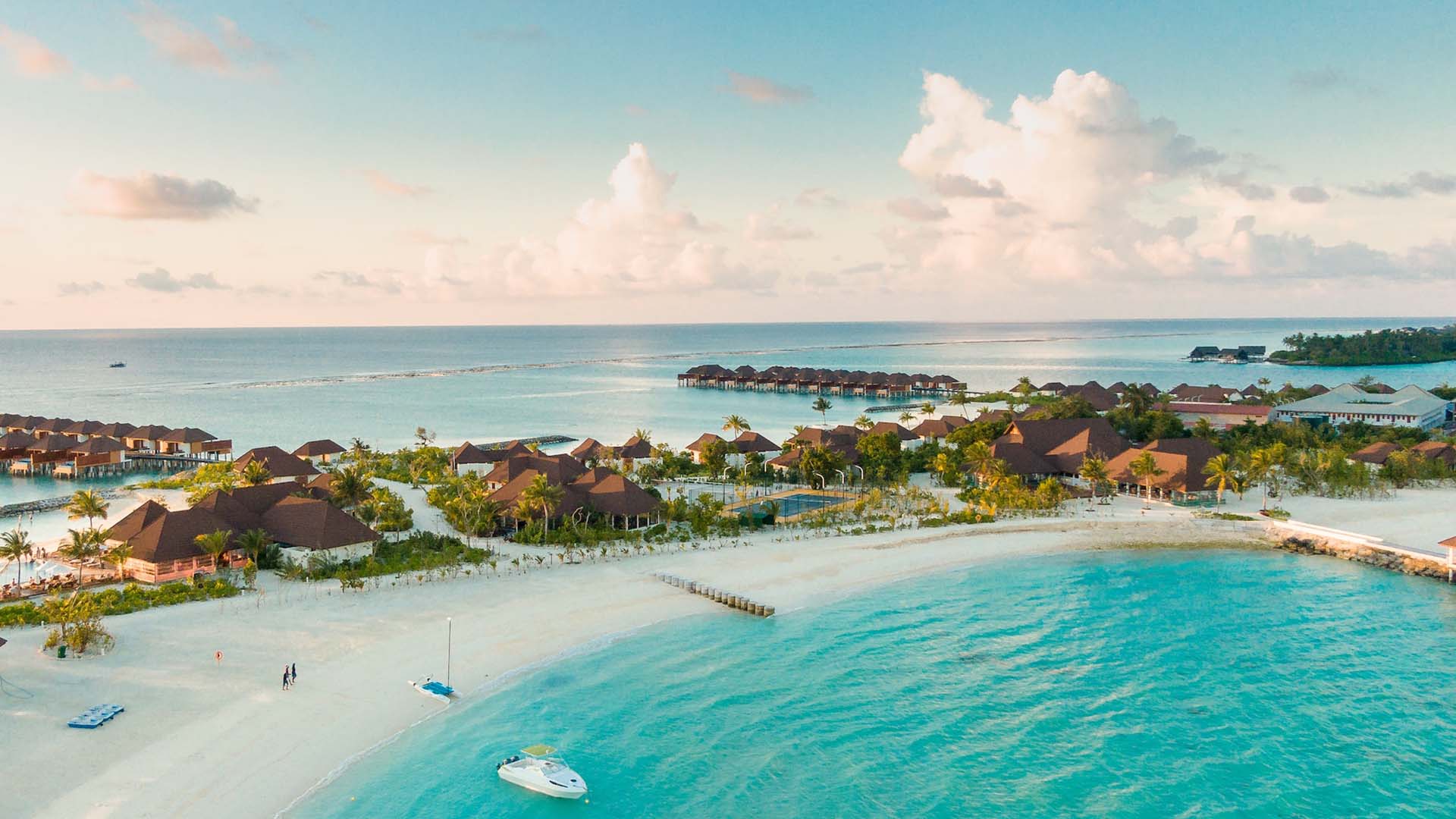
Have you ever thought about how many types of tourism there are in the world? From adventure tourism to medical tourism, the tourism industry offers a wide range of experiences for travelers.
Tourism is a rapidly growing industry, contributing greatly to the global economy . With the rise of globalization and advancements in technology, traveling has become more accessible and affordable for people all around the world.
As a result, the tourism industry has diversified and expanded to cater to the different interests and preferences of travelers.
If you are a travel enthusiast, you might be surprised to know that there are over 40 different types of tourism to choose from. Each type of tourism offers a unique experience, ranging from cultural immersion to extreme sports.
In this article, we will explore the different types of tourism in the world, giving you a glimpse into the vast array of options available to you.
Tourism is a social, cultural and economic phenomenon which entails the movement of people to countries or places outside their usual environment for personal or business/professional purposes.
49 Types of Tourism in the World
The tourism sector is constantly evolving, expanding beyond the basics of domestic, inbound, and outbound tourism.
As travel agencies, it is crucial to stay informed about the diverse range of tourism types to develop effective strategies and fuel the growth of your business. This comprehensive guide presents 62 types of tourism, offering valuable insights and opportunities for your agency to thrive in the dynamic world of travel.
Traditional Forms of Tourism
Leisure tourism.

Leisure tourism encompasses a range of activities that provide relaxation, entertainment, and cultural enrichment to travelers. Let’s explore some popular forms of leisure tourism in more detail:
1. Beach Tourism
Beach tourism revolves around vacations and holidays spent in coastal areas, offering sun, sand, and various recreational activities such as swimming, sunbathing, beach volleyball, and water sports like snorkeling, surfing, and jet skiing.
Beach destinations around the world, such as Bali, Maldives, and the Caribbean, attract millions of tourists seeking relaxation and enjoyment in idyllic seaside settings.
2. Adventure Tourism
Adventure tourism caters to thrill-seeking individuals who seek exciting and adrenaline-pumping experiences. It includes activities like hiking, rock climbing, zip-lining, white-water rafting, paragliding, and bungee jumping in natural and adventurous settings.
Destinations like New Zealand, Costa Rica, and Switzerland offer breathtaking landscapes and thrilling adventure opportunities that attract adventure enthusiasts from across the globe.
3. Cultural Tourism
Cultural tourism focuses on exploring the rich heritage, traditions, and artistic expressions of a destination.
It involves visits to museums, historical sites, cultural festivals, and interactions with local communities to gain insight into their customs, rituals, and way of life. Destinations renowned for their cultural attractions include Rome with its ancient ruins, Kyoto with its traditional temples, and Istanbul with its diverse blend of cultures.
4. Wildlife Tourism
Wildlife tourism centers on observing and experiencing a particular region’s diverse fauna and flora.
It includes activities such as safaris, birdwatching, nature walks, and visits to national parks and wildlife reserves. Destinations like South Africa’s Kruger National Park, the Galapagos Islands in Ecuador, and the Serengeti in Tanzania offer incredible wildlife encounters and opportunities for conservation education.
Business Tourism

Business tourism, also known as MICE tourism (Meetings, Incentives, Conferences, and Exhibitions), caters to individuals traveling for business-related purposes.
Let’s explore some key components of business tourism:
5. Meetings, Incentives, Conferences, and Exhibitions (MICE) Tourism
MICE tourism encompasses corporate meetings, conferences, conventions, trade shows, and exhibitions. It provides a platform for professionals to network, exchange knowledge, showcase products and services, and forge business relationships.
Major cities and convention centers worldwide, such as London, Dubai, and Las Vegas, host numerous MICE events, driving economic growth and fostering industry collaboration.
6. Trade Shows and Conventions
Trade shows and conventions are industry-specific events where businesses exhibit their products or services to potential clients, partners, and investors. These events serve as valuable marketing platforms, allowing companies to showcase their latest innovations, generate leads, and gain industry insights.
Trade shows like CES (Consumer Electronics Show) and Hannover Messe attract businesses from diverse sectors, facilitating business-to-business interactions and promoting industry growth.

7. Corporate Retreats and Team-Building Activities
Corporate retreats and team-building activities aim to foster teamwork, boost employee morale, and enhance organizational productivity. These events often take place in scenic locations, away from the usual office environment, and incorporate team-building exercises, workshops, brainstorming sessions, and recreational activities.
Corporate retreats not only strengthen internal relationships but also provide opportunities for strategic planning, innovation, and professional development.
Niche and Special Interest Tourism

Ecotourism promotes responsible travel practices that focus on preserving and conserving natural environments while providing educational and enriching experiences for travelers.
Let’s delve into some facets of ecotourism:
8. Rainforest Exploration
Rainforest exploration allows travelers to immerse themselves in the lush biodiversity and unique ecosystems of tropical rainforests. Guided hikes, canopy walks, and wildlife spotting tours provide opportunities to witness rare flora and fauna, learn about sustainable conservation efforts, and contribute to local communities.
Destinations like the Amazon Rainforest in South America, Borneo’s rainforests in Southeast Asia, and Costa Rica’s Monteverde Cloud Forest offer captivating rainforest experiences.
9. Wildlife Conservation Tours
Wildlife conservation tours allow travelers to actively participate in conservation initiatives, contributing to the protection of endangered species and their habitats. These tours often involve volunteer work, such as monitoring wildlife, assisting in research projects, and habitat restoration efforts.
Popular wildlife conservation destinations include the Galapagos Islands, where visitors can help preserve unique marine and terrestrial ecosystems, and South Africa’s game reserves, where wildlife conservation programs support endangered species.
10. Sustainable Travel Practices
Sustainable travel practices promote environmentally friendly behaviors, aiming to minimize negative impacts on natural resources, local communities, and cultures. These practices may include reducing carbon footprint, supporting local businesses, respecting local traditions, and engaging in activities that promote environmental stewardship.
Travelers can choose eco-lodges, and eco-friendly transportation options, and participate in community-based tourism initiatives to ensure their travel has a positive impact on the destination.
Wellness Tourism

Wellness tourism focuses on enhancing and rejuvenating one’s well-being through various activities and experiences that prioritize physical, mental, and spiritual health.
Let’s explore some aspects of wellness tourism:
11. Spa Retreats
Spa retreats offer a serene environment where travelers can indulge in relaxation, pampering treatments, and wellness therapies. From soothing massages and rejuvenating facials to holistic healing practices like yoga and meditation, spa retreats provide a sanctuary for rejuvenation and stress relief.
Destinations such as Bali, Thailand, and California’s Napa Valley are renowned for their luxurious and holistic spa retreats.
12. Yoga and Meditation Retreats
Yoga and meditation retreats provide opportunities for individuals to deepen their mindfulness and spiritual practices in tranquil and picturesque settings. These retreats often combine daily yoga sessions, meditation practices, healthy cuisine, and workshops focused on personal growth and self-awareness.
Destinations like Rishikesh in India, Ubud in Bali, and Sedona in the United States are renowned for their yoga and meditation retreats.
13. Health and Wellness Resorts
Health and wellness resorts offer comprehensive programs designed to improve physical fitness, promote healthy lifestyles, and provide personalized wellness experiences. These resorts may offer fitness classes, nutritional guidance, spa treatments, wellness consultations, and activities like hiking, yoga, and mindfulness workshops.
Wellness-focused destinations such as Switzerland’s renowned Swiss Alps resorts, Thailand’s wellness retreats, and the wellness resorts in Arizona’s Sonoran Desert cater to those seeking a holistic approach to well-being.
Culinary Tourism

Culinary tourism revolves around the exploration and appreciation of a destination’s cuisine, culinary traditions, and gastronomic experiences. Let’s discover the different aspects of culinary tourism:
14. Food and Wine Tours
Food and wine tours allow travelers to savor the local flavors, taste traditional dishes, and indulge in culinary delights unique to a particular region. These tours often include visits to local markets, food tastings, cooking demonstrations, and wine tastings at vineyards.
Destinations like Italy’s Tuscany, France’s Bordeaux region, and Japan’s Kyoto are renowned for their culinary heritage and offer exceptional food and wine tours.
15. Cooking Classes and Culinary Experiences
Cooking classes and culinary experiences provide hands-on opportunities for travelers to learn about the local cuisine, traditional cooking techniques, and regional specialties. Under the guidance of expert chefs or local home cooks, participants can prepare and savor authentic dishes, gaining insights into the culinary culture of the destination.
Cities like Bangkok, Marrakech, and Barcelona are known for their immersive cooking classes and culinary workshops.
16. Farm-to-Table and Gastronomic Experiences
Farm-to-table experiences involve visits to local farms, orchards, and vineyards to witness the production process of fresh, organic ingredients. Gastronomic experiences encompass fine dining at renowned restaurants, tasting menus curated by celebrity chefs, and exploring local street food scenes.
Destinations like California’s Napa Valley, France’s Lyon, and Thailand’s Chiang Mai provide exceptional farm-to-table and gastronomic experiences.
Adventure and Outdoor Tourism
Mountain tourism.

Mountain tourism attracts adventurous travelers seeking exhilarating experiences in breathtaking alpine landscapes. Here are some popular activities within mountain tourism:
17. Hiking and Trekking
Hiking and trekking adventures take travelers through scenic mountain trails, allowing them to explore the pristine wilderness, enjoy stunning vistas, and challenge themselves physically.
Destinations like the Himalayas in Nepal, the Swiss Alps, and the Rocky Mountains in North America offer a range of hiking and trekking opportunities suitable for different skill levels.
18. Mountaineering and Rock Climbing
Mountaineering and rock climbing appeal to those with a passion for conquering towering peaks and vertical rock formations.
From scaling iconic summits like Mount Everest and Mount Kilimanjaro to rock climbing in Yosemite National Park or the Dolomites, these activities offer a thrilling combination of physical endurance, technical skill, and awe-inspiring natural surroundings.
19. Skiing and Snowboarding
Skiing and snowboarding attract winter sports enthusiasts who enjoy gliding down snow-covered slopes and experiencing the adrenaline rush of downhill descents.
Popular ski destinations include Aspen in the United States, Whistler Blackcomb in Canada, and the Swiss Alps, where skiers and snowboarders can enjoy diverse terrains, world-class facilities, and picturesque mountain landscapes.
Water Tourism

Water tourism encompasses a wide range of activities centered around bodies of water, including oceans, lakes, rivers, and coastal areas. Let’s explore some popular water-based tourism experiences:
20. Scuba Diving and Snorkeling
Scuba diving and snorkeling allow travelers to explore vibrant underwater ecosystems, encounter marine life, and marvel at coral reefs.
Destinations like the Great Barrier Reef in Australia, the Maldives, and the Red Sea in Egypt are renowned for their exceptional diving and snorkeling sites, offering opportunities to witness the beauty and biodiversity of the marine world.
21. Surfing and Water Sports
Surfing and water sports, such as paddleboarding, kayaking, and windsurfing, cater to adrenaline seekers looking to ride the waves and engage with the power of the ocean. Destinations like Hawaii’s North Shore, Bali’s Uluwatu, and California’s Huntington Beach are renowned for their world-class surf breaks and water sports scenes.
22. Sailing and Yachting
Sailing and yachting experiences provide a luxurious and leisurely way to explore coastal regions, island hopping, and cruise along scenic coastlines. Chartering a yacht or joining a sailing excursion offers the opportunity to relax, soak in breathtaking seascapes, and visit remote islands and hidden coves.
Destinations like the Greek Islands, the Caribbean, and the French Riviera are popular sailing and yachting destinations.
Wildlife Tourism

Wildlife tourism appeals to nature enthusiasts and animal lovers who seek encounters with diverse wildlife species in their natural habitats.
Here are some popular wildlife tourism experiences:
23. Safari and Wildlife Photography
Safari adventures take travelers into national parks and game reserves, providing opportunities to spot iconic wildlife species like lions, elephants, giraffes, and zebras. Wildlife photography enthusiasts can capture stunning images of animals in their natural environment.
Destinations like Botswana’s Okavango Delta, Tanzania’s Serengeti National Park, South Africa’s Kruger National Park, and India’s Ranthambore National Park offer exceptional safari and wildlife photography experiences.
24. Birdwatching and Nature Reserves
Birdwatching enthusiasts flock to nature reserves and sanctuaries known for their rich avian biodiversity. These destinations offer opportunities to observe and identify a wide array of bird species in their natural habitats.
Places like Costa Rica’s Monteverde Cloud Forest Reserve, Australia’s Kakadu National Park, and Ecuador’s Galapagos Islands are renowned for their birdwatching opportunities.
25. Whale Watching and Marine Wildlife Tours
Whale-watching tours provide an up-close and personal experience with these magnificent marine creatures. Travelers can observe whales breaching, swimming, and interacting in their natural habitat.
Destinations such as Iceland, Canada’s Vancouver Island, and the Azores in Portugal are popular for whale watching and marine wildlife tours.
Cultural and Heritage Tourism
Historical tourism.

Historical tourism appeals to individuals interested in exploring the rich heritage and significant historical sites around the world. It provides insights into past civilizations, events, and cultural traditions.
Here are some key aspects of historical tourism:
26. Archaeological Sites and Ruins
Archaeological sites and ruins offer a glimpse into ancient civilizations and their architectural marvels.
Places like the Colosseum in Rome, Machu Picchu in Peru, and Angkor Wat in Cambodia attract history enthusiasts who are fascinated by the remnants of past civilizations and the stories they hold.
27. UNESCO World Heritage Sites
UNESCO World Heritage Sites are culturally or naturally significant locations recognized for their outstanding universal value. These sites range from iconic landmarks like the Taj Mahal in India to entire historical city centers like Prague in the Czech Republic.
Visiting UNESCO World Heritage Sites allows travelers to appreciate the world’s cultural diversity and historical importance.
28. Historical Landmarks and Monuments
Historical landmarks and monuments symbolize key moments in history or commemorate notable figures or events. Examples include the Statue of Liberty in the United States, the Great Wall of China, and the Pyramids of Giza in Egypt.
Exploring these landmarks provides a deeper understanding of their historical significance and their impact on society.
Religious Tourism

Religious tourism caters to individuals seeking spiritual experiences, pilgrimages, or a connection with sacred sites. It offers insights into different religious traditions and the architectural wonders associated with them.
Here are some facets of religious tourism:
29. Pilgrimages and Sacred Sites
Pilgrimages involve journeys to sacred destinations associated with specific religions or spiritual beliefs. Places like Mecca for Muslims, Jerusalem for Christians, and Varanasi for Hindus hold immense religious significance and attract millions of pilgrims each year.
30. Spiritual Retreats and Meditation Centers
Spiritual retreats and meditation centers offer tranquil environments for introspection, relaxation, and spiritual growth. These retreats focus on mindfulness, meditation practices, and holistic healing.
Popular destinations for spiritual retreats include Bali in Indonesia, Sedona in the United States, and Rishikesh in India.
31. Religious Festivals and Events
Religious festivals and events provide a vibrant and immersive experience of cultural traditions and religious celebrations. Examples include the Kumbh Mela in India, the Holi festival of colors, and the Christmas celebrations in various parts of the world.
Participating in these festivals offers a unique glimpse into local customs, rituals, and the spirit of the community.
Indigenous Tourism

Indigenous tourism aims to promote understanding, appreciation, and respect for indigenous cultures, traditions, and ways of life. It provides opportunities to engage with indigenous communities and learn about their heritage.
Here are elements of indigenous tourism:
32. Indigenous Cultural Experiences
Indigenous cultural experiences allow travelers to interact with indigenous communities, learn about their traditions, crafts, music, and storytelling. These experiences foster cultural exchange and promote the preservation of indigenous heritage.
Destinations like the Maori culture in New Zealand, the Aboriginal culture in Australia, and the Native American reservations in the United States offer such immersive experiences.
33. Tribal Village Visits
Visiting tribal villages allows travelers to observe and learn about the traditional lifestyles, customs, and rituals of indigenous communities. It provides insights into their sustainable practices, craftsmanship, and deep-rooted connections with nature.
Destinations such as the Amazon rainforest, the Maasai Mara in Kenya, and the Highlands of Papua New Guinea offer opportunities to visit tribal communities.
34. Traditional Arts and Crafts
Indigenous cultures often have a rich tradition of art, crafts, and handicrafts that reflect their unique identity and skills. Exploring indigenous arts and crafts markets, workshops, and galleries allows travelers to appreciate and support the preservation of these traditional artistic practices.
From intricate weaving in Peru to intricate beadwork in South Africa, there is a vast array of indigenous art to discover.
Urban Tourism

City Tourism
City tourism encompasses visits to vibrant urban destinations, exploring their iconic landmarks, cultural attractions, and modern lifestyle. It offers a blend of history, art, entertainment, and culinary experiences.
Key aspects of city tourism include:
35. Sightseeing and Iconic Landmarks
Cities are known for their iconic landmarks, such as the Eiffel Tower in Paris, the Statue of Liberty in New York City, and the Sydney Opera House. Sightseeing allows visitors to capture the essence of a city’s character and architectural splendor.
36. Museums and Art Galleries
Cities are often home to renowned museums and art galleries that showcase world-class collections, historical artifacts, and contemporary artworks.
The Louvre Museum in Paris, the Metropolitan Museum of Art in New York City, and the Hermitage Museum in Saint Petersburg are just a few examples of the cultural treasures found in urban areas.
37. Shopping and Entertainment Districts
Urban centers offer diverse shopping experiences, from luxury boutiques to bustling street markets. Additionally, cities provide vibrant entertainment districts with theaters, music venues, and nightlife hotspots.
These districts cater to a variety of interests, ensuring that visitors can indulge in shopping, dining, and entertainment.
Architectural Tourism

Architectural tourism focuses on exploring unique architectural styles, landmarks, and urban design within cities. It allows travelers to appreciate the creativity, innovation, and historical significance of various structures.
Key elements of architectural tourism include:
38. Architectural Marvels and Landmarks
Cities showcase architectural marvels, such as the Burj Khalifa in Dubai, the Sydney Opera House, and the Guggenheim Museum in Bilbao. These structures captivate visitors with their impressive design, engineering, and cultural impact.
39. Modern and Contemporary Architecture Tours
Urban areas often feature striking modern and contemporary architecture that reflects the city’s identity and vision. Walking tours or guided visits to architectural highlights, such as the Shard in London, the Marina Bay Sands in Singapore, or the Dancing House in Prague, offer insights into cutting-edge design and urban development.
40. Urban Design and City Planning
City tourism also encompasses exploring the urban design, layout, and city planning concepts that shape the physical environment. Sustainable urban planning, pedestrian-friendly streets, and green spaces contribute to the livability and attractiveness of cities.
Examples of urban design excellence can be found in cities like Copenhagen, Singapore, and Barcelona.
Emerging Forms of Tour

Dark Tourism
Dark tourism refers to visiting sites that are associated with death, tragedy, or historical atrocities. It offers a unique perspective on the darker aspects of human history. While it may seem unusual, dark tourism has gained popularity in recent years.
Here are some examples of dark tourism:
41. War Memorials and Battlefields
Visiting war memorials and battlefields provides insights into the sacrifices made during significant conflicts. Examples include the Normandy American Cemetery and Memorial in France and the Hiroshima Peace Memorial Park in Japan.
These sites allow visitors to reflect on the consequences of war and honor those who lost their lives.
42. Holocaust and Genocide Sites
Holocaust and genocide sites, such as Auschwitz-Birkenau in Poland and the Killing Fields in Cambodia, serve as reminders of the darkest chapters in human history.
These places educate visitors about the horrors of genocide and the importance of promoting peace and tolerance.
43. Disaster Tourism
Disaster tourism involves visiting locations affected by natural or man-made disasters. Examples include areas hit by hurricanes, volcanic eruptions, or industrial accidents.
While controversial, this form of tourism can raise awareness about the impact of disasters and the resilience of affected communities.
Space Tourism

Space tourism is an emerging frontier in the travel industry, allowing individuals to experience the thrill of space travel and explore the mysteries of the universe. While it is currently limited to a select few, advancements in technology and space exploration are making it more accessible.
Key aspects of space tourism include:
44. Space Travel and Exploration
Space tourism involves journeys beyond the Earth’s atmosphere, offering a unique perspective of our planet and the vastness of space. Companies like Virgin Galactic and SpaceX are developing spacecraft to transport civilians into space, opening up new possibilities for adventurous travelers.
45. Astronaut Training Experiences
Before embarking on a space journey, aspiring space tourists can undergo astronaut training experiences. These programs simulate the physical and mental challenges faced by astronauts, including zero-gravity simulations, centrifuge training, and survival skills.
46. Observatories and Space Centers
Visiting observatories and space centers allows enthusiasts to learn about astronomy, space missions, and ongoing research. Places like the Kennedy Space Center in Florida and the European Space Agency’s Spaceport in French Guiana offer interactive exhibits, rocket launches, and behind-the-scenes glimpses into space exploration.
Virtual Tourism

Virtual tourism has emerged as a response to the limitations of physical travel, allowing individuals to explore destinations and landmarks virtually. It offers a convenient and immersive way to experience different places from the comfort of one’s home. Key aspects of virtual tourism include:
47. Virtual Reality Travel Experiences
Virtual reality (VR) technology allows users to immerse themselves in simulated environments, including famous landmarks, natural wonders, and cultural sites. VR headsets transport users to different locations, providing a realistic and interactive experience.
48. Online Museum and Landmark Tours
Many museums, historical sites, and landmarks offer virtual tours that enable visitors to explore their collections and exhibits online. These tours provide detailed information, multimedia content, and the ability to navigate through the spaces virtually.
49. Virtual Travel Platforms and Apps
Various platforms and apps offer virtual travel experiences, curated itineraries, and interactive content. These platforms leverage technology to create virtual travel communities, where users can connect, share experiences, and plan future trips.
As the travel industry evolves, embracing these emerging forms of tourism can open up new opportunities for businesses and provide unique experiences for travelers.
In conclusion, the tourism industry is a dynamic and ever-evolving sector that encompasses a wide range of experiences and opportunities. By understanding the diverse types of tourism in the world, business professionals can position themselves for success and growth in this competitive landscape.
By recognizing the unique characteristics and preferences of different traveler segments, businesses can tailor their offerings and marketing strategies to meet the specific needs of their target audiences. This not only enhances customer satisfaction but also helps in creating a competitive advantage in the market.
Moreover, as the world becomes increasingly interconnected and travelers seek authentic and immersive experiences, businesses must embrace the diversity of tourism segments. By incorporating sustainable practices, respecting local cultures, and promoting responsible tourism, businesses can contribute to the preservation of natural and cultural heritage, while also appealing to environmentally and socially conscious travelers.
Let us embrace the diversity of tourism, foster innovation, and collaborate to shape the future of this exciting industry.
- United Nations World Tourism Organization
- World Travel and Tourism Council
- International Ecotourism Society
- Global Wellness Institute
- International Culinary Tourism Association
- Adventure Travel Trade Association
- UNESCO World Heritage Centre
- The International Dark-Sky Association
- Space Tourism Society
- World Tourism Organization
- National Geographic Travel
- International Association of Antarctica Tour Operators
- World Food Travel Association
- Beach Holidays by Expedia
Tumisang Bogwasi
2X Award-Winning Entrepreneur | Empowering Brands to Generate Leads, Grow Revenue with Business Strategy and Digital Marketing | Founder, CEO of Fine Group
Related Posts

The Importance of Tourism on Economies and Businesses
- April 6, 2023
Trending now


GoldenIslandSenorita.Net
A Travel & Lifestyle Blog
Exploring the 7 Common Types of Tourist Attractions: From Natural Wonders to Cultural Gems

Tourism, as an industry, has evolved significantly over the years, and today, it stands as one of the world’s largest economic sectors. The global wanderlust continues to grow, with travelers seeking diverse experiences that cater to their unique interests and passions. In this pursuit, the world offers an astonishing array of tourist attractions, each designed to captivate, educate, and inspire visitors.
Tourist attractions can be categorized in various ways based on their characteristics and appeal. Here are some common types of tourist attractions, arranged by category or type:

1. Natural Attractions:
Are geographical features, landscapes, and phenomena found in the natural environment that are considered remarkable, captivating, or beautiful. These attractions are typically unaltered by human intervention and often draw visitors due to their inherent scenic or geological value. Natural attractions can encompass a wide range of features and experiences in the natural world, including:
- National Parks: Protected areas with unique landscapes, flora, and fauna.
- Beaches : Coastal areas with sandy shores, water sports, and scenic views.
- Mountains: High-altitude destinations for hiking, skiing, and mountaineering.
- Waterfalls: Natural cascades of water that are often visually stunning.
- Caves: Underground formations with stalactites, stalagmites, and unique geology.
- Lakes: Scenic bodies of water offering boating, fishing, and relaxation.
- Forests and Jungles: Dense greenery and wildlife-rich ecosystems.

2. Cultural Attractions:
Places, events, and experiences that showcase the cultural heritage, traditions, and artistic expressions of a particular region, community, or group of people. These attractions are intended to educate, entertain, and provide insight into the customs, history, arts, and values of a specific culture or cultural group. Cultural attractions can take various forms and may include the following:
- Museums: Institutions housing art, history, science, and cultural artifacts.
- Historical Sites: Locations of significant past events or architectural importance.
- Art Galleries: Spaces showcasing visual arts, paintings, and sculptures.
- Theaters and Performing Arts Centers: Venues for live music, theater, and dance.
- Religious Sites: Churches, temples, mosques, and other places of worship.
- Heritage Villages: Preserved towns or villages showcasing local traditions.
- Monuments and Memorials: Structures commemorating historical figures or events.

3. Urban Attractions:
Refer to points of interest, activities, and destinations located within cities and urban areas that draw visitors due to their cultural, entertainment, historical, or recreational significance. These attractions are typically found in bustling urban environments and offer a wide range of experiences and opportunities for exploration.
- Skyscrapers: Tall buildings offering panoramic views of the city.
- City Parks: Green spaces for picnics, recreation, and relaxation.
- Zoos and Aquariums: Facilities showcasing animals and marine life.
- Shopping Districts: Areas known for boutique shops and markets.
- Entertainment Complexes: Theme parks, casinos, and entertainment hubs.
- Food and Dining: Restaurants, street food, and culinary experiences.
- Nightlife: Bars, clubs, and music venues for evening entertainment.

4. Adventure and Outdoor Attractions:
Destinations, activities, and experiences that take place in natural or outdoor environments and are characterized by excitement, physical challenge, and a sense of exploration. These attractions are designed to provide individuals with thrilling and adventurous experiences in settings such as mountains, forests, rivers, and other natural landscapes. They often involve outdoor activities that require physical effort, skill, and a spirit of adventure.
- Adventure Sports: Destinations for activities like rafting, paragliding, and zip-lining.
- Wildlife Safaris: Guided tours to observe wild animals in their natural habitat.
- Scenic Drives: Routes with breathtaking views and picturesque landscapes.
- Hiking and Trekking Trails: Paths for outdoor enthusiasts and nature lovers.
- Camping Sites: Places for outdoor camping and stargazing.
- Ski Resorts: Winter sports destinations with skiing and snowboarding.

5. Educational Attractions:
Places or experiences specifically designed to provide educational value and knowledge to visitors. These attractions aim to inform, engage, and inspire individuals by offering opportunities for learning, exploration, and enrichment. Educational attractions often cover a wide range of topics, including science, history, culture, art, and more. They are intended to be both entertaining and informative, making the learning process enjoyable and engaging for people of all ages.
- Science Centers: Interactive exhibits on science and technology.
- Planetariums: Facilities for astronomy and space exploration education.
- Botanical Gardens: Gardens featuring diverse plant species.
- Educational Tours: Guided tours to learn about local history or industries.
- Culinary Classes: Workshops and cooking classes for food enthusiasts.
- Language and Culture Centers: Places to learn about local languages and traditions.

6. Relaxation and Wellness Attractions:
Refers to places or experiences where individuals can unwind, rejuvenate, and focus on their physical and mental well-being. These attractions are designed to promote relaxation, reduce stress, and enhance overall wellness:
- Spas and Wellness Centers: Facilities for relaxation and rejuvenation.
- Hot Springs: Natural geothermal pools with therapeutic properties.
- Meditation Retreats: Centers for meditation and mindfulness practices.
- Yoga Retreats: Locations for yoga, meditation, and holistic wellness.

7. Special Events
A type of action or activity that involves the planning, organization, and execution of unique and noteworthy occasions. These events are typically designed to provide a memorable experience for participants and attendees. Special events often have a specific purpose or theme, and they can take various forms. Here are some examples of special events:
- Concerts and Music Festivals: Live music performances by renowned artists or festivals that showcase a variety of musical genres, attracting music enthusiasts from all over.
- Sports Events: Major sporting competitions such as the Olympic Games, FIFA World Cup, Super Bowl, and local tournaments that draw fans and athletes alike.
- Cultural Festivals: Celebrations of cultural heritage, such as Diwali festivals, Chinese New Year parades, or Mardi Gras celebrations.
- Exhibitions and Trade Shows: Events where businesses and organizations showcase their products, services, and innovations to potential customers or partners.
- Fashion Shows: Runway presentations of the latest clothing and fashion trends by designers, often during Fashion Weeks in cities like Paris, Milan, and New York.
- Film Festivals: Events that screen a selection of films, often featuring premieres and discussions with filmmakers, like the Cannes Film Festival or Sundance Film Festival.
- Charity Galas: Fundraising events that combine entertainment and philanthropy, often attended by celebrities and high-profile donors.
- Weddings: Special ceremonies and celebrations uniting couples in marriage, often personalized to reflect the couple’s preferences and cultural traditions.
- Awards Shows: Ceremonies that recognize achievements in various fields, such as the Academy Awards (Oscars) for the film industry or the Grammy Awards for music.
- Political Rallies and Campaign Events: Gatherings organized to support political candidates or causes, featuring speeches, rallies, and interactions with politicians.
- Parades: Processions celebrating holidays, cultural pride, or specific events, such as Thanksgiving parades, St. Patrick’s Day parades, or Pride parades.
- Theme Park Events: Special events within theme parks, like Halloween Horror Nights at Universal Studios or seasonal celebrations at Disney parks.
- Food and Wine Festivals: Events showcasing culinary delights and beverages from a specific region or cuisine, such as the Taste of Chicago or the Bordeaux Wine Festival.
- Art and Craft Fairs: Gatherings where artists and artisans display and sell their work, often featuring live demonstrations and interactive experiences.
- Conference and Summit Events: Meetings and gatherings of professionals, experts, and enthusiasts focused on specific industries, topics, or fields, such as technology conferences or climate change summits.
As you plan your next adventure or seek inspiration for your travels, remember the myriad options that await. Whether it’s the serene beauty of natural landscapes, the richness of cultural heritage, the excitement of urban life, the thrill of outdoor escapades, or the pursuit of personal well-being, the world offers something for everyone.
So, whether you’re embarking on a grand journey or exploring your local surroundings, let the diverse spectrum of tourist attractions be your guide. Each one has a story to tell, a lesson to teach, and an adventure to offer. Embrace the opportunity to discover, learn, and create lasting memories in the world’s most captivating destinations.
As you embark on your next adventure, keep these insights in mind, and may your travels be filled with wonder, discovery, and the joy of exploration. Safe travels!”
Related Posts
Polly Amora
Polly Amora is the señorita behind GoldenIslandSenorita.Net. A corporate warrior by day, and a perpetual explorer by heart. She is a lifelong learner who is very outgoing, speaks four languages, loud & outspoken, and loves to have adventures in the mountains, on the beach, and in the city. You can throw her anywhere, and she'll handle it like a pro. Ice cream and bourbon are two of her weaknesses.
Leave a Reply Cancel reply
Your email address will not be published. Required fields are marked *
Save my name, email, and website in this browser for the next time I comment.
Notify me of follow-up comments by email.
Notify me of new posts by email.

28 Top-Rated Tourist Attractions in the World
Written by Lana Law Updated Jan 12, 2024
Travelers are always looking for inspiration to guide their adventures. Coming up with a list of places to visit can be challenging when you're staring at a globe. What are the top tourist attractions in the world? The most iconic sites that all travelers have on their bucket-list of things to see around the globe?
Some destinations just stand out above the rest. Many are the type of places where you can take a photo, and it requires no explanation to identify the location: the Eiffel Tower or the Colosseum. But some places are less well known to new travelers or those who have not yet ventured out to the more exotic destinations. These can often be the most rewarding to visit.
For many of these attractions, it's what they symbolize and the destinations they represent that make them so significant. In other cases, it is the site itself that makes it worth visiting the country. Some of these are the more popular UNESCO World Heritage sites .
If you're looking to start your own checklist of places to visit during your life, begin with our list of the top tourist attractions in the world.
1. Eiffel Tower, Paris
2. the colosseum, rome, 3. statue of liberty, new york city, 4. machu picchu, peru, 5. the acropolis, athens, 6. the taj mahal, india, 7. pyramids of giza, egypt, 8. great wall of china, 9. angkor wat, cambodia, 10. petra, jordan, 11. grand canyon, usa, 12. stonehenge, england, 13. borobudur, indonesia, 14. niagara falls, canada & usa, 15. bagan, myanmar, 16. sydney opera house, 17. mount kilimanjaro, 18. the louvre, paris, 19. forbidden city, china, 20. prague castle, czech republic, 21. chichen itza, mexico, 22. corcovado and cristo redentor, rio de janeiro, 23. château de versailles, france, 24. mount fuji, 25. central park, new york city, 26. alhambra, spain, 27. buckingham palace, london, 28. ubud, bali, indonesia.
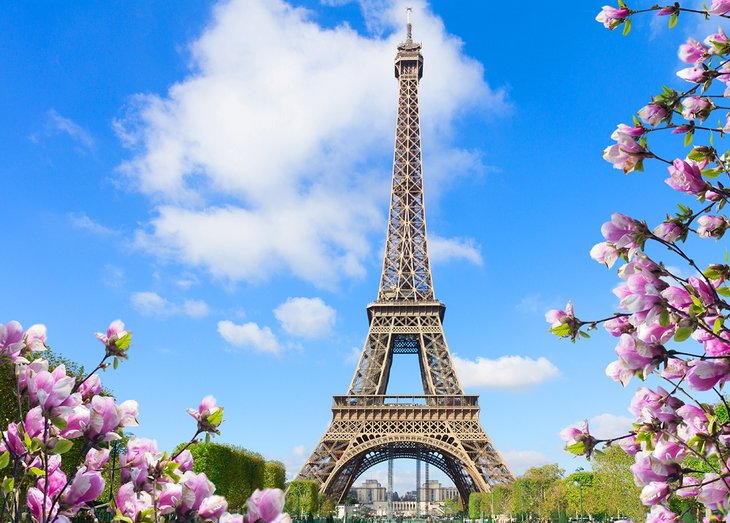
The symbol of Paris and one of the most photographed structures in the world, a visit to the Eiffel Tower is a must for all travelers. Few landmarks inspire such a passion for travel as this single iron structure.
Young travelers heading out on the road for the first time, couples looking for a special getaway, artists looking to spur their creativity, and romantics of all types are all drawn to Paris. This is a city where history and culture collide and where travelers of all kinds can find the experience they're after.
Head up the tower for spectacular views over the city, and don't miss a chance to see the tower lit up at night.
Read More: Top-Rated Tourist Attractions in Paris
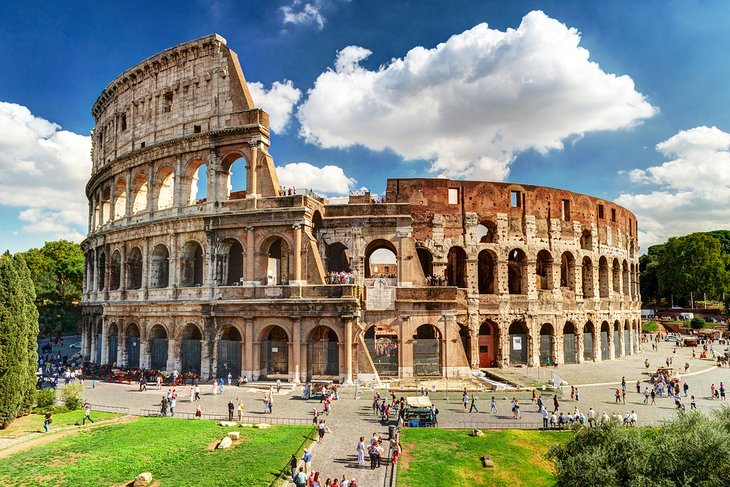
The most famous and largest structure still standing from the Roman Empire, the Colosseum is also the biggest attraction of modern-day Rome . It's been a bucket-list destination of travelers for generations. And it does not disappoint.
Set in the heart of the city, the Colosseum is an easy place to visit. Direct flights from around the world land in Rome daily, making it a destination you can visit in a weekend if you choose. Wander through Rome's ancient streets, tour the colosseum, and if time allows, plan a trip to other areas of Italy .
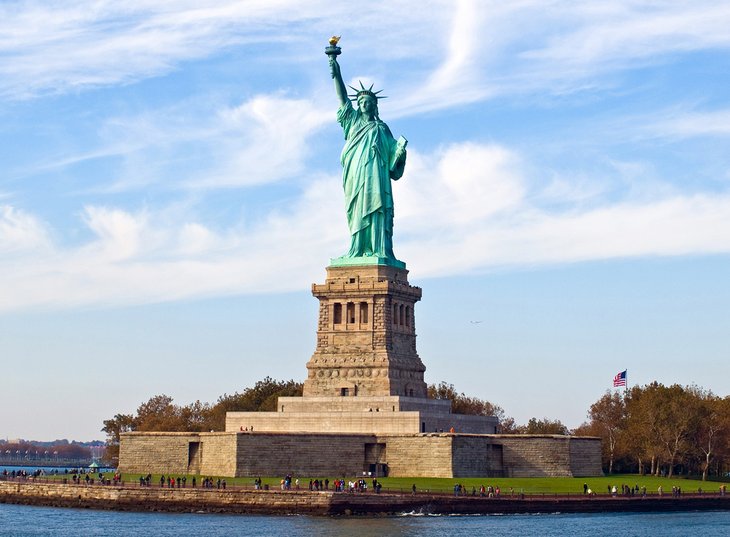
America is full of great sights and places to visit , but it's the Statue of Liberty that represents the United States like no other place. This symbol of freedom in New York City was gifted by the French to the American people in 1896.
Of all the attractions in New York City , this is one every tourist must see. The best thing to do at the Statue of Liberty is to take a ride up to her crown and soak up the view over the city. Access to the statue is via ferry, also a highlight of a visit.
If you don't have time for a tour, you can still see the statue without leaving Manhattan. Head to Battery Park for the best views. You can also see the Statue of Liberty on a free ride on the Staten Island Ferry. See our guide to touring New York City by water on the NYC Ferry System .
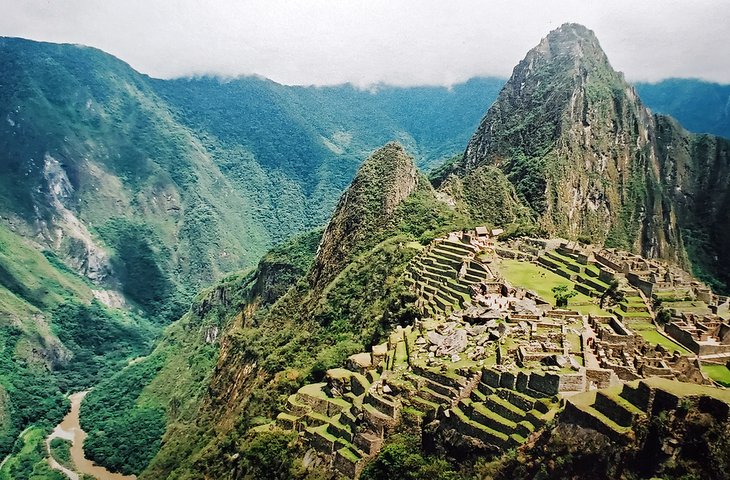
If you are planning to see only one attraction in South America, this is the place to come. The ancient Inca city of Machu Picchu is arguably the most impressive ruined city in the world.
Much of the attraction comes from its location, high in the jungle-clad mountains of Peru. Set on a high plateau with soaring green mountains, the setting is surreal. The sheer tenacity of the original builders to create this amazing place in what would have been impenetrable jungle, is, in itself, impressive.
Visitor numbers are now limited to a maximum per day, so the experience has been greatly enhanced.
- Read More: Top-Rated Tourist Attractions in Peru
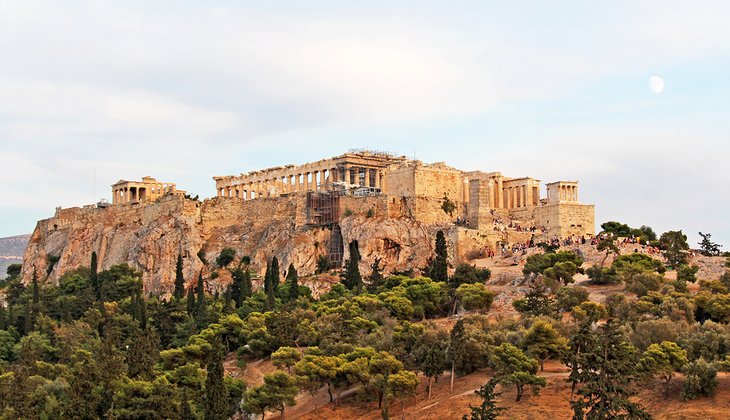
Perched above present day Athens , the Acropolis draws you up and in. Follow in the footsteps of the ancients as you walk up the same steps that have been walked on since 438 BC - 2,500 years.
Views out over the city are incredible as you walk between the meticulously restored ancient buildings. Near the end of the day, you'll want to linger and watch the sunset from the stairs near the entrance. This is a nightly ritual in Athens.
The site is also impressive looking up at it from the city below. Spend an evening dining on a rooftop patio to soak in the view of the hilltop ruins lit up at night.
Read More: Visiting the Acropolis in Athens: The Essential Guide
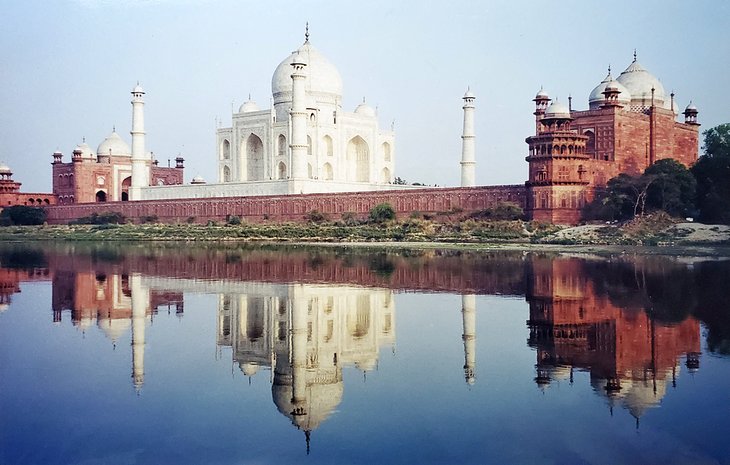
The Taj Mahal is the one sight in India that all travelers need to see. The country is filled with incredible cities and fabulous places to visit, but the 17th-century Taj Mahal in Agra is the one place that says you've been to India.
This mausoleum, commissioned by the Shah Jahan for his wife, Mumtaz Mahal, is known internationally as a symbol of love. This fantastic structure, made with inlaid precious and semi-precious stones, has to be visited to be fully appreciated.
Its riverfront setting, surrounding gardens, and reflecting pools are also what make the Taj Mahal so special.
- Read More: Top-Rated Tourist Attractions in India

If you've visited places like the Colosseum in Rome or the Acropolis in Athens, built over 2,000 years ago, you may think you have a good handle on ancient sites. But the Pyramids of Giza take ancient to a whole other level. These were built over 4,500 years ago. Tourists were coming to see these magnificent structures literally thousands of years ago.
Located just outside Cairo , the pyramids, which is also where you'll find the Sphinx, are easy to get to, and tours are easy to arrange. A sunset camel ride around the structures is a wonderful experience.
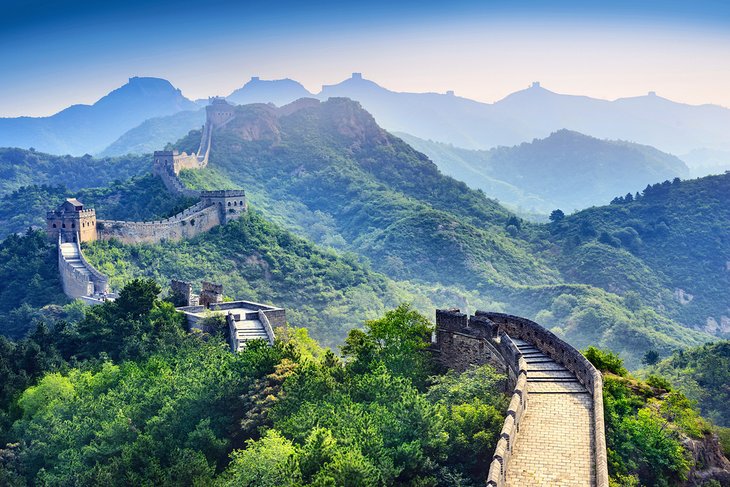
In a land of modern cities and towering skyscrapers, the Great Wall of China, built between the 14th and 17th centuries, is a stark contrast but a striking image that all visitors to China should see.
A stroll along the top of the wall provides an incredible view of the structure snaking off into the distance. The wall stretches an astounding 21,196 kilometers, through some remote areas.
Many travelers seeing the sights of China choose to visit the wall on easily organized tours from Beijing, a relatively short motorcoach ride away.
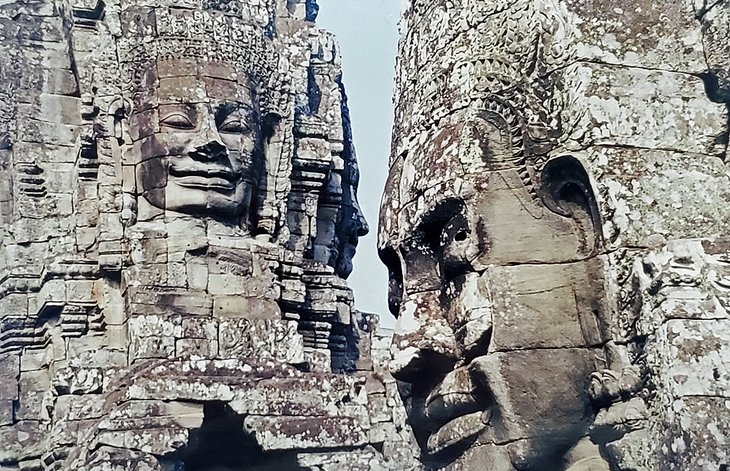
Surrounded by jungle and, in some cases, overgrown with huge trees and roots, the ancient structures of the Angkor complex may look like a movie set to some visitors.
Wandering through Angkor Wat, the main centerpiece of the complex, it's easy to feel like you've entered another era. This is without a doubt, one of the most impressive sites in Southeast Asia and the main reason many people visit Cambodia .
The stone faces peering out over the buildings and gates are images that you won't soon forget.
Angkor Wat is located just outside the city of Siem Reap, a popular tourist center in Cambodia.
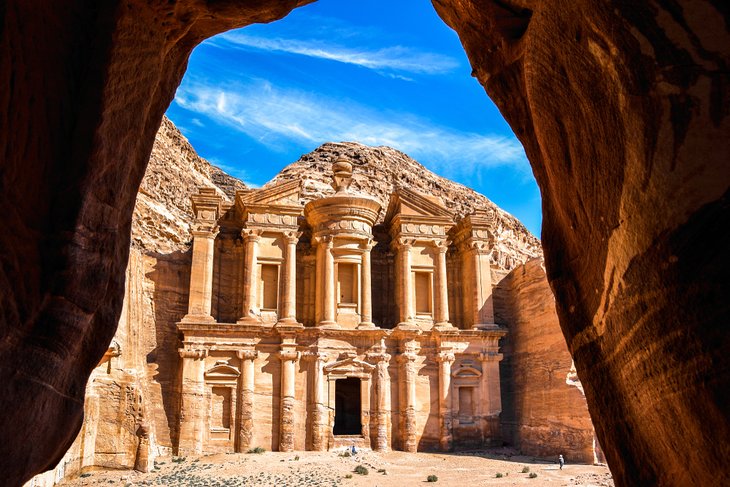
You may have an Indiana Jones feeling as you walk through a 1.2-kilometer-long narrow crack in the sandstone hills and emerge into a hidden city. First built over 2,000 years ago and lost to the outside world for 600 years, the city was only discovered in 1812.
Stunning buildings are carved directly into the red rock walls and are wonderfully preserved, just begging to be explored and photographed.
If you arrive early, an eerie silence, coupled with long shadows, give this abandoned city a special feel.
- Read More: Top-Rated Tourist Attractions in Jordan
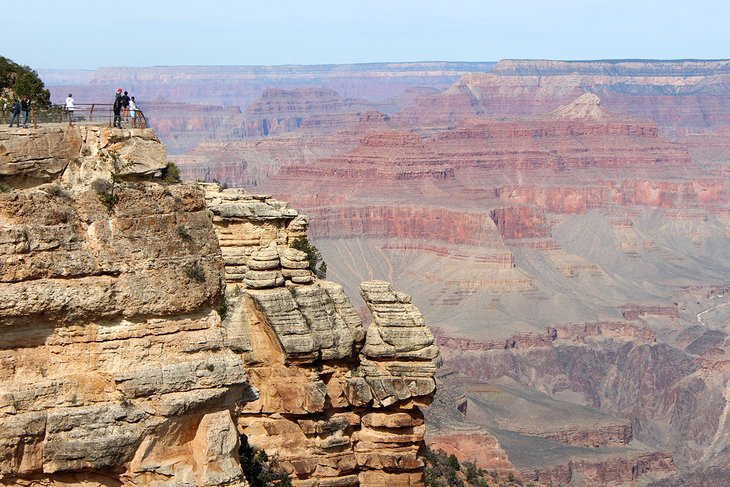
The greatest natural attraction in the United States, the Grand Canyon is a key sight for all travelers planning their lifetime of adventures. Standing on the rim of the Grand Canyon, looking out over the carved landscape, will awaken your senses.
Several hikes in the canyon and along the rim offer unique perspectives. Walk even a short distance down the Bright Angel trail to gain additional views and to experience what the canyon is like below the rim.
For even more adventure plan a rafting trip down the Colorado River through the canyon.
The Grand Canyon looks different throughout the day and at different times of the year. One trip is never enough. If you are going to add this place to your to-see list, consider what you want to do here to determine the best time to visit.
Read More: Top Attractions at the Grand Canyon
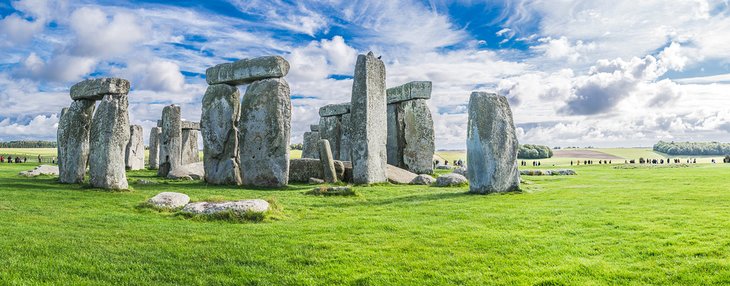
Stonehenge is one of those places that makes you ponder what went on here over 4,500 years ago. It's long been a mystery to historians, and has captured the imagination of countless visitors. Despite the large number of tourists that descend on Stonehenge, the place still has a mystical feel.
At the site, giant stones, some standing, some fallen, are set in two roughly circular patterns that are oriented to highlight the summer and winter solstices. For a truly memorable experience, plan your visit during one of these times.
An easy day trip from London , Stonehenge can easily be worked into your UK itinerary.
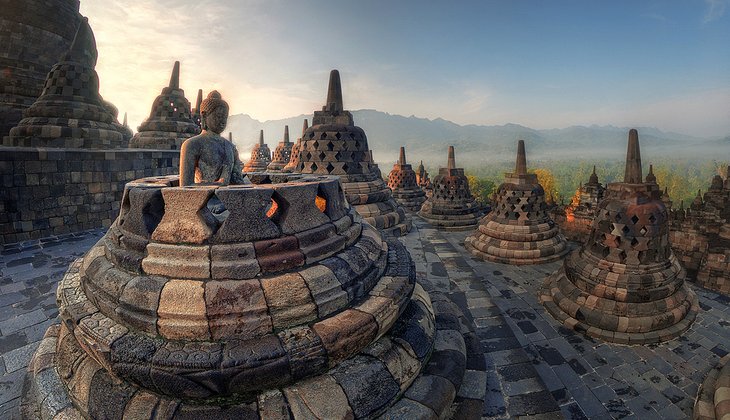
Set in a steamy jungle with three volcanoes providing the backdrop, Borobudur is Indonesia's top tourist attraction .
Borobudur dates from the 9th century and is one of the largest Buddhist temples in the world. It's a fascinating place to wander about. Over 500 Buddhas are spread around the site, some of which sit under ornate stupas.
Try to visit early in the morning when you'll have the best chance of experiencing a bit of early mist, and the view to the volcanoes will be the clearest.
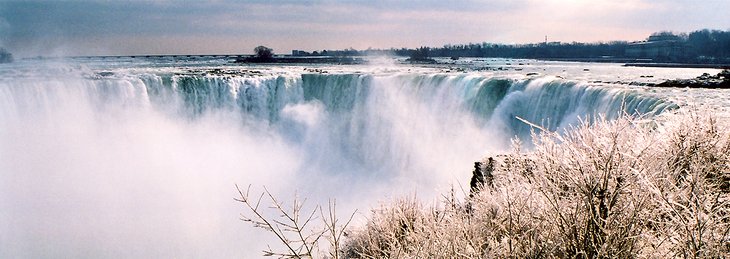
On the border between the United States and Canada, these great falls have been drawing explorers and travelers for centuries. Just over an hour from the city of Toronto, Niagara Falls is easy to get to, and the town is a fun place to spend a night or two.
Walk up to the edge of the falls, stroll along the paved walk lining the gorge for different views, or take a boat tour for a close-up look at the water pouring over the lip of the gorge above you. For a bird's-eye view, head up the Skylon Tower to look out over the falls.
At night, see the falls lit in different colors. If you're visiting in winter, watch the huge plume of mist rising into the sky above the falls.
Niagara Falls is easily reached from Toronto, Canada, or Buffalo, New York.
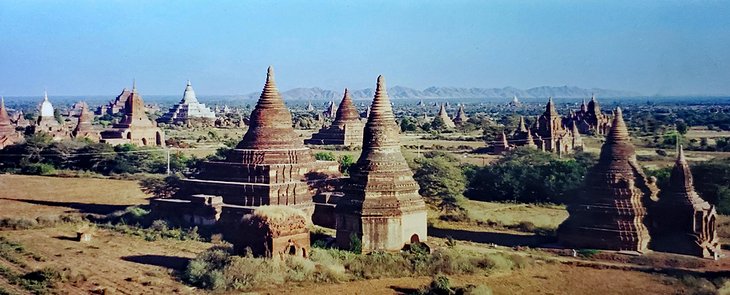
While this ancient site may not be on the average traveler's radar, it's another of Southeast Asia's bucket-list attractions.
Spread out over a lush plain are more than 10,000 sacred structures dating from 1044 through to 1287. Hire a bicycle and pedal your way from one amazing structure to the next, or take a tour. Some of the structures can be entered, but the real beauty is the sheer number that dot the landscape.
For an aerial view, consider taking a hot air balloon tour at dawn.
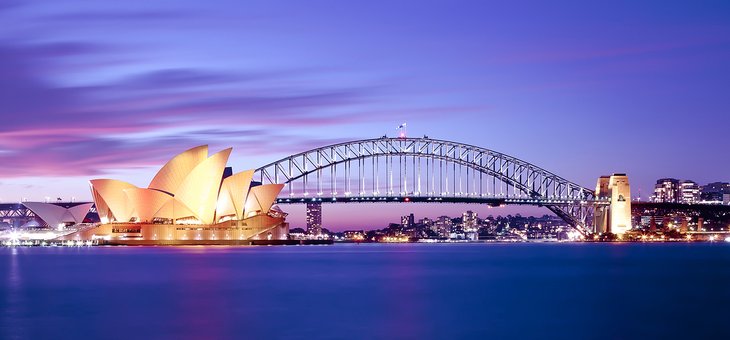
Like many other attractions around the world, the Sydney Opera House is one of those places that is easy to identify and obviously associated with Australia. A photo of yourself in front of the white sails screams Australia.
The Sydney Opera House was built in several stages and officially opened in late 1973. To fully experience the building, take a tour inside to see the unique shape and hear the exceptional acoustics.
Soak up the view from the Opera House area back towards the world-famous Sydney Harbour Bridge.
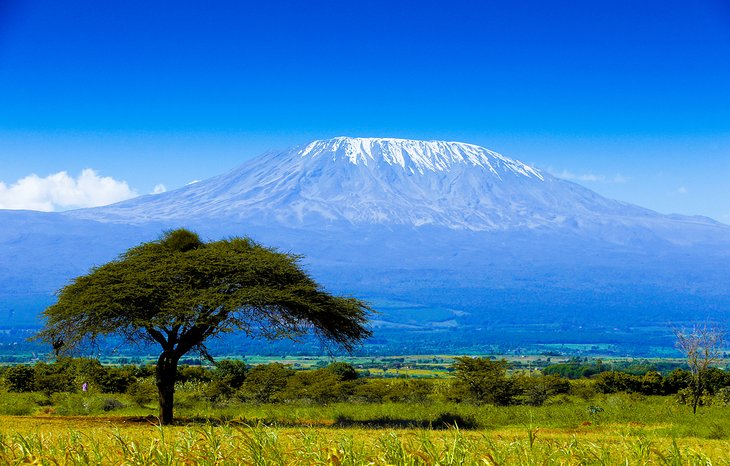
The highest peak in all of Africa, this majestic mountain – a dormant volcano – is one of the most recognizable symbols of the continent. The snowcapped peak is an impressive 5,985 meters (19,340 feet) and is often the backdrop to photographs of the wild animals that roam Amboseli National Park and other areas.
You can see this beautiful sight from afar or tackle the multi-day hike to the top of Mount Kilimanjaro for the fantastic views over the land, and to watch the sunrise.
- Read More: Top-Rated Tourist Attractions in Tanzania
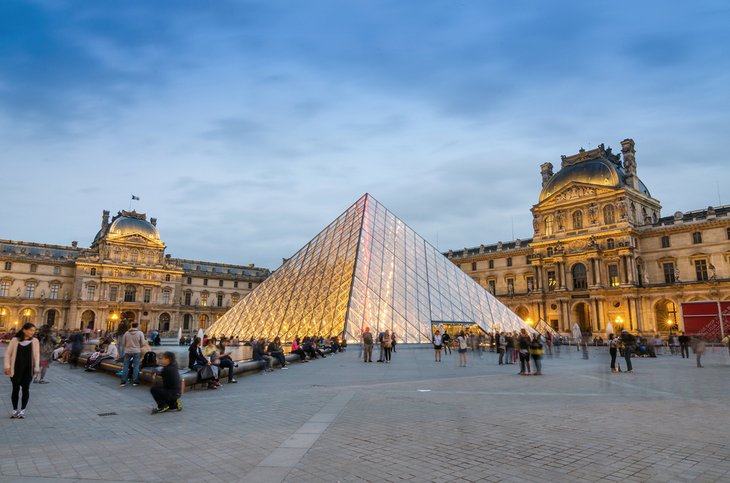
If there is one museum in the whole world that you absolutely must see in your life, it's the Louvre. Even if you are not a fan of museums, this one is worth the trip to Paris to see.
Although most people know it as the home to the most famous painting in the world, the Mona Lisa , this is just one of the reasons to visit the Louvre .
The museum holds countless masterpieces by the greatest artists that have ever lived. But even the building itself is an icon. The glass pyramids and the 18th-century building are recognizable to almost everyone, and have been shown in countless movies.
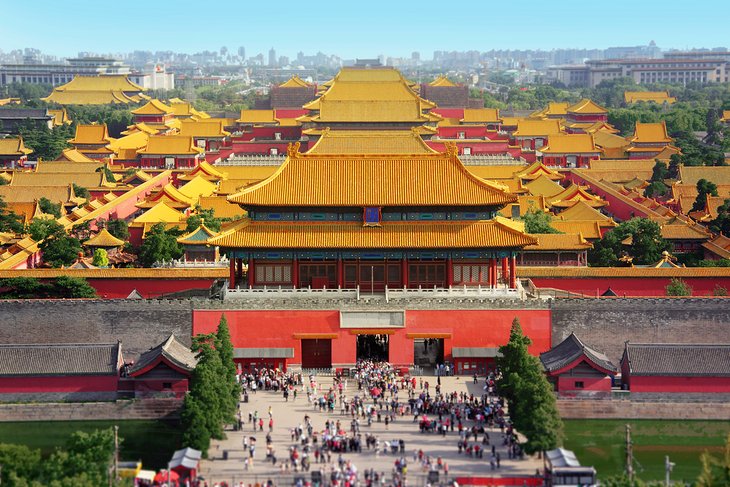
Like the Great Wall, the Forbidden City, also known as the Imperial Palace, in Beijing is one of the top places to visit in China . The sprawling complex dates from the 14th and 15th centuries and is a spectacular example of historical China.
Over the centuries, the palace has housed 24 Ming and Qing Emperors. Inside the city, the Palace Museum holds over 340,000 artifacts showcasing the treasures of China's dynasties. In front of the Forbidden City is the massive Tiananmen Square .
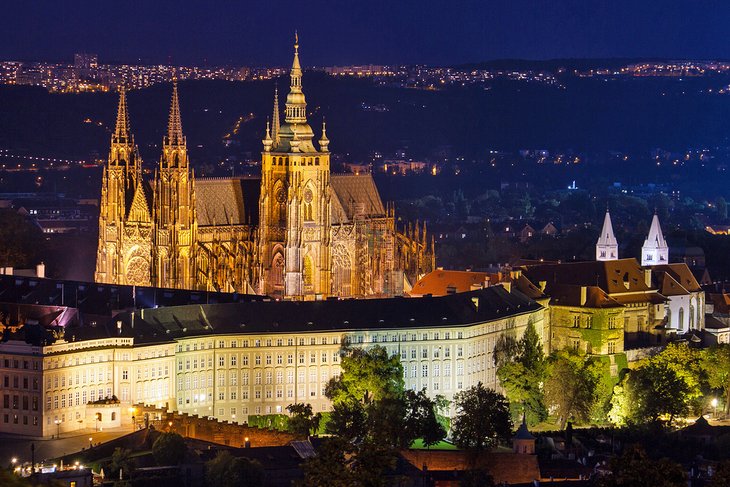
Prague is undoubtedly one of the most beautiful cities in the world. Sitting atop a hill across the river from the center of the city, Prague Castle casts an imposing aura over its surroundings. The castle is an incredible collection of buildings constructed from the 9th to 14th centuries.
Stroll over the ornate 14th-century Charles Bridge spanning the Vltava River and head up the hill to wander the narrow, twisty streets in the castle complex . The castle is one of the largest in the world, and around almost every corner is a historical building, church, or open square.
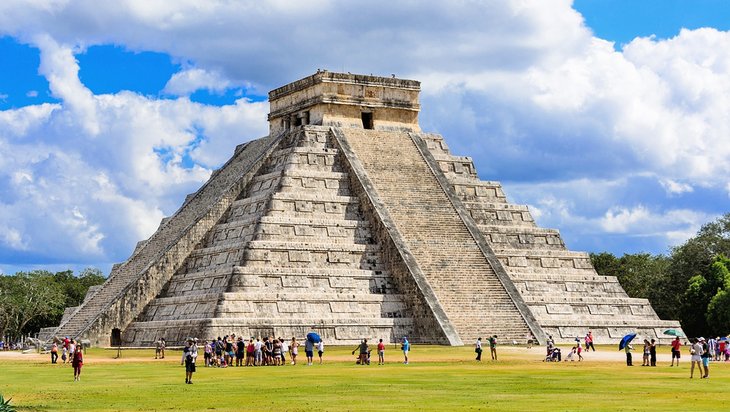
The ancient Mayan ruins of Chichen Itza have been drawing curious tourists since they were first brought to light by a popular book by John Lloyd Stevens in 1843. Today the site, located near the center of the Yucatan Peninsula, is one of the top tourist attractions in Mexico and is a UNESCO World Heritage Site .
The 30-meter-high Pyramid of Kukulkán has been restored to its full glory along with many of the other significant buildings, including the Great Ball Court, the Temple of the Warriors, and the eerie Skull Platform.
Chichen Itza is located about 200 kilometers from Cancun and is easily accomplished in a day trip from Cancun, Playa del Carmen, and other areas of the Mayan Riviera either on your own or as part of a group.
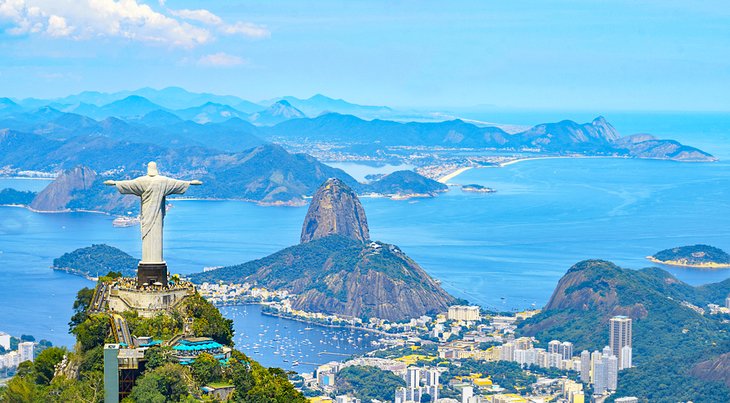
Keeping a watchful eye over the citizens of Rio de Janeiro from his perch atop Corcovado mountain is the stunning statue of Cristo Redentor. This huge 30-meter-high statue with its arms wide open in a welcoming gesture has been one of Rio's top tourist attractions since 1931.
The harbor of Rio de Janeiro is one of the 7 natural wonders of the world . The views from the top of the 709-meter Corcovado look out over this beautiful sight, including Sugarloaf Mountain and the city perfectly poised for beautiful photographs. The best way to get to the top is a ride up through the forests of the Tijuca National Park on the 3.5-kilometer Corcovado Rack Railway.
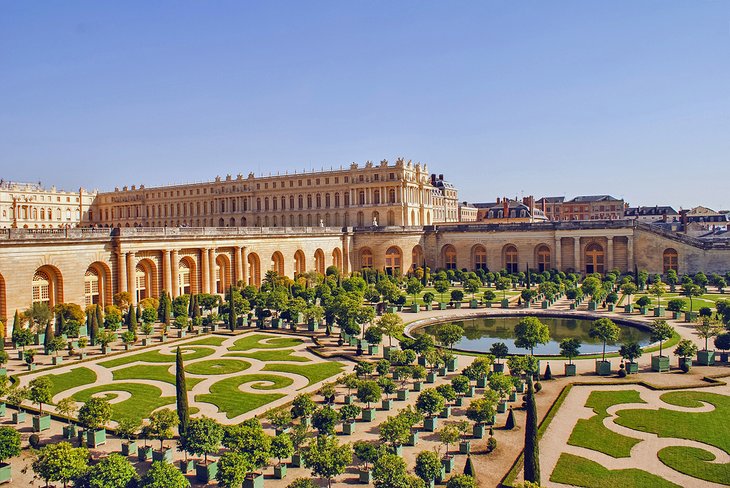
The wealth and grandeur of 17th-century France is on display at the incredible Château de Versailles. The château and the grounds are a UNESCO World Heritage Site and should be near the top of your touring plans when in France.
The Château de Versailles has an unbelievable 2,300 rooms housing some of France's most impressive interior design work, especially in the world-famous Hall of Mirrors. Other important rooms include the King's State Apartment and the Queen's Apartment.
The grounds of the château encompass 800 hectares, and one of the most impressive sights is the Gardens (Les Jardins). Geometrical pathways follow immaculately trimmed hedges past serene pools all surrounded by lawns cut to within an inch of their life.
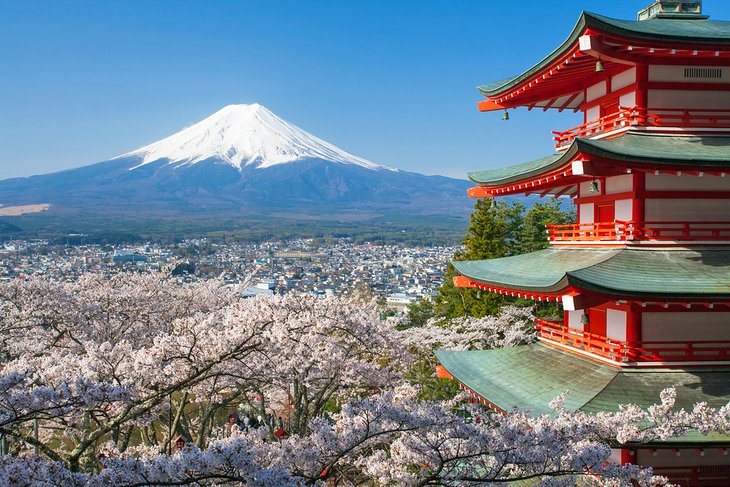
Mount Fuji is the most well-known and highest mountain in Japan. Often pictured snowcapped, this dormant volcano is both a spiritual site and one of the top tourist attractions in Japan . Soaring 3,776 meters high, Mount Fuji is one of three Holy Mountains, all of which are UNESCO World Heritage Sites.
Hiking to the top of the mountain is a popular thing to do in Japan. Each year, nearly 300,000 people follow one of four routes to the top. One of the most popular things to do is time your hike so that you reach the summit just before sunrise.
Mount Fuji is located 100 kilometers east of Tokyo and is easily accessible via public transit and tours .
Read More: Exploring Mount Fuji: A Visitor's Guide
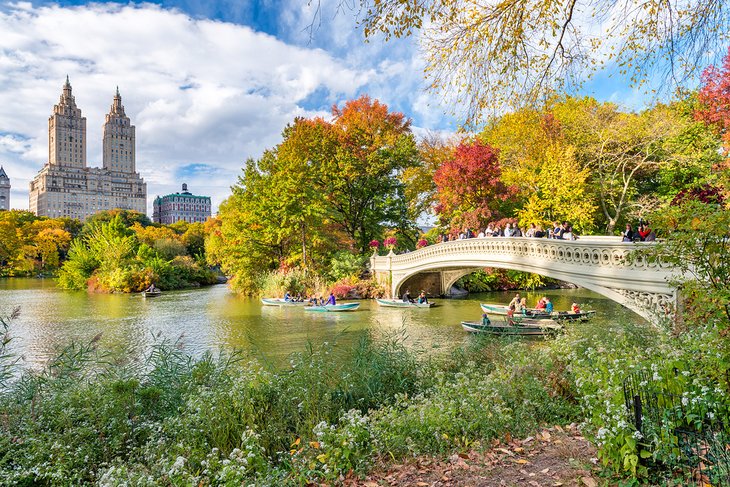
Loved by generations of New Yorkers and by people from around the world, Central Park is one of the most famous public spaces in the world. The backdrop to countless movies and television shows, the park's walkways, lakes, and historical sights have been drawing city dwellers and visitors since it was first created in 1858.
Some fun things to do in Central Park include taking a horse-drawn carriage ride through the park, visiting the Strawberry Fields Forever area and Imagine monument dedicated to the late John Lennon, renting a row boat, or just strolling under the towering trees. If you find yourself in the park in the cold season, ice skating is one of the most popular things to do in New York in winter . Going ice skating with your sweetie is also a romantic thing to do in New York.
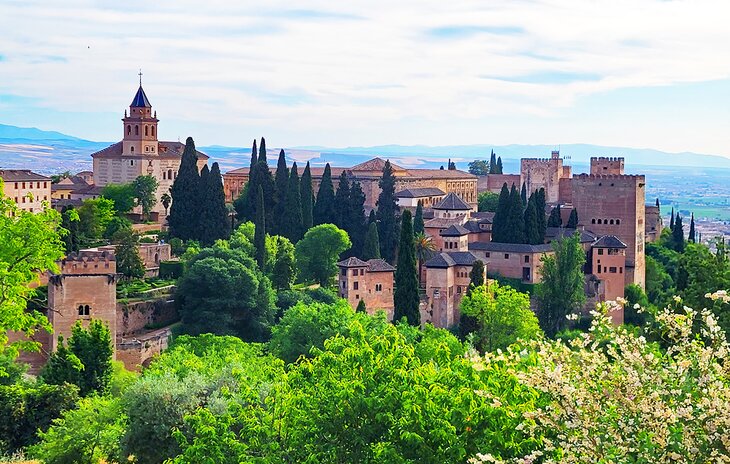
The stunning Alhambra is perched high on the hills above the Spanish city of Granada and is a testament to the wealth and power of the Nasrid Dynasty of the 13th Century. A huge complex full of ornate gardens, lush courtyards, bubbling water features, and spectacular buildings make it one of Spain's top tourist attractions and a UNESCO World Heritage Site.
Count on a full day to explore the Alhambra with its incredible buildings which include the Palacios Nazaries consisting of the Palacio Real (Royal Palace), the Palacio de Comares (Palace of Ceremonial Rooms), and the Palacio de los Leones (Palace of the Lions). Views out over the city of Granada and the surrounding mountains from the ruins of the Alcazaba are among the highlights.
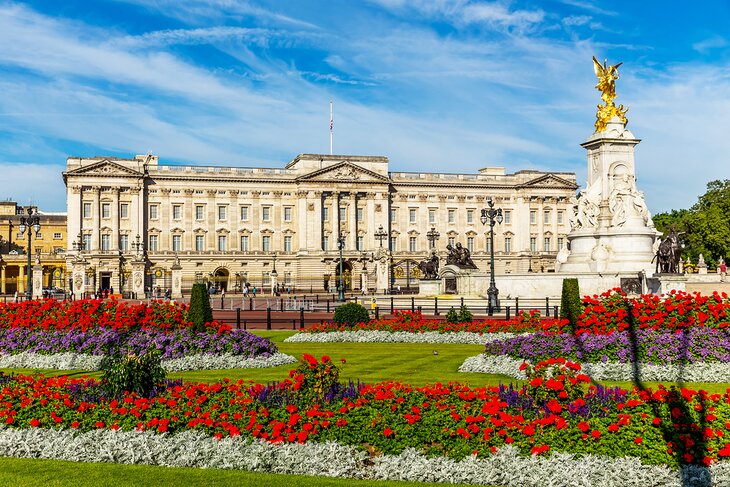
The stately palace located in the heart of London attracts millions of visitors every year. This iconic building and treasured monument is home to the ruling monarchy and its grand façade showcases the importance of the Royal Family in British society.
Highlights of a visit to Buckingham Palace include witnessing the Changing of the Guard ceremony where guardsmen with their red tunics and bearskin hats execute an intricate series of maneuvers.
If you find yourself visiting in the summer, try your best to get tickets for the tour through the grand State Rooms with their extensive and impressive collection of priceless art and period pieces.

A fun town with a Boho vibe, Ubud is high on the list of things to see and do in Bali . Located inland in a lush area, the town has a wide range of cultural and natural attractions. A must-see is the Sacred Monkey Forest , a dense site of towering trees, river gorges, historic temples, and of course, monkeys. Hundreds of monkeys live in this protected area and wander freely on the pathways providing non-stop entertainment.
Just out of town are the world-famous Tegallalang Rice Terraces . Descending from a ridge to the valley below, the terraces flow according to the landscape.
Ubud features prominently as a destination for shopping, many of Indonesia's best artisans have shops here selling everything from Batik fabrics to ornate jewelry.
Ubud is also known as a place to work on your inner well-being, countless yoga studios and wellness retreats are located here.

More on Cambodia
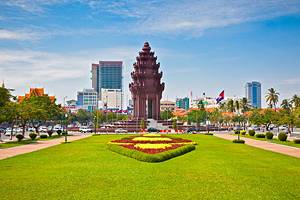

The appeal of tourist destinations | What attracts tourists
If you’re wondering what attracts tourists, then you need to look at what a tourist destination has to offer. The appeal of tourist destinations often depends on the features that can be found there. These features vary considerably and different destinations have different reasons why they are popular (or not).
The appeal of tourist destinations can be made up of one or more dominant factors. Perhaps what attracts tourists in that particular area is the weather, or a theme park or the natural beauty. In this article I will tell you about the most common features that affect the appeal of tourist destinations.
What attracts tourists?
Precipitation levels, temperature charts, hours of sunshine, seasonal variations, food and drink, transport links, communication and wifi, types of accommodation, business facilities, entertainment, landscape and topography, flora and fauna, natural phenomena, cultural heritage attractions, historical sites, religious sites, theme parks, exploration, involvement, development, consolidation, rejuvenation/decline, the appeal of tourist destinations: to conclude, further reading.

Whether you are studying travel and tourism , working in the tourism industry or setting up your own travel-related business, it is important to understand what attracts tourists- after all, no tourists, no business, right?
Below I have outlined the main aspects that tourists will think about when they are considering when and where to go for their holiday.

One of the first things that I do when I am considering travelling to a tourist destination is check the weather at that time of year.
Whilst we did travel to Costa Rica in the rainy season and we did visit Jeju island during a typhoon, I really would prefer to avoid the cold and wet weather- coming from the UK, I have had my fair share of soggy socks and frizzy hair!
Having said that, travelling during the off-peak season can be a great time to grab some cheap deals and avoid the crowds . So you have to weigh up your options I guess…
Anyway, if you’re wondering what attracts tourists, one of the biggest factors is often the weather. After all, a beach holiday isn’t much fun in the rain and a skiing trip isn’t so great if there is no snow!
When looking at the appeal of a tourist destination, there are several factors regarding weather that a tourist is likely to consider. I will outline these briefly below.
Precipitation is basically anything wet- rain , sleet, snow, hail etc.
Precipitation levels will often negatively impact the appeal of tourist destinations. Whilst there are some areas that need the water to be desirable e.g. a rainforest , most of us would prefer not to walk around in the rain all day everyday.
Many destinations have a clear wet and dry season. This usually coincides with the low season, because tourists prefer not to visit when it is likely to rain.
You can usually find details about annual precipitation for a tourist destination online. You will often find a graph, such as the one below, which is pretty handy.
Did you know that us Brits actually have some pretty funny ways of stating that it is raining?
Here are some of my favourites-
- It’s raining cats and dogs
- It’s tipping it down
- It’s drizzling
- It’s spitting
- It’s bucketing it down
- It’s great weather…for ducks
- The heavens have opened
- There is an April shower
- It is ‘trying to rain’
Many tourists will use temperature charts to decide when is the best time to visit a destination. This is particularly common with beach holidays, when tourists want warm, sunny weather!
As you can see in the chart below, the warmest weather in Malaga, Spain is in July and August. This also coincides with the peak tourist season.

Another thing that often attracts tourists is hours of sunshine.
Some parts of the world, near the equator, do not have big variations in sunlight hours throughout the year. However, other countries do.
Did you know that Norway has days in the summer when the sun never sets and days in the winter when the sun never rises? Pretty cool huh?
For some people, the hours of sunshine that a destination has to offer each day make affect the appeal of the tourist destination.
The appeal of tourist destinations can also be impacted by seasonal variations. The type of tourist destination will determine whether the seasonal variations (if any) are important factors that will affect the appeal.
Some people want to travel in the winter. Tourists may want to visit winter sports destinations , to visit Christmas markets (in the Northern hemisphere) or to go to Lapland or similar destinations that rely on cold, wintery weather.
Other destinations may attract tourists when the weather is warm, for example coastal resorts and seaside destinations. Places such as Spain, California and Melbourne all have distinct warm seasons when the beaches are filled with tourists.
Pollution is an issue that is coming more and mote to the forefront of people’s minds when travelling.
The air quality index (AQI) is a measurement of the amount of pollution in the air. Before I moved to China I had never heard of this, however I am now aware that this issue reaches far beyond China…
The map below provides a representation of pollution levels around the world. Red, brown and purple is bad- like you should not go outside at all-bad. Orange is pretty bad too- as in, you should avoid exercise outside. Green is good.
What comes as a surprise to many, is that pollution levels are high in many countries and cities around the world. Whilst China and India probably have the worst reputation, they are not the only countries who suffer.

To many people’s surprise, the UAE ( Dubai and Abu Dhabi) and some cities in the USA have some of the filthiest air around.
It really bring the whole climate change debate home when you have to put on a mask to leave the house…
Anyway, as I said, this may not be at the forefront of most people’s minds right now, but it will become more so as awareness continues to grow around the world.
What can negatively affect the appeal of tourist destinations? Pollution.
Tourist facilities and amenities

When considering what attracts tourists, the facilities and amenities in the tourist areas certainly come into play.
There are different facilities that the average tourist is likely to require, as discussed below.
The appeal of tourist destinations can be reduced if tourists don’t have the necessary home comforts- one of these is toilets.
For some people, the state of the toilets in the destination that they will be visiting may never have crossed their mind! But for others, it may be a significant factor…
In many developing countries there is a lack of Western toilets. Many tourists, for example, are surprised when they visit the lavatory in a reasonable-standard Thai restaurant, only to be greeted with a hole in the floor in a wooden hut out back. After avoiding the huge spiders in the corner, managing to get pee all over their feet and then realising there is no toilet paper or hand soap, they then return to the restaurant to finish their meal….
Sound familiar? Yep- been there, done that toooooo many times!
If a destination wants to attract more tourists, they may need to modernise and enhance their cleaning standards run this regard…. but, this does, of course, depend on who is visiting. Backpackers probably don’t care so much about squat toilets, but people in search of a 5* luxury experience may be a bit more picky…
The appeal of tourist destinations is often impacted by the provision of food and drink.
For many tourists, going out for meals and evening drinks is an important part of there holiday experience.
For the mass tourism industry, it is important that destinations offer a wide variety of food options that cater for different tastes and budgets. These tourists often enjoy food that is similar to the foods that they eat at home.
For those embarking on a cultural tourism adventure, local cuisine and authentic tastes is probably more important.
Did you know?

Did you know that prawn crackers are NOT Chinese!!
Yes, you read that right. That Chinese take-away that you eat on a Saturday night is not authentic. Most of it isn’t even Chinese. Prawn crackers, egg fried rice, crispy shredded beef- I have seen NONE of these items on any menu since I’ve been living in China!
Interested to learn more? Take a look at my article about authenticity in food (you will be surprised how much you eat is fake!!).
There is a reason people visit Italy and Thailand- because the food is DELICIOUS!
For foodies, the availability of nice food may be a dominant motive for visiting a tourist destinations. For others it could be a side reason or even just a bonus. Nonetheless, it all adds to the appeal of tourist destinations.
Transport options is a pretty big deal.
If a destinations is accessible, then more people will find it appealing. This means regular flights, trains, ferries etc and a good road infrastructure.
Cost is also an important factor. If a destination can be reached for a re3asonable cost, then more people will find this destination appealing. What attracts tourists? Low airfares and regular flights!
The advent of the low cost airline had a big impact in this regard. The likes of easyJet and Ryan Air enabled people to travel more often for a cheaper price. The destinations served by these airlines, therefore, instantly became more appealing to tourists.
Today’s world is interconnected and globalised . We want to be able to receive our work email, see updates from our friends on Facebook and check in on Grandma via FaceTime.
Having adequate wifi and phone signal is impressive in the world that we live in today. If a tourist destination wants to appeal to more tourists, they must ensure that they can offer this.
There are many different types of accommodation in the tourism industry.
In fact, accommodation is a core component of tourism . In other words, without adequate accommodation provision, tourists will not find a destination appealing.
The type of accommodation on offer will vary according to the type of tourist destination and the types of tourists that the area attracts. Jungle areas may have eco-lodges . Cities may have Airbnb apartments. Beaches may have 5* hotels.
It is important that the tourist destination does appropriate research and planning to understand who their target market is and what type of accommodation they would prefer.
For destinations which serve business tourists, there should be adequate business facilities.
Business tourism is one of the biggest and most important sectors of the travel and tourism industry. In order for destinations to capitalise on the prospects available too them, they must ensure that they provide the facilities that business travellers need, such as wifi, conference rooms, telephones, quiet rooms, black out curtains etc.
Many tourists will find a destination appealing as a result of the entertainment available to them.
This could be visiting a West End show in London, birdwatching or an evening cabaret show. The types of entertainment available in the travel and tourism industry is wide-ranging.
Attractions

The appeal of tourist destinations can be significantly impacted by the attractions that they have on offer. Most people wouldn’t have heard of Agra were it not home of the Taj Mahal, for example!
Different types of tourist attractions have a lot to offer the tourism industry. From entertainment to leisure to being amongst nature, there are many different reasons why tourists want to visit areas that are home to major (or minor) tourist attractions.
Natural attractions
Natural attractions are often what attracts tourists to particular areas. There are many famous natural attractions around the world that attract many tourists each year.
As I mentioned before, climate is often affects the appeal of tourist destinations. This is particularly relevant with coastal areas, where then main attraction is the beach .
The natural landscape can be what attracts tourists to visit a particular area. From climbing Mount Kilimanjaro to hiking the Mendips , there are plenty of varied landscape areas that attract tourists.
Many tourists will find a tourist destination appealing because of the waterfalls in the area.
From major waterfalls such as Niagara and Victoria Falls, to the lesser-known waterfalls in Goa or Costa Rica, many tourists enjoy visiting these natural attractions.
Many tourists find a tourist destination appealing because of the natural flora and fauna that it has to offer.
This could include jungle areas, such as the Amazon Rainforest or areas that have unusual plants and landscapes, such as the Galapagos Islands.
Natural phenomena is another aspect that affects the appeal of tourist destinations.
Many people will choose to visit Iceland to see the geysers, Costa Rica for the volcanoes or Norway for the Northern Lights. These natural phenomena are what attracts tourists to visit.
Having said that, natural phenomena can also have the opposite effect, and put tourists off visiting.
Natural disasters, such as a tsunami, an earthquake or a flood can adversely affect tourism and will put tourists off visiting for a period of time.
Built attractions
It’s not only natural attractions which affect the appeal of tourist destinations, but built attractions too.
Built attractions can be separated into different categories, as follows.
There are a wide range of buildings, areas and places that have historical or culturally significance. These places are often restored or protected and then displayed to tourists.
Historical or heritage-based tourist attractions include castles, famous walls, ruins, towers, monuments, religious buildings, houses and palaces.
These types of tourist attractions are often beneficial because they help to preserve cultural and heritage, which is a positive impact of cultural tourism .
Many people choose to visit a tourist destination because of the historical relevance of an area pr attraction.
Whether you are planning to learn more about the Berlin Wall in Germany, visit the D-Day beaches in France or learn all about the Khmer Rouge Regime in Cambodia, there are plenty of places which affect the appeal of tourist destinations as a result of their historical significance.
Likewise, there are many tourist destinations that are appealing because of the religious sites in the area.
From the Blue Mosque in Istanbul to The Wailing Wall in Jerusalem , there are plenty of places around the world that have significant religious value.
Museums and art galleries are usually purpose-built for tourism.
Museums and art galleries are found all over the world. These fall into different categories of the types of travel and tourism organisations . Some museums and art galleries are publicly funded or subsidised and others are privately owned, and therefore incur a cost to the visitor.
Theme parks are very popular built tourist attractions. They are built with the sole purpose of providing entertainment for visitors.
Theme parks are usually quite large. Sometimes you will pay a one-time fee to enter with unlimited access to rides. Other times you may be required to pay for individual rides. Many of the large theme parks are renowned for being busy and having long queues for rides.
Stage of development as a tourist destination
The final aspect that is likely to affect the appeal of tourist destinations is the stage of development of the tourist destination.

As prescribed in Butler’s tourist area life cycle model , a destination will go through phases in popularity depending on how developed it is. And as Plog pointed out, these stages will attract different types of tourists.
Here is a brief overview of the stages in Butler’s tourist area life cycle model. For more detail, take a look at my full post on Butler’s theory.
The exploration stage marks the beginning. Tourism is limited. The social and economic benefits are small. Tourist attractions are likely to be focused on nature or culture .
This is the primary phase when Governments and local people are beginning to think about tourism and how they could capitalise and maximise their opportunities in this industry. This is the start of tourism planning .
The involvement stage marks the beginning of tourism development.
Guest houses may start to open. Foreign investors may start to show an interest in development. Governments may be under pressure to develop transport infrastructure and community resources, such as airports, road layouts and healthcare provision.
The involvement stage may mark the emergence of seasonality in tourism.
During the development stage there will be lots of building and planning. New roads, train stations and airports may be built. New tourist attractions may emerge.Hotels and hospitality provisions will be put in place.
During the development phase there will likely be an increase in marketing and promotion of the destination. There could be increased media and social media coverage.
During this time the tourist population may begin to out-number the local population. Local control becomes less common and top-down processes and international organisations begin to play a key role in the management of tourism.
During this stage tourism growth slows. There will generally be a close tie between the destination’s economy and the tourism industry. In some cases, destinations have come to rely on tourism as a dominant or their main source of income.
Many international chains and conglomerates will likely be represented in the tourism area.This represents globalisation and can have a negative impact on the economy of the destination as a result of economic leakage .
It is during this stage that discontent from the local people may become evident. This is one of the negative social impacts of tourism .
The stagnation stage represents the beginning of a decline in tourism. During this time visitor numbers may have reached their peak and varying capacities may be met. The destination may simply be no longer desirable or fashionable.
It is during this time that we start to see the negative impacts of overtourism . There will likely be economic, environmental and social consequences.
The final stage of Butler’s Tourism Area Life Cycle Model represents a range of possible outcomes for the destinations along the spectrum between rejuvenation and decline.
Complete rejuvenation can occur through major redevelopments. Perhaps new attractions are added, sustainable tourism approaches are adopted or there is a change in the target market.
Modest rejuvenation may occur with some smaller adjustments and improvements to the general tourism infrastructure and provision.
If changes do not occur, there may be a slow continuation of tourism decline.
In severe circumstances, there may be a rapid decline of the tourism provision. This is likely due to a life-changing event such as war, a natural disaster or a pandemic.
When asking the question ‘what attracts tourists?’, there are many different possible answers.
The appeal of tourist destinations varies according to the type of destination, its phase of development and the types of tourists that it attracts.
However, one thing is sure- it is imperative that destinations sufficiently assess and analyse their tourism provision to ensure that they provide the aspects which appeal to tourists the most. This will enable them to be as successful as possible.
If you’re studying travel and tourism or learning how to build a business, then I highly recommend the following texts to support your learning:
- An Introduction to Tourism : a comprehensive and authoritative introduction to all facets of tourism including: the history of tourism; factors influencing the tourism industry; tourism in developing countries; sustainable tourism; forecasting future trends.
- The Business of Tourism Management : an introduction to key aspects of tourism, and to the practice of managing a tourism business.
- Tourism Management: An Introduction : gives its reader a strong understanding of the dimensions of tourism, the industries of which it is comprised, the issues that affect its success, and the management of its impact on destination economies, environments and communities.

13 Types of Tourism That You Need to Know
- August 7, 2023
Table of Contents
Welcome, wanderlust seekers and adventure enthusiasts, to a thrilling exploration of the world’s diverse tapestry of tourism! Embark on a captivating journey as we unveil the tantalising realm of travel, introducing you to the mesmerising array of types of tourism that will ignite your wanderlust. From the adrenaline-pumping escapades of adventure tourism to the enriching experiences of cultural and heritage tourism, we delve deep into each captivating category, revealing the hidden gems, unique opportunities, and travel solutions that await you.
Whether you’re a passionate foodie yearning for culinary delights or an eco-conscious traveller seeking sustainable adventures, our comprehensive guide will unlock the secrets to immersing yourself in the rich tapestry of travel. So pack your bags, unleash your curiosity, and join Qoni Travel as we unravel the thrilling world of 13 different types of tourism you need to know about!
13 Types of Tourism
Adventure tourism.
Embarking on an awe-inspiring escapade filled with adrenaline-fueled thrills is the ultimate recipe for infusing your travel adventures with excitement. Adventure tourism, the realm where extraordinary tales are born, encompasses an array of heart-pounding activities. From the intrepid pursuit of conquering majestic peaks through hiking and mountaineering to the audacious ascent of vertical cliffs during rock climbing expeditions, the possibilities for daring exploits are boundless.
For those who possess an insatiable appetite for exhilaration, the heart-stopping leap of faith in bungee jumping or the wild ride down untamed rapids in white-water rafting are exhilarating options that promise to set pulses racing. Adventure tourism, a siren call to intrepid souls, offers the chance to revel in unforgettable experiences amidst breathtaking natural landscapes, satisfying the yearning for extraordinary encounters and leaving an indelible imprint on the adventurous spirit within.
Cultural Tourism
Cultural tourism emerges as an irresistible allure for wanderers seeking to unravel the rich heritage that unfurls before them. This enchanting form of exploration beckons travellers to step into a realm of boundless wonders, where they traverse the hallowed halls of museums, trace the footprints of history at ancient sites, marvel at the brushstrokes of artistic genius within vibrant galleries, and partake in the rhythmic dance of time-honoured festivals that awaken the senses.
Eco-Tourism
In the past few years, a remarkable surge in consciousness about the significance of sustainable travel practices has emerged. Embracing this movement, eco-tourism has emerged as a captivating way to immerse oneself in the wonders of the natural world while meticulously safeguarding its delicate balance.
Drawing adventurers to breathtaking national parks, serene nature reserves, and hallowed protected areas, eco-tourism enthusiasts enthusiastically partake in eco-friendly activities, such as observing magnificent wildlife, marvelling at feathered wonders, and embarking on enlightening nature walks. With each step, these mindful explorers tread lightly, ensuring that their footprints leave no lasting scars while simultaneously nurturing their connection to the awe-inspiring tapestry of life.
Through this immersive odyssey, cultural tourism serves as a gateway to enlightenment, allowing intrepid souls to embrace the intricacies of local customs, traditions, and the very essence of existence while nurturing a profound cross-cultural empathy and an unwavering appreciation for the beauty that lies within the tapestry of humanity.
Sustainable Tourism
Sustainable tourism goes hand in hand with eco-tourism, significantly emphasising conscientious and mindful travel practices that prioritise environmental preservation, uphold local communities and foster socio-economic growth. By opting for eco-friendly accommodations, supporting locally owned enterprises, and actively participating in community-based tourism projects, sustainable tourism catalyses preserving our invaluable natural wonders and cultural legacies, ensuring their unspoiled existence for generations to come.
Wellness Tourism
Amid our modern, high-speed existence, wellness tourism emerges as a blissful sanctuary, beckoning individuals to rediscover harmony within their minds, bodies, and spirits. Embracing an ethos of tranquillity and self-nurturing, this captivating form of travel encompasses an array of activities designed to alleviate stress, restore vitality, and enhance personal growth.
Encountering a world of possibilities, wellness tourists embark on transformative journeys, seeking solace in serene spa retreats, immersing themselves in the serene embrace of yoga and meditation centres, indulging in the lavish comforts of wellness resorts, and embracing the transformative power of healing retreats. With wellness tourism, holistic well-being becomes a destination and a transformative expedition that transcends the boundaries of time and space.
Culinary Tourism
Indulge your taste buds and embark on a tantalising journey with culinary tourism, an adventure tailored for avid food lovers seeking to immerse themselves in the rich tapestry of flavours and culinary customs across the globe. Prepare for a mouthwatering experience as you partake in captivating food tours, where every bite unlocks the secrets of local cuisines and cooking classes that reveal the artistry behind cherished recipes.
Let your senses dance as you savour regional delicacies, uncover the historical and cultural significance woven into each dish, and witness the transformative power of food as it bridges the gap between diverse communities. With culinary tourism, every destination becomes a delectable playground waiting to be explored, ensuring a truly unforgettable and palate-pleasing voyage.
Historical Tourism
Step back in time and embark on a captivating journey through the annals of the past with historical tourism. This enticing adventure beckons history enthusiasts and inquisitive globetrotters alike. Immerse yourself in the tapestry of bygone eras as you traverse ancient ruins, wander through majestic castles, explore awe-inspiring archaeological sites, and meander through heritage cities that whisper tales of yore.
Unravel the secrets and significance of monumental events and iconic landmarks as every step unveils the captivating stories and the vibrant heritage that have shaped the world we know today. Historical tourism is your gateway to a remarkable fusion of discovery and reverence, offering a chance to unlock the mysteries of history and forge an unbreakable bond with the past.
Wildlife Tourism
Enthrals the hearts of passionate nature lovers and devoted animal enthusiasts, captivating them with the extraordinary allure of the natural realm. Embracing many exhilarating activities, from riveting safaris to stunning whale watching, this immersive experience transports individuals to ethereal bird sanctuaries and enlightening animal conservation centres. Amidst these ventures, one is blessed with the extraordinary privilege of beholding an exquisite tapestry of diverse wildlife species in their untamed habitats, fostering a deep connection and igniting a genuine commitment to the noble cause of conservation.
Religious Tourism
Is a captivating journey that immerses travellers in destinations with spiritual significance. It encompasses diverse experiences, from embarking on pilgrimages to revered holy sites to partaking in profound religious ceremonies. By venturing into these sacred realms, pilgrims and seekers of faith embark on a soul-stirring quest to strengthen their connection to their beliefs. As they traverse the enchanting landscapes, they marvel at awe-inspiring sacred architecture that is a testament to human devotion.
From the majestic Vatican City, home to the spiritual heart of the Catholic world, to the sacred and revered Mecca, drawing millions of devout Muslims every year, or the ancient and captivating Angkor Wat temple complex, religious tourism serves as a gateway to profound encounters with divine history, offering an unforgettable odyssey of faith and spirituality.
Educational Tourism
Embark on an extraordinary journey where the pursuit of knowledge intertwines with the allure of travel. Step beyond the walls of conventional classrooms and delve into the captivating realm of educational tourism. Immerse yourself in a tapestry of enlightening encounters as you traverse the halls of renowned educational institutions, wander amidst the whispers of history at awe-inspiring sites, and unveil the treasures within the hallowed halls of museums. Engage in immersive workshops and cultural exchange programs, fostering a vibrant tapestry of understanding and appreciation. Through educational tourism, watch as your horizons expand, your perspectives deepen, and the fire of lifelong learning is kindled within your soul.
Sports Tourism
This extraordinary form of travel allows passionate sports enthusiasts to fuse their love for athletics with unforgettable journeys. Whether you’re a spectator at thrilling sporting events, a contender in heart-pounding competitions, or an adventurer seeking sports-themed vacations, sports tourism offers an unparalleled opportunity to ignite your passion. Picture yourself bellowing cheers for your beloved team at the grandeur of the World Cup or gracefully gliding down awe-inspiring slopes as you ski through breathtaking landscapes. Get ready for a rollercoaster of exhilaration and exploration as sports tourism unlocks a world of electrifying experiences you won’t miss.
Volunteer Tourism
Discover the remarkable realm of volunteer tourism, a captivating adventure where intrepid explorers can leave a lasting mark while embarking on thrilling journeys to uncharted destinations. This extraordinary endeavour entails actively engaging in awe-inspiring community service projects, conservation endeavours, and humanitarian initiatives. As you immerse yourself in this transformative experience, an enchanting tapestry of cultural exchange unfolds, igniting profound empathy and fostering personal growth. Embark on this global quest to revolutionise lives and empower communities, embracing the boundless possibilities of volunteer tourism to create a brighter future for all.
Medical Tourism
Is an exhilarating blend of healthcare and adventure that entices individuals to embark on an international voyage in pursuit of top-notch medical care and exclusive procedures. It encompasses the exciting concept of jetting off to foreign lands, where one can embrace high-quality medical services without breaking the bank or discovering cutting-edge treatments that remain elusive within their homelands. With medical tourism , the boundaries of healing are surpassed as patients traverse borders, unlocking a world of possibilities for their well-being.
In a world bursting with wanderlust seekers and adventure enthusiasts, our thrilling exploration of the diverse tapestry of tourism has come to an exhilarating conclusion. Throughout this captivating journey, we have unveiled the tantalising realm of travel, introducing you to the mesmerising array of 13 types of tourism that ignite the flames of wanderlust within. From heart-pounding escapades in adventure tourism to the profound immersion in cultural and heritage tourism, each category has taken us deep into a world of hidden gems and unique opportunities.
Whether you’re a passionate foodie yearning for culinary delights or an eco-conscious traveller seeking sustainable adventures, our comprehensive guide has unlocked the secrets to immersing yourself in the rich tapestry of travel. As you pack your bags and unleash your curiosity, remember that the world awaits, ready to unravel the thrilling world of these 13 types of tourism you need to know about. So, embark on this transformative journey, and let the wanderlust within guide you to the extraordinary experiences that await, leaving an indelible imprint on your adventurous spirit. Stay tuned with Qoni Travel for more information.
Get in touch with our sales

Business Travel can be a fun and rewarding experience. It can also be a huge money sink for incautious people, so you need to be

Business travels often take a lot of hassle for companies, from keeping track of flights and transportation to accommodation and dining. And thus, you need

Traveling is among the biggest industries in the world that contributes a significant portion of the entire e-commerce business. It makes a high contribution to

Travelling is essential to business, and small businesses often require personalised support and cost-effective solutions. Choosing the right corporate travel agency can help small businesses

Connect with us
Travel services managed by.
Hype DMC Travel Sdn Bhd Co. Reg: 258404-A | KPL: 6430 No.167A, 1st Floor, Jalan Maharajalela 50150 Kuala Lumpur
S AMASTA TOUR & TRAVEL Jl. Tampak Siring Raya, Daan Mogot Baru, Blok KJ-F/3A, RT.8/RW.12, Kalideres, Kec. Kalideres, Kota Jakarta Barat, Daerah Khusus Ibukota Jakarta 11840, Indonesia
Operated by Travel Ideas Online Sdn Bhd Empowering journeys through innovative technology
Travel With - The Holiday Story
18 Different Types of Tourism | Globally Accepted
Last few years, tourists and their demands have frequently been changing. Also, the tourism industry is changing based on needs. This article elaborates on different types of tourism, tourists, planning, activities, products, travel , etc. It helps your travel planning as well.
Along with recreation, tourism has become one of the growing industries, and it’s the source of income for many people.
“Life is all about adventure, so pack your bags and start the tour.”
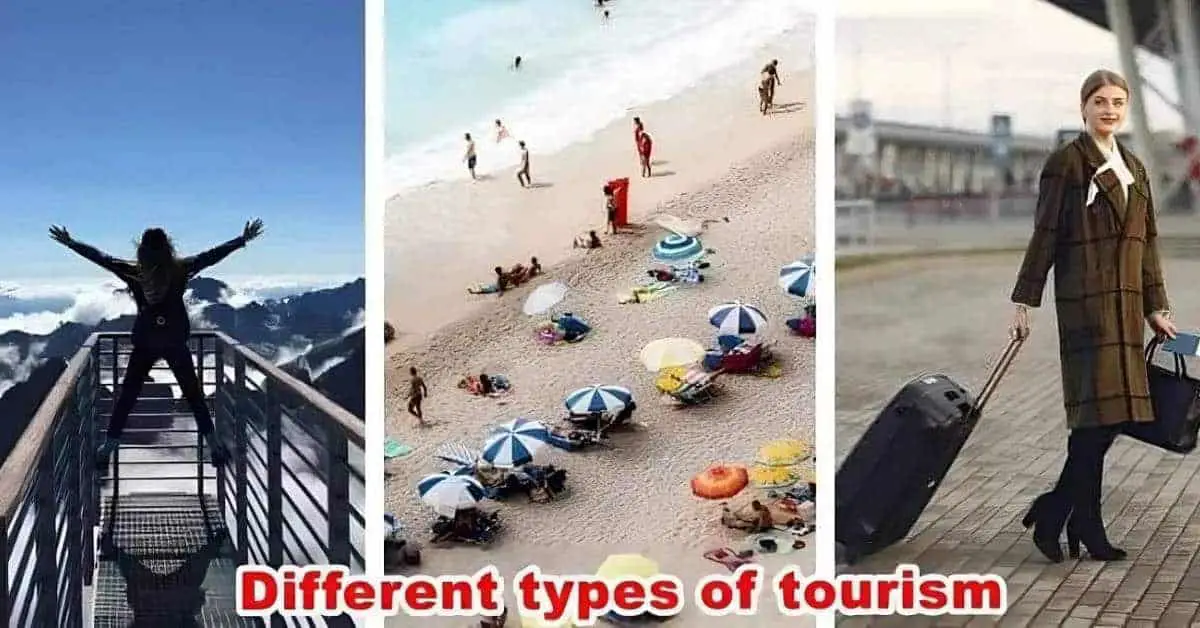
Different Types of Tourism
What is tourism.

Tourism is a process of spending time away from daily routine or home to pursue recreation, relaxation, and pleasure while using the commercial provision of services.
Tourism in a country has many benefits: it creates employment, boosts revenue, develops infrastructure, helps in cultural exchange, etc. Travel duration under tourism must be less than 12 months (a consecutive year).
So, What comes first to mind when we hear the word Tourism?
The most common thought is to pack the rucksack and travel away from day-to-day life. That means the movement of people from their usual residence to another place.
Suppose your friend’s aim for the tour might differ from yours. For example, you may travel for recreation, but he may go for business.
Classification of Tourism
According to the United Nations World Tourism Organization (UNWTO), tourism involves the movement of people in the country’s natural environment or outside the country for personal or other purposes. These different purposes classified the tourism industry in many ways.
This article lists the main tourism classifications: Domestic tourism, International tourism, Business tourism, Adventure tourism, Medical tourism, Educational tourism, etc.
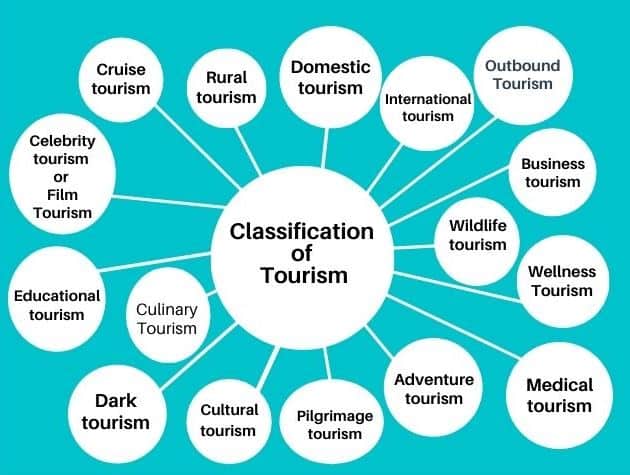
Importance of Tourism – Why is tourism important?
Tourism has a direct impact on any country’s economy. The role of tourism in economic development is important. A vast amount of job possibilities can develop through public relations in tourism. Knowing another state/country’s taste culture is a great filling from a traveler’s perspective.
Mainly how many types of tourism are there
Mainly three types of tourism are found in any country. The classes are domestic tourism, International tourism, and outbound tourism. But nowadays, many types of tourism newly evolved.
18 Different Types of Tourism
The various types of tourism are developed nowadays and become popular; they are:-
- Domestic tourism
- International tourism
- Outbound tourism
- Business tourism
- Adventure tourism
- Wildlife tourism
- Medical tourism
- Wellness tourism
- Pilgrimage and spiritual tourism
- Cultural tourism
- Dark tourism
- Culinary tourism
- Celebrity tourism or Film tourism
- Educational tourism
- Cruise tourism
- Rural tourism
- Beach tourism
- Space tourism
Let’s discuss how many flavors and categories of tourism can be found in any country and accepted globally.
1. Domestic Tourism
Domestic tourism involves traveling in one’s own country, and tourists don’t cross international borders or entry points. Domestic tourism is used to minimize poverty, enhance infrastructure, and boost the economy’s growth and generation of employment.
2. International Tourism
Travel outside your country needs a visa and passport; called International tourism. For example, if you want to explore The UK from Sri Lanka, you need documents to enter another country.
Read How to Listen to Music on a Plane
3. Outbound Tourism
This tourism defines a tourist traveling for a holiday to a different country, like your residents in Bali and traveling to Barcelona . It is an example of outbound Tourism.
4. Business Tourism
This tourist travels to meetings, officially gets together for conferences, etc.
Business tourism plays a vital role in the tourism sector. Sometimes, people stay out of their typical environment for more than a year for business purposes and spend their vacations there.
General activities related to business tourism include attending meetings, officially getting together, conferences, seminars, visiting exhibitions and trade fairs, etc. This tourism levels up the purchasing power.

5. Adventure Tourism
Adventure tourism is a person’s travel from one place to another to seek fresh adventures and activities. This form of tourism is most famous among young tourists and people who like to explore remote areas. It encourages us to leave our comfort zone by undertaking activities like hiking , rafting, climbing, diving, etc.
Adventure tourism is increasing day by day. You could also try whitewater rafting, the Ladakh tour, the Kedarnath tour, Port Blair, and Andaman and Nicobar tour for the adventure.

6. Wildlife Tourism
Wildlife tourism is people’s travel to different places to observe and interact with wildlife, flora, and fauna in their natural habitat. Safaris, visiting the animal rescue center, swimming with dolphins, etc., are examples of wildlife tourism.
Because of exotic species of wildlife, this tourism became recognized. The Sariska Wildlife or Hyde Park Sanctuary , Keoladeo Gana National Park, and Corbett National Park are renowned for wildlife tourism. The Great Barrier Reef is also famous in Australia.
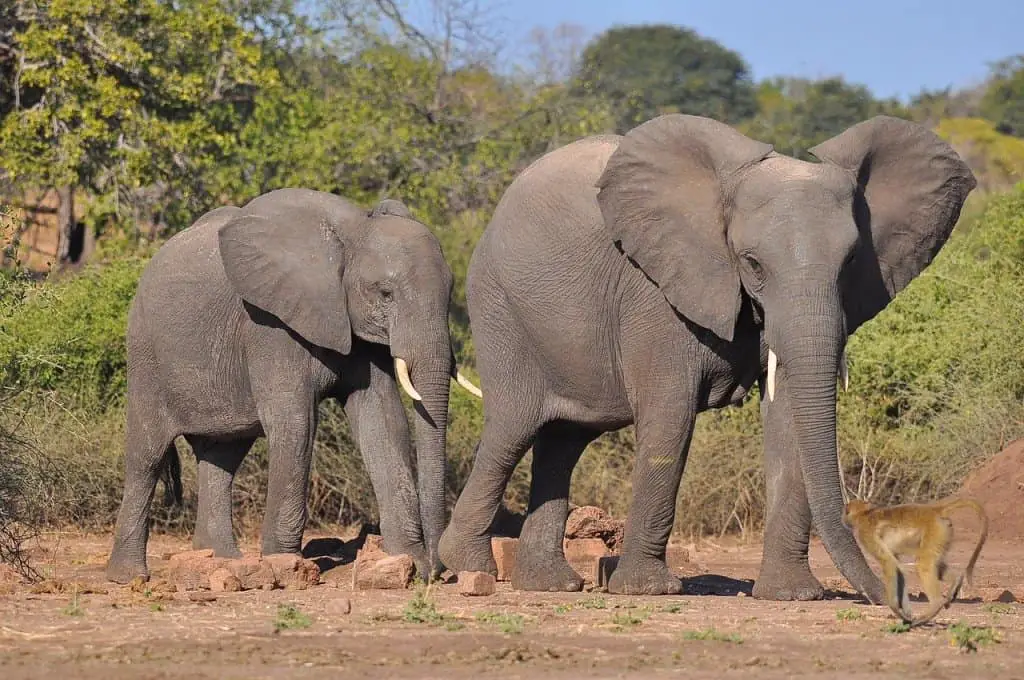
7. Medical Tourism
Many people travel for treatment, and several medical institutes cure foreign patients. Thailand has recorded 6000,000 new patients every year. Malaysia also treated over 100,00 tourists in 2005. 45% of foreign tourists come to Chennai for medical treatment.

8. Wellness Tourism
Wellness tourism has been a significant part of tourism since ancient times. This tourism mainly attracts those tourists who want to regain their health. Wellness tourism will help you to get rid of mental and health stress.
Tourists recover their health issues through physical, spiritual, or psychological activities. All around the world, plenty of destinations are popular for improving health.
Examples include Mexico Temazcal Beach Resort Spa, Caribbean wellness cruise, California weight loss and detox retreats, Colorado Hiking and Mountain Yoga retreat, and China Hot Spring Resorts TCM.
Ayurveda, Yoga , Meditation, Panchakarma, and Rejuvenation Therapy are the oldest Therapy of treatments to improve health and the best way to develop wellness tourism.

9. Pilgrimage and Spiritual Tourism
Pilgrimage or spiritual tourism is when a person journeys to other places for spiritual or religious reasons.
Spiritual tourism helps support local cultural activities and handicrafts, generating employment and revenue. Trips to Jerusalem, Bodh Gaya , Hajj, etc., are pilgrimage or spiritual tourism.
This tour has been famous for ages, but It’s popular among older people mainly. Vaishno Devi, Golden Temple, Char Dham, and Mathura Vrindavan are some places famous for Pilgrimage tours.
10. Cultural Tourism
Cultural tourism is a person’s journey to learn and participate in local festivals, rituals, and cultural activities of other places. It’s more than a commercial activity.
This form of tourism helps spread aboriginal communities’ culture, traditions, diversity, and richness to the rest of the world.
Visit the historical sites and the artistic features of that country too. Famous cultural tourism places are:-
- India – Durga puja in Kolkata , Temples at Banaras, Jaipur, known as the pink city Palace in Rajasthan. Forts and monuments in Delhi, Agra, UP.
- UK – Tower of London, The British Museum, Big Ben, London Durga puja , etc.
- Kenya – The main attraction is the dance of the Maasai tribe.
- Morocco – The main attractions are the Olive Festival and Honey Festival.
- Jordan – The main attraction- is Jerash, famous for Roman architecture Petra, the red-rose curved rock city and one of the seven world wonders, and Shoubak with its Montreal Crusader Castle.
- Greece – The main attraction- is the Lion Gate of Mycenae.
- Turkey – the main attraction- Sultan Ahmed. Mosque, House of the Virgin Mary.
- Vietnam – The main attraction- is Sapa Market.
- Ireland tour – Cliffs of Moher, Dublin, Killarney National Park, etc.

11. Dark Tourism
Dark tourism, Black tourism, or grief tourism are related to people’s travel to historical places involved with tragedy and death. Since 2016, dark tourism has significantly increased (over 1200%). Chornobyl, cemeteries, Ground Zero, historical museums, and Auschwitz are popular dark tourism destinations.
It is referred to as mourning tourism. Dark tourism involves visiting those places and sites that have witnessed the greatest tragedies in history. Besides this history of human suffering and bloodshed, these locations are famous for their historical value.
So, those sites that carry potent pesticides have become popular tourist destinations and attract many tourists yearly.
Like Famous sites In Japan, Hiroshima & Nagasaki bombing locations, Ground Zero, New York, USA . The War Remnants Museum, Ho Chi Minh City, Vietnam; Auschwitz concentration camp, Auschwitz, Germany; Tuol Sleng Genocide Museum, Phnom Penh, Cambodia, etc.

12. Culinary Tourism
Culinary or food tourism involves tasting and experiencing local and traditional food in a specific country, region, city/town/village.
It is significant that besides accommodation and infrastructure. Here, food is one of the prime components. Therefore, lots of tours are organized here to experience the culinary culture.
Today, with the overall growth of this sector, tourism has expanded and developed to the next level.
Every year, Different states of India organize food festivals at different times in different states. Thousands of people from abroad join this festival to enjoy traditional food.
Everyone knows India is called “The land of spices.” And every state has unique kinds of food culture. Today, it is a significant part of tourism.
Culinary Tourism includes where people visit certain regions like California, Napa Valley, Catalonia, USA, and Spain) to enjoy foreign wines.
Famous Destinations : London, France, Beijing, Mexico, Italy, etc.

13. Celebrity Tourism or Film Tourism
Celebrities are the primary source of attraction for celebrity or film tourism. In this form of tourism, tourists visit places where a celebrity currently lives or has lived. Management organizations use celebrity tourism to promote a place or attraction.
Although no celebrities are present, only you can see the entire studio. Many Destination Management organizations (DMOs) use celebrity tourism to promote destinations as an attraction.
Popular celebrity tourism destinations are – Hollywood, Harry Potter Studios, Ramoji Film City India, Cannes Film Festival, Hong Kong, and Madame Tussauds.

14. Educational Tourism
Educational tourism is a new pattern of tourism that comprises learning new things. It’s the journey a person takes to leave his hometown or country for educational or learning purposes. Educational tourism is famous in Japan, Australia, the UK, etc.
An educational tourist can be away from his hometown for many days. Education and learning are the key reasons for their travels, and it is learning knowledge from historical places, cultural and social events, and understanding a language.
It’s used as a tool to complement education by gathering travel experience. Many educational institutes combine these trends in primary schools and are compulsory in higher education.
15. Cruise Tourism
Holidays based partially or wholly on a cruise ship are considered cruise tourism. It provides tourists with a multi-centered holiday experience. Cruise ships (like small yachts, big ships, etc.) take people on a tour of oceans, fjords, or rivers.
Throughout their trip, tourists can enjoy time at various destinations. The Mediterranean, Caribbean, Arctic, Antarctica, etc., are famous destinations. It’s the newest and fastest-growing part of the world’s tourism industry.
The world’s famous coastline and inland waterways have the potential to develop cruise and houseboat tourism like Quark Expeditions, OZ Cruising, and A-ROSA River Cruises.
India has many types of tourist cruises. Soon, India will be including Ocean Cruise, River Cruises, and Lake Cruises.
View this post on Instagram A post shared by ⚓️ Iglu Cruise (@iglucruise)
16. Rural Tourism
There are many forms of tourism, and It’s divided into many parts. In this category, a tourist spends leisure time in rural areas or villages. Visitors can make a plan to visit the rural area for some days or a couple of months.
Especially Solo travelers can visit those places to enjoy their lonely time. They join all the local activities that happen in this village.
Rural tourism is included in a ‘country holiday’ where tourists spend much of their leisure time. Thus, they taste the recreational activities in the rural environment.
Like Farming in Rural Punjab, The Spiti Valley Rural Tourism, Sundarban and Jodhpur Village Life, Bhubandanga West Bengal, and Community Tourism in Kutch.
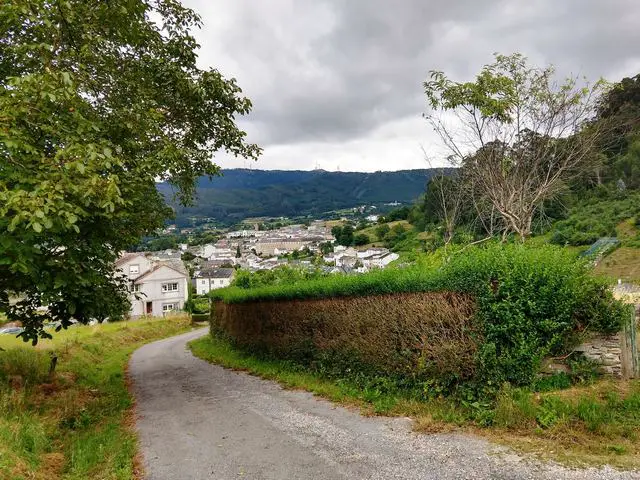
17. Beach Tourism
Beach tourism is how a beach plays a major element in the holiday, and it’s the most modern form and the staple of tourism.
In beach tourism, tourists travel to a beach for leisure, recreation, or business purposes. People who like the clear blue sight of a beach undertake this journey.
Popular Beach Destinations: The Maldives, Seychelles, Turks And Caicos, French Polynesia, Africa , Queensland, Australia, Philippines, Thailand, Bali In Indonesia, Lakshadweep, Goa, Puri, etc.
Why is Beach Tourism important?
- Beach tourism has brought about many economic benefits.
- It has led to the building of many attractions, resorts, etc.
- Beach resorts help in meeting the increase in intra-regional demand and domestic demand.
- This type of tourism creates numerous employment opportunities.

Negative Impacts of Beach Tourism
- It leads to the wastage of a lot of resources and space.
- Beach tourism pollutes water and environmental resources.
- Building new berths, marinas, etc., hurts coastal and marine life.
18. Space Tourism
We have seen significant changes in the aviation industry in the last 100 years. What was once used for warfare and cargo transport is now used for traveling.
Human development has now broken all bounds to take this journey to the vast emptiness of space.
Russia has been the pioneer in this field. Soyuz spacecraft conducted its first space trip with American businessman Dennis Tito in April 2001.
It was a government spacecraft that conducted seven space expeditions within the next six years. This surge in public interest led other organizations worldwide to dive into this area.

There are different types of space tourism
Orbital Space Tourism: These flights remain within an orbit around the Earth at a speed higher than suborbital space flights. These flights orbit the world constantly for their entire stay in outer space.
Sub-orbital Space Tourism : This was the beginning of space tourism. The spacecraft launches with a substantial initial velocity that pushes it out of the Earth’s atmosphere. But this doesn’t throw it entirely out of the gravitational sphere. The power is insufficient for orbiting, so it freezes once the engines are shut off.
SpaceX C.E.O. Elon Musk proposed the prospect of lunar tourism. In 2018, he announced the ‘Dear Moon Project,’ the highly anticipated first lunar space tourism mission. They will carry out this project in 2022 with Japanese billionaire Yusaku Maezawa.
Space Tourism cost
The cost of each sub-orbital trip on the Soyuz spacecraft is reported to be 200,000-250,000 million U.S. dollars. Other trips carried out by different organizations were priced around the same margin.
Virgin Galactic recently announced that each ticket would cost 450,000 USD for the upcoming missions.
Space Tourism companies
Even though the industry is still up and coming, massive companies dominate the market. Space Adventures of Virginia, U.S.A, was the first successful space tourism company.
Elon Musk’s SpaceX, Richard Branson’s Virgin Galactic, and Amazon C.E.O. Jeff Bezos’s Blue Origin are all set to launch their space tourism business by 2022. Blue Origin recently conducted its debut flight with Jeff Bezos.
Oliver Daemen and Wally Funk were the world’s youngest and oldest men in space, respectively.
Space Tourism advantages
The universe and outer space have always been intriguing subjects for people on Earth. Yet, there were limited resources to satisfy their curiosity. The option of space tourism thus connects people with space in a unique way and solves its mystery. A more ecological advantage is the waste policy.
There is minimum pollution associated with these travels. Also, this allows a whole new sector of job opportunities for highly educated professionals and ambitious youth.
Top 13 list of space tourists
- Dennis Tito (American): April 28 – May 6, 2001
- Richard Branson
- Gennady Padalka
- Guy Laliberté
- Eytan Stibbe
- Sian Proctor
- Mark Shuttleworth (South African / British): April 25 – May 5, 2002
- Gregory Olsen (American): October 1 – October 11, 2005
- Anousheh Ansari (Iranian / American): September 18 – September 29, 2006
- Charles Simonyi (Hungarian): April 7 – April 21, 2007[8]
- Richard Garriott (American): October 12 – October 23, 2008[9]
- Sheikh Muszaphar Shukor (Malaysian): October 10 – October 23, 2007
Space Tourism in India
Space activities, in general, have been quite a staggering section in India. Last year, the government announced a policy that opens space exploration to private sectors, but hardly any company has taken action on it.
Entrepreneur Santhosh George Kulangara will be the first Indian space tourist as he booked his spot on a Virgin Galactic space flight in 2007. Hopefully, he will join Dennis Tito, Mark Shuttleworth, Gregory Olsen, and many more this year.
Forms of Tourism
- Atomic Tourism
- Beach Tourism
- Bicycle Tours
- Eco-Tourism
- Geo-Tourism
- Industrial Tourism
- Rural Tourism
- Space Tourism
- Sports Tourism
- Sustainable Tourism
- Virtual Tourism
- War Tourism
What is the main purpose of tourism?
- Economic Sustainability: It ensures the effectiveness and competitiveness of tourism destinations and enterprises. It helps continue improvement, which is beneficial in the long run.
- Local enrichment: Tourist destination prosperity is an enormous part of tourism. The tourism business continuously maximizes the economic growth of the host destination.
- Employment Standards: Tourism supported the level of wages, terms of service, and availability for all. It creates local jobs without discrimination based on gender, race, disability, or other means.
- Local management: Involve local communities and empower local people for planning and decision-making. The community and tourism management team helped to develop this.
- Community Welfare: Maintain and boost the local community’s lifestyle. They are part of social structures. But surely, this process should take place with no social humiliation or exploitation.
- Natural Integration : Maintain and improve the quality of both urban and rural landscapes. It avoids natural and visual degradation of the environment.
- Natural Integration: Maintain and improve the quality of both urban and rural landscapes. It avoids natural and visual degradation of the environment.
- Biodiversity: Another purpose of tourism is to assist in conserving wildlife and natural wildlife areas and reducing losses.
- Environmental cleanness: Besides the purpose of tourism, all tourists must reduce air, water, and land pollution and waste generation.
- Tourism is a significant part of national integration .
- Tourism always motivates tourists to understand their traditions, heritage, culture, and religion.
- Tourism’s most significant part is economic growth or the business part of the destination. It encourages local people to create handicraft items and prepares local food items, souvenirs, dresses, etc., for sale.
- Tourism is one such thing that constantly boosts the country economically.
Niche Tourism
This tourism focuses on a specific aspect of traveling. It also focuses on the consumer market segment’s interest. It makes the destination more exciting and marketable. Niche Tourism is one of the fastest-growing sectors. Niche tourism indicates a specific feature of travel.
For example, some tourists want a museum, some wish to visit old architectural monuments, buildings, palaces, etc., and some want to eat in a famous restaurant. Thus, niche Tourism shows a particular activity that is not the only focus of travel.

Types of Niche Tourism
- Macro-Niche
- Micro-Niche
What is Macro-Niche?
Macro-niche tourism can be explained as a niche with broad customer interest categories such as rural tourism, Business tourism, sports tourism, medical tourism, environmental travel, etc.
What is Micro-Niche?
It is a small group trip, such as gastronomy tourism, cycling tourism, and geo-tourism.
Niche tourism in South Africa
South Africa is an attractive destination because of the wide diversity of animal and bird species. As a result, tourism professionals found this country has considerable potential.
Advantages of Niche Tourism
- Even if niche tourism is smaller than mainstream markets, it spreads more.
- It has more potential to grow.
- It creates quality jobs that require specialized skills.
What are the different types of tourists?
When we visit a place, we find different kinds of travelers. The aim of each traveler is different. Let us discuss the types of visitors. Five types of tourists are found mostly :-
- Incentive tourists – These tourists did not plan for the tour earlier. Suppose you have been rewarded with two tickets from the office because of your performance. You and your colleagues came for the trip.
- Business tourist – This type of tourist travels for business. They will always prefer a hotel with a conference room. They don’t come to enjoy luxury, but they want the hotel to serve everything on time.
- Leisure tourist – This type of tourist comes to enjoy the vacation. They love those hotels that serve them something extra, like drinks. They choose hotels that give them comfort and luxury at their best.
- Special interest tourists – They often plan their tours very well. This tourist doesn’t need comfort but loves to do adventure.
- The Foodie tourist – This type is quite common. They wish to taste various foods in various places. The signature dishes of those areas and various kinds of foods.
Types of a Tourist Attraction
We have to keep in mind that attraction varies from person to person. For example, suppose Rahul and Sheela are traveling to Kashmir. Rahul is interested in climbing the mountains to see snowfall, whereas Sheela is excited to visit the temples in Kashmir.
Tourist attractions could be classified into the following two categories:-
- Natural attraction – If you are a nature lover, don’t miss The Valley of Flowers in Uttarakhand, Coorg, known as the ‘Scotland of India.’
- Events and heritage attractions – Goa is a place for heritage lovers. So pack your bag, take the camera, and start your journey towards Goa. I am sure you will have an unforgettable lesson in Goa’s history. Fort Aguada, Chandor, and some famous museums are places to visit.
What is Tourism Planning?
Perfect planning is always a matter of the success of any activity. Whenever we plan something and implement it, we get a better result. It’s the same with tourism. But it is neither guaranteed nor forever. It’s a process where the people’s needs are determined using the best resources, programs, and activities.
How do these tourism plans help us?
A tourism plan makes guidelines for the areas. Then, it helps the government and private sectors to develop those areas. Most importantly, we must remember a few steps involved in tourism planning.
Main types of tourism planning
- Financial planning
- To establish the objective
- Human resource planning
- Monitoring progress
- Human resource planning.
Types of Tourism Activities
There are various kinds of tourism activities. Like-
- Heritage trails
- Swimming with dolphins

Name of some international tourist organization-
- American Society of Travel Agents : Founded 1931, Headquarter- New York
- International Academy of Tourism : Founded-1951, Headquarter- Monge Carlo
- International Bureau of Social Tourism : Founded 1963, Headquarters- Brussels
- International Touring Alliance: Founded-1919, Headquarters- Europe
- World Tourism Organization : Founded 1975, Headquarter- Madrid.
Types of Tourism packages
For different categories of tourists, everybody needs a separate package. Let’s discuss the various types of Packages that are available.
1. Adventure Tourism Package
This tourism encourages people to come out of their comfort zone to feel the thrill of nature closely in life. It is found that people are taking adventure more often. It shows potential growth in recent years.
The most exotic and adventurous destinations are Ladakh, Himachal Pradesh, Kerala, Jammu, and Kashmir.
2. Wildlife Tourism Package
In every country, wildlife tourism is famous. But, if you love wildlife, you must choose the right package. This package is exclusively for wildlife lovers who love taking their snaps.
3. Medical tourism package
It has been observed that medical tourism has grown rapidly in Asia-specific countries.
4. Pilgrimage tourism package
Many foreigners visit various temples in India, Sri Lanka, and Singapur. However, the major attraction is the traditional architecture, art forms, and rituals performed.
Famous pilgrimage areas are the Meenakshi Temple, Golden Temple, Jagannath Temple, Santa Cruz Cathedral Basilica, Atala Mosque, etc. Therefore, this type of package is chosen based on your religious beliefs.
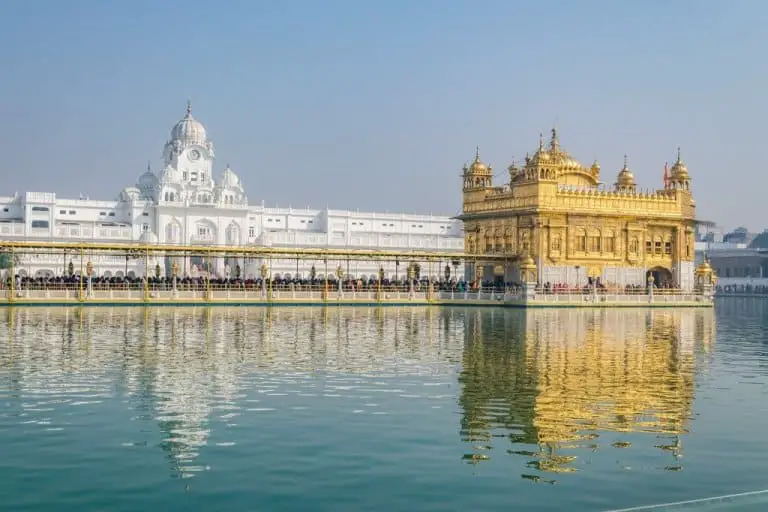
5. Eco-tourism Package
This type of tourism has become one of the fascinating travel forms. Although eco-tourism is more of a travel philosophy, it attracts many tourists. Some eco-tourism destination areas are Kerala, Galgibaga Beach, Goa, and Coorg.
6. Cultural Tourism Package
The social richness of any country draws visitors from every corner of the world to witness sheer celebrations. The cultural tour package offers you a comprehensive exploration of the different shades. Moreover, this package will bring a tourist a closer view of traditions and architecture.
Along with these, we found tourism packages like-
7. Family Tourism Package
A family tour package is designed keeping in mind the family’s needs. It gives assurance of total relaxation and fun pastimes.
The package includes adults, kids, and the elderly. This package includes sightseeing trips, tours of historical places, and adventure trips.
8. Honeymoon Tourism Package
Couples, after their marriages, take a honeymoon tour package, and it provides newlyweds with all the perquisites to make their trip memorable.
The honeymoon tourism package includes lodgings, dining, food & drinks, etc. Famous destinations for a honeymoon tour package are Maldives, Bali, Mauritius, etc.
9. Wellness Tourism Package
Traveling to other places for health and well-being takes a wellness tourism package. Tourists take this package to visit sites that provide recuperation facilities. Wellness tourism has seen a significant boost in the modern years.
Popular destinations for a wellness tourism package are Ayurveda centers, Iceland (for its spas), Bali (for yoga), etc.
10. Cruise Tourism Package
A cruise tourism package provides tourists with a journey filled with fun and recreational activities onboard and excursions onshore.
Tourists get an all-planned ship or boat trip for a specific date to a particular location at a specific price. These packages are curated as per the needs of the tourists.
What are Tourism Products?
According to the market’s needs, the customer supplies anything in the market for use/consumption, called a product.
A product can be offered in the market observation, purchase, use, or any need or demand.
A tourism product is provided to the tourist during their traveling. It mainly focuses on facilities and services designed to meet the needs.
It includes physical objects, services, personalities, places, and ideas. The above components are provided by one company or any group of companies. Tourism products can be given to tourists in a tourist destination.
Products are needed for leisure, pleasure, religious, or business purposes. These products are provided in the market at a cost.
The main reason for choosing a tourist destination is a tourism product. It gives an economic boost to the destination. So it needs to be marketed and stored in a hassle manner.
Services are designed for the visitor to fulfill their needs. Therefore, it is a combination of products. Thus, the country’s total tourism and tourist satisfaction depend on the sum of its attractions, transportation, accommodation, entertainment, etc.
Individual service providers, such as hotels, airlines, travel agencies, etc, provide every element of a tourism product. Therefore, you can analyze these products’ attractiveness, accommodation, and accessibility.
Types of Tourism Products
Attractions: It is one of the main elements. Tourists will not be encouraged to visit certain places without attractions. Attractions are the ingredients. The product determines the choice of a particular tourist to visit a specific destination.
Attractions include archaeological, cultural, and historical buildings, monuments, beach resorts, mountains, flora and fauna, national parks, trade fairs, arts and music festivals, exhibitions, games, etc. Nowadays, tourists are susceptible to changes in fashion.
Accessibility: That means by which a visitor can reach the attraction place. Tourists visit the attraction destination by different transport modes. Visitors visit his predetermined location by car, motorcycle, train , ship or boat, airplane, or cycle.
The place becomes very cheap if any destinations do not have good transport systems. Tourist centers should be located near tourist-producing markets. It is connected to a network of efficient transportation to receive the largest number of tourists.
Accommodation: Another tourism product is accommodation. It is an essential part of tourism—the tourist destination location must-have hotels, guest houses, camping, and homestay. An alternate arrangement should exist if accommodation is not possible at the central location. At least some distance away.
Hospitality: It is a major factor for a tourist destination that will develop in the future. The location’s restaurants, pubs, cafes, foods, and beverage serving style increase location attractiveness.
Natural tourism products: Our nature is beautiful and precious to us. Nature has arranged amazing things in different parts of the world, such as – hills, mountains, caves, glaciers, sea, islands, beaches, waterfalls, rivers, lakes, wildlife, deserts, etc.
The tourism product utilizes those natural gifts as a Natural tourism product, such as snow-capped mountains in Kashmir, Dudhsagar Falls in Goa, palm-fringed beaches of Goa, the wildlife of Kaziranga National Park in Assam, the Thar Desert in Jaisalmer, etc.
Read Things to do in Bainbridge Island, Seattle Washington
Human-created tourism products
Artificial tourism products are those that humans create. Human-made tourism products’ primary purpose is to attract tourists, such as Temples, Forts, palaces, museums, theme parks, etc.
The destination’s tradition and culture play a vital role in tourism. Humans maintain it to attract tourists through- classical dance – music, folk dance, paintings, handicrafts, festivals, fairs, etc.

Examples: Machu Picchu World Heritage Site, Egyptian pyramids , Taj Mahal, Red Fort in Agra, Lothal in Gujarat, Mexican pyramids, or Mesoamerican pyramids are important archaeological sites.
The Bhangra dance form of Punjab, the Kolkata Book Fair, the Durga puja in Kolkata, the Brass work of Muradabad, etc., are also included in human-made tourism products.
Tour guides are another main aspect of traveling. It is also a parameter for tourism. National and international travelers need a travel guide to discover a new place. Sometimes, national travelers may visit any tourist destination on their own.
But an international traveler always wants a good tourist guide. How do you present the location, and how much information do you provide to understand the place? It depends on a guided tour and a travel guide. This parameter upgrades the tourist destination’s level.
What are the different types of tourist destinations?
Types of tourism and types of tourist destinations may sound synonymous. However, the two have slight conceptual differences. Tourism is a broader concept, including the aspects of tourism and hospitality.
At the same time, a tourist destination is a narrower concept applying to places of tourist attraction. Based on the type of place and the causes of interest, the tourist’s destinations are:
- Coastal Destinations – Preferred mostly for the ample sunshine and salty waters lining lands adjoining the sea. Be it domestic or international coastal locations, they are great for fun and relaxation. They are favored mostly by people living in inland areas away from the sea.
- Beaches – The meeting point of land with the ocean offers a great tourist attraction. Waves hitting the shores of sandy beaches are great for tourists. In addition, new beach activities like parasailing, beach biking, etc., also attract tourists immensely.
- Island – A land in the middle of the sea or ocean on all sides is an island. Tourists are taken mainly by boat from the mainland to explore these islands. Islands standing in between a river are called riverine islands.
- Mangroves – It offers a panoramic view amidst the confluence of a river with the sea/ocean. Example: Sundarbans of India.
- Inland Destinations – Travel away from the coast is an inland destination. A variety of sub-classifications can come in under like:
Based on the type of region:
- Hill stations – Offering a surreal view from an altitude, all mountains and hills are great tourist destinations.
- Jungles – Trekking/hiking/driving through the wild greenery are great tourist attractions. Protected areas like Reserve Forests and National Park serve the twin purpose of tourism and conservation.
Based on the population structure
- Rural – For a change, get away from the fast-paced urban life to taste village life. Touring rural locations is gaining popularity because of lower population density, greener areas, and a serene environment.
- Urban – Posh urban destinations offer a pull factor for tourists to experience ultra-modern and urban life. Examples: New York, Shanghai, etc.
- Offbeat – Previously undiscovered newer locations around famous tourist spots are offbeat destinations. With lower tourist popularity, the exclusiveness of these places is retained.
Based on the type of activity
- Hiking and Camping – Places, where tourists come mostly for hiking or camping (day/night), are fast gaining popularity. These places are primarily amidst nature and come under adventure tourism.
- Preserved sites – Sites like UNESCO World Heritage sites have become popular tourist destinations. The rich natural/cultural value owes them their status.
Based on historical/religious importance
- Historical Places & Monuments – Tourists flock to places holding remnants of the past. Areas having historic architecture and events give an insight into the past culture. Examples: Taj Mahal and Jalianwallah Bagh, etc.
- Pilgrimages & Holy Shrines: Religious tourism has flourished here, making it a spiritual destination. Example: Hajj of Mecca, Bethlehem for Christians.
- Museums and buildings: Places where artifacts and remnants of historical culture are well preserved. Famous among tourists of all ages.
Based on entertainment
- Luxury destinations: Locations that only promote high-end tourism are luxury destinations. Example: Bali.
- Carnival: Annually, countries host cultural events to celebrate any occasion for a short period. When tourists travel here to enjoy themselves, it becomes a popular destination. Example: Christmas Carnival in Toronto.
- Amusement Park and Zoo: Famous for the lot is Disney Land, a great tourist destination for children. Singapore Zoo, which ushers in global tourists.
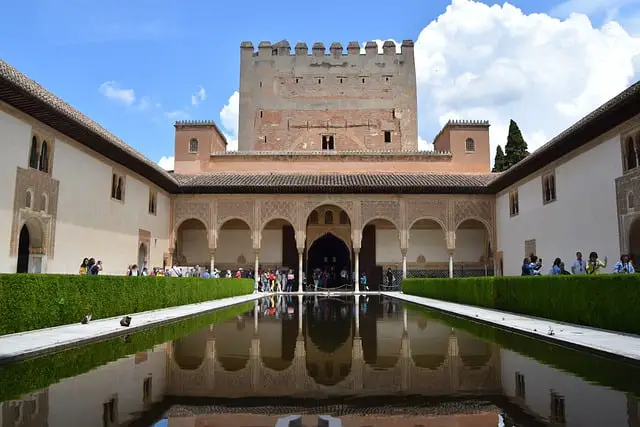
Tourism Destinations
According to UNWTO in the “World’s Top Tourism Destination,” the first four places for International tourism are France, Spain, the USA, and China.
A tourism destination is the endpoint of the journey. But, of course, we all have some goals in every field, so it’s the same with tourism.
There are various types of tourist destinations. They are as follows:-
- Centered Destination
- Based Destination
- Multi-centre Destination
- Touring Destination
- Transit Destination
Types of Tourist Attractions
- Historial attractions
- Cultural attractions
- Political significance
- The natural or scenic beauty
- Leisure travel
- Fun and Amusement
How many Types of Tourism are there in India?
There are 16 Different kinds of tourism in India , but the list may increase.
Is there anything about tourism that I’ve missed?
Over the past 75 years, the travel industry has made great strides in harmoniously uniting strangers, travelers, and locals. As a result, visits and travel are more than adventure, learning new skills, rejuvenating, and achieving perfection.
Tourism has changed from providing services like rooms, flights, and meals that people were satisfied with ten years ago. Now, people want to experience whale watching or mountain biking.
In the luxury sector, wealthy people spend more money on an experience than objects. It is called experience economics, and there is an idea that the memories of tourist values are compared to some physical resources. The rate of global tourists is increasing daily, and every country is trying to make its tourism more developed and successful.
As you can see, the tourism industry is vast and diverse. There are different kinds of tourism here; some have been around for decades, and others are just emerging.
A tour to the Grand Canyon would fall under which type of tourism?
Grand Canyon tour would fall into natural adventure tourism. Here, you can enjoy – The floor Landing Helicopter Tour, ATV, Gold Mine Tour, White Water Adventure Tour, and Rim Airplane Tour.
Kindly Stay 5 Seconds More and Share this Article.
HI TRAVELLER …Myself Ruma Dey Baidya. I’ve been backpacking for the last 20+ years. Photography and travelling have been my passion since my childhood. Whenever I got an opportunity, I never missed it. I am not a solo backpacker, so I always try group travel. I prefer budget travel, and it also helps me to save expenses. We know that memories are not constant, so I decided to document them and created this travel diary. This website [ TheHolidayStory ] is dedicated to those who passionate about travel like me. Please feel free for any information related to my blog. I am always happy to reply. Mail id – ruma[@]theholidaystory.com

The 21 Different Types of Tourists
There are different types of tourists around the world. These tourists typically specialize in a single type of tourism such as cultural holidays so they can be easily categorized.
While many tourists are generally interested in multiple aspects of holidaying, some simply prefer to stay in line with very specific interests as follows.
Table of Contents
1. Adventure tourists

Adventure tourists are considered the most daring out there. These people are very active and they breathe experiences. Adventure tourists can be locked in a resort for a couple of weeks as this would simply ruin their vacation. They need action, change of scenery, meeting new people, and experiencing new things.
But what is adventure tourism? This style of tourism often involves outdoor adventures such as safari escapes, or desert dirt bike rides. It can involve any activity that is considered adventurous.
Adventure tourists are known for their high interest in getting into new experiences. If many tourists aren’t willing to travel far for their passions, this can be different for adventure tourists.
For example, some of the most unique swimming with the sharks’ experiences are very remote. Yet, adventure tourists always travel to these locations for the experience.
The most important word to describe these tourists is ‘experience’. All adventure seekers are normally interested in the experience more than being interested in simple everyday activities that are repetitive and monotone.
Adventure tourists aren’t afraid of looking beyond comfort as well. These holidaymakers aren’t always seeking to sleep in the most luxurious hotels. They might even sacrifice personal comfort for the awaiting experience.
2. Backpack tourists

Backpack tourists are typically frugal and interested in multiple aspects of tourism. As their category name suggests, these tourists are normally only traveling with a backpack. This is where they keep clothes, shoes, sunglasses, charges, and even food. Traveling with a backpack isn’t easy. You have to carry it around with you all day.
So why do backpack tourist numbers increase year by year if it’s so difficult to carry a backpack all day? The first reason has to do with economics. It’s simply more affordable to stay in backpack hostels and bed and breakfasts than to stay in typical hotels. It’s also less worrying as these tourists have all their belongings with them at all times.
Most importantly, backpack tourism is fun. Those into this type of holidaymaking aren’t afraid to put on sports shoes and comfortable clothing and get moving. They can see and experience multiple other aspects of their traveling location compared to other tourists.
Backpack tourists also differentiate themselves from adventure tourists as they can be into different aspects such as seeing cultural landmarks and even traveling for good restaurants. They can combine all aspects of tourism with an adventure into a unique budget-friendly type of holidaymaking.
Shortly called ‘backpackers’ these tourists are seen everywhere from busy city streets to remote mountain paths. They are generally highly self-driven and they require minimum guidance to get around as they like to plan.
3. Business tourists

Business tourists are a bit more difficult to stop compared to backpackers. Normally traveling for work purposes, business tourists are mostly interested in their work duties. Of course, things change during the day when these work duties are over.
Known for their tight schedule, business tourists are typically interested to discover the area where they need to work for a while. This means they can jump into the typical tourist attractions, check out local museums, restaurants, and parks.
Business tourists are normally blessed when it comes to expenses. Most business tourists have their transport and accommodation costs covered. This then means they might have money to get into shopping or to other activities that aren’t specifically free.
Those who travel for business are rarely called tourists, however. It’s only the group that has the time to become part-time tourists that are lucky enough to discover new places. There are plenty of professionals traveling for business with no time for holidaying.
New York is the number one business tourist destination. Known for its high number of business and economic development, the city also offers plenty of world-class landmarks to visit, making it the perfect stop for business tourists.
4. Cruise tourists

A special type of tourist is only interested in going on a cruise. Many cruise tourists are seniors and seeing the world from a cruise ship is often a yearly holiday for them. Carnival Cruises and other similar companies offer complete tourist packages for these seniors. Almost all of them have the freedom to choose which countries they want to visit as cruises take tourists on different types of tours.
Some cruises are only bound to the Gulf of Mexico. Others travel around Central and South America. There are also very popular Mediterranean cruises for those who want to travel along Southern Europe’s coast from Portugal to Greece with stops in Spain, France, and Italy.
The main benefit of these cruises is they allow their customers to see different countries as special port stops are planned along the route.
Cruise tourists have also been known to be among those who love long holidays the most. There are plenty of cruses that last more than a month and this type of adventure can certainly count as the summer holiday.
Cruise tourists generally travel in couples or small groups. It’s rare to find solo cruise tourists. Most cabins available on cruise ships are for couples. This is why they can be the ideal type of escape for tourists and couples who want to relax for a few weeks.
Most cruise tourists appreciate good food, drinks, and the ability to socialize on the ship. This is why all cruise ships offer one or multiple restaurants, a common socializing area, a sunbathing deck, music nights, and even casino nights. This is why some tourists even prefer not to step off the ship even when docked as all amenities are covered for them.
5. Cultural tourists
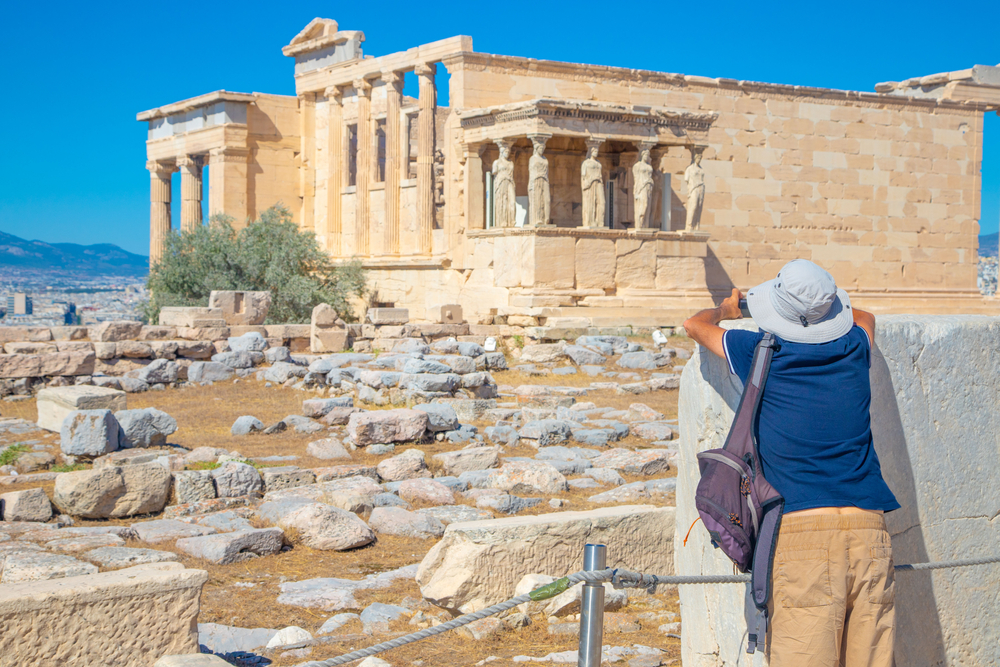
Culture is a sub-niche of traveling. Culture travelers differentiate themselves considerably from others as they choose different destinations to the typical beach resort escape. They might even travel to the same places as others but they visit different attractions.
As their name suggests, cultural tourists are into the culture. This vast area of interest typically covers, history with its museums, education with learning opportunities, ethnographies with its traditions, etc. Being a cultural tourist means you check out all of the cultural attractions of your destinations such as theatres, cinemas, and old cathedrals.
A cultural tourist is typically traveling at a slow pace so there’s sufficient time to admire and participate in different cultural events. Most cultural tourists can be seen in museums. Offering a glimpse into the history of an area, museums are ideal for cultural tourists as they often meet other tourists from around the world also interested in culture.
Cultural tourism flourishes in historically-rich cities and countries. Italy, France, and England are some of the most visited cultural hubs around the world. Italy’s renascence period with its painters, sculptors, and architects still attracts millions of tourists from around the world. These tourists are there to see these aspects that are unique to Italy as they can’t be reproduced anywhere else.
Being a cultural tourist also has its downsides. As every place is unique, cultural tourists typically want to visit more places that require a considerable budget. Visiting London is an experience that is certainly enriched by visiting other British cultural hubs such as Durham or Oxford. All of these cities can offer a combined cultural vacation of at least a week.
6. Domestic tourists

One of the main categories of holidaymakers is represented by domestic tourists. These travelers are typically interested in what their native countries have to offer. Domestic tourism means discovering locals places within the country.
Domestic tourists travel by airplane, car, bicycle, or they even hitchhike. This is one of the most important aspects when it comes to discovering and rediscovering your own country.
All domestic tourism is typically based on the same rules and international tourism, with a busy season where an influx of travelers is expected. For most tourists, it is also a good opportunity to look at what makes their country great.
Domestic tourism incorporates all other types of tourism. Its sub-niches include cultural domestic tourism, culinary domestic tourism, adventure domestic tourism, leisure domestic tourism, etc.
Domestic tourists are also typically interested in multiple aspects of their travels. Visiting a city or a region is typically accompanied by discovering its main touristic attractions and things to do.
7. Eco-tourists

Eco tourists are a growing niche of travelers highly preoccupied with sustainability, ecology, and general nature care. This type of tourism is growing fast around the world and it has a minimalistic approach with a reduced impact on the environment.
Riding dirt bikes through green fields is not ecotourism. But cycling through rural areas is considered eco-tourism, with its care for nature.
Most eco-tourists travel by car or plane to a certain destination. But they can also travel by bike or even walk multiple days to reach a destination or to experience all that it has to offer.
Rural Italy offers great world-class eco-tourism destinations. Small family farms here show tourists how to live like a local, cook like a local, and even how to care for animals.
There’s a modern side to eco-tourism as well. All types of reduced environmental impact technologies such as e-bikes are included in guided eco-tourism tours.
Most eco-tourists appreciate a way of life that cares for nature and what it has to offer. This is why excessive waste isn’t characteristic to these types of tourists which tend to be the best when it comes to not leaving traces of their visit even when out in nature.
Eco tourists are also smart when it comes to limiting the resources they need on holiday. This is why this type of tourism is often characterized as affordable. But it can still be expensive with the exception that these types of eco-tourists know how to make the most from very few resources.
8. Food tourists

Food tourists are a special type of gourmand holidaymakers. Food tourist travels their country and other countries to eat diverse foods. This type of tourism is flourishing in the conditions in which foods become more standardized in developed nations and since certain meals can only be experienced among the locals who make them often.
Among food tourists, there are plenty of sub-divisions such as vegan food tourists or Asian food tourists. All of them are interested in very specific aspects of food. But most food tourists have an open mind to all types of foods and countries.
Cultures influence food considerably. This is why learning about culture often means tasting the food it makes and seeing what characterizes its delicious taste.
Food tours are now offered constantly by travel agents. Some of the best food travel destinations are those in South East Asia. Thailand is one of the specific destinations for good affordable food. Italy is also known for its rich culinary history and people from all over the world make it here to eat unique pizza and pasta.
But food tourists can also travel by themselves. To be considered a food tourist, travelers have to specifically set out to a certain destination for its food. But food tourists can also be found inside the country. Seattle and New York are cities with a rich culinary history.
Texas is known as the state to be in when it comes to stakes. People travel to these locations to eat the best foods as made by those with cooking experience.
Food tourists are also responsible for making various restaurants famous. For example, some of the best Michelin-star restaurants in Spain and the world are located in often isolated locations in small towns and even in villages.
Food tourists travel long distances to reach these restaurants. Once there, they get to eat the food made by famous chefs and they often taste delicious meals made with entirely local ingredients. These tourists are generally known for a culinary passion.
9. Generalists

Generalist tourists are a combination of all types of tourists. These travelers set out to a certain destination with an open mind to experience as much as it has to offer. A generalist tourist can look at a certain style of architecture one day and be interested in the food of a city the next day.
All generalist tourists are typically looking into a holiday experience. This means accommodation and even traveling to multiple places within the region is of interest.
Most holidaymakers are generalists. They travel to different locations with a plan to see its tourist attractions, check out its museums, and even get immersed in unique experiences.
Generalist tourism isn’t characterized by traveling to certain destinations or in a given timeframe. It is characterized by the general will to travel. This is why it can look very different from one tourist to another.
Those who like to travel often describe themselves as tourists, but this generally involves being a generalist tourist.
10. Holiday tourists

Holiday tourists are those travelers that mainly go on holidays when traveling. A holiday is typically a period of at least a few days to relax away from home. Holiday tourists are the most popular type of travelers, especially among families.
Holidays are planned once or multiple times per year and this means taking time away from work and typical chores to travel.
You can see holiday tourists especially around resorts, beaches, camps, and all other locations typically associated as touristy. Florida is a good example of a holiday tourist state. It attracts people from all around the world who say the visit to the sunny state is a ‘holiday’.
The English expression ‘I holiday in’ refers to taking a yearly vacation in a certain location. This is why holiday tourists are those travelers who are typically on a longer vacation, typically the summer vacation which is the longest for most.
Holiday tourists can travel both by themselves and in groups. A holiday can be taken as a way to relax for health purposes. A doctor can recommend going on a holiday for patients under constant stress. Going on holiday is seen as taking a few days up to a few weeks off to relax completely and to have the occasion to reduce stress by worrying less.
Those on holiday are typically using the term in different situations. But their expressions can sometimes be confusing. ‘Holiday food’ is the food made at home, typically during religious celebrations such as Christmas or Easter. Holiday food is rarely used to refer to the meals consumed while away on a summer holiday.
11. International tourists

Most tourists are willing to travel to almost any location. But among general travelers, there’s a distinct category only willing to travel abroad. Many reasons make international tourists only consider holidaying abroad.
Among them is the experience of visiting most tourist attractions in their own countries. Another reason can be the appeal of a certain destination, particularly for its popularity.
International travel is at an all-time high in recent years. With the advent of low-cost air travel companies, the opportunities and the cost of international travel are in the favor of travelers. A large percentage of international tourists are planning their holidays accordingly as this is the type of travel that mostly rewards those who plan.
The perks of proper planning for international tourists include finding the lowest airplane ticket fares and the best accommodation prices. International travel can also be subject to extensive paperwork such as visa applications, proof of income, proof of residency, etc. While highly rewarding, international tourism can also require a bit more preparation than domestic tourism.
International tourists are also some of the most open when it comes to travel destinations. From the classic locations such as France and Spain to the most remote international travel locations such as Iceland, these travelers are typically willing to make an effort to reach the destination.
One of the perks of international travel is getting immersed in different cultures. This can be a bit more difficult to achieve with domestic travel. Major travel channels now recommend remote international travel due to the current pandemic. This is why Antarctica is one of the most remote international travel locations that gets recommended today.
12. Leisure tourists

Leisure tourists are a type of generalist travelers. These tourists are interested in taking a break from reality, seeing new places, eating new foods, experiencing new adventures, but without sacrificing rest and comfort.
Unlike backpackers or adventure tourists, leisure tourists also feel the need to relax while traveling. This is what makes them even more interested in locations with good accommodation options.
Leisure tourists are generally characterized by a slower pace of travel compared to adventure tourists. They like visiting the most popular touristic areas in their destination. Cultural experiences can’t be overlooked by these tourists as well.
Apart from visiting landmarks, leisure tourists also appreciate good diverse food options. All in all, these types of tourists are among the most proficient when it comes to making the most of a trip and coming back come reinvigorated.
13. Medical tourists

Medical tourists are known as patients who travel for healthcare purposes. Both incoming and outgoing patients have been increasing in the US. There are a few factors that influence these two trends.
Incoming patients to the US are typically those coming for a very specific medical intervention. The high number of specialized doctors in the US makes it an attractive country for those coming from smaller countries where there isn’t a great selection of doctors or where there are no proven interventions for a certain condition.
Outgoing US patients are leaving for other smaller countries to get cheaper and often free medical healthcare. Medical insurance costs are constantly rising in the US and this makes it the country almost impossible to get medical treatment for those with a certain condition that isn’t covered by insurance.
US citizens prefer to travel as little as possible to get medical healthcare. Most don’t head to Europe but rather to Central and South America. Costa Rica is the main destination for US medical tourists. Patients head to the country for a few weeks and even for a few months. They might be recommended a rest period under supervision for a certain medical intervention.
The number one reason for US medical tourists outside of the country is dentistry work. All dentistry interventions in the US are considered among the most expensive in the world. It’s a routine to see US citizens traveling abroad only for a few days to get work done on teeth and for other oral care interventions.
Mexico is another popular destination for US citizens seeking to travel to get better healthcare. The proximity of the country, its low prices, and high numbers of doctors and clinics make it a viable option for medical tourists.
While further away from the US, India is also a top destination for medical tourists. Doctors here are some of the best-trained in the world. Since most also speak English, their medical services become tempting to US citizens. Singapore also gets a high influx of US medical tourists. Some of the world’s largest hospitals and some of the top-level doctors here make the small country highly attractive for patients who need complex medical treatment from around the world.
14. Reflective tourists

Reflective tourists are characterized by the wish to travel and learn. It can be said learning has multiple faces in the case of these travelers. Tourists can travel to learn more about a place but they mostly travel to learn more about their heritage, where they come from, and the culture of their genealogy.
Europe is the main destination for reflective tourism. The continent has been known for waves of mass-level migration, especially to North and South America. This is why a rising number of reflective tourists make their way to Europe each year.
But what do these tourists do that others don’t? Reflective tourists are normally interested in culture hotspots. They visit museums, churches, theatres, exhibitions, stadiums, etc. These are all part of a wider spectrum of cultural attractions.
But reflective tourists can also dig a bit deeper into their family’s history. They might even visit local administration to get a trace of their lost relatives and get in contact to learn more about their family’s genealogy.
Reflective tourists are increasing in places such as Spain and Italy. Largely impacted by mass migration over a century ago and even today, these countries have been the main attraction for reflective tourists from the US, Canada, and Argentina.
Many of these countries even have tourism agencies specialized in offering services for reflective tourists on discovery or rediscovery trips.
15. Religious tourists

Religious tourists are one of the largest groups of travelers. These types of tourists are normally interested in heritage historic places of worship tied to their religion. Religious tourism is growing year by year but it isn’t new. Old pilgrimages were made thousands of years ago such as the Camino de Santiago in Spain.
Religious tourists can be split according to specific religions and branches within a religion. Jews are normally interested in traveling to Israel. Even Jews who aren’t into tourism are typically interested in visiting Israel at least once.
Jews also travel to other Jewish communities around the world frequently. They can even pitch in to build new Synagogues around the world or to restore historic places of worship.
Christians travel to Israel as well. They visit Jerusalem and Bethlehem mostly, without any particular interest in larger cities such as Tel Aviv. Christians also visit cathedrals, churches, and monasteries around the world.
Christian tour operators organized different circuit visits to specific countries where tourists get to see some of the most important Christian landmarks of the area.
Furthermore, Christians also organized mass pilgrimage events around the world. Other popular Christian destinations include The Vatican, especially for Catholic Christians.
Millions of Muslims visit Mecca each year. The celebrations here are normally held throughout the year. Located in Saudi Arabia, Mecca is a place of worship with strict rules. Pilgrims here aren’t allowed to drink alcohol, according to Muslim tradition.
16. Rural tourists

Rural tourists are normally interested in traditional villages. These types of tourists exist around the world. Rural tourism is completely dead in some areas around the world but it is also very popular in other areas.
Locronan in the Frances Britany region is the country’s main rural hotspot. It enjoys easy access from mainland Europe. Broad Campden in England’s Gloucestershire region is one of the most visited classic villages in the country and the world.
Its small streets, traditional homes, and relaxed way of life make it a high attraction for many of those interested in traveling away from large cities.
The perks of rural tourism include a slower way of traveling. It also allows tourists to meet the locals and improve socializing opportunities. Staying in rural areas also means enjoying different hotels. Far away from cities, the rural hotel often offers more wide-open spaces which encourage walks and time spent outdoors.
Rural tourists also have a few drawbacks to face. For example, there are not many great public transport links to some small villages around the world. This is why renting a car is often a must when it comes to making it to some of these remote towns and villages.
Rural tourism depends on your means of transport but this is what also protects it from becoming overly popular to a dangerous extent.
17. Romantic tourists

Romantic tourists are some of the most relaxed when it comes to traveling. It’s often as much about the journey as it is about the destination with these tourists. Most couples into romantic tourism love gateways.
This is why those into this type of travel typically love to get out more, to explore, and not to be rushed as being away on holiday is all that matters.
Paris is the capital of romantic tourism. Walking the streets of this city is almost an experience worth the trip on its own. With plenty of romantic sights and great street-side cafes, couples can get to spend more time together in a relaxed atmosphere here.
Venice is another popular hotspot for couples. This is where tourists come to experience romantic gondola rides. Almost all of the couples here come to see the canals of the city. But there are plenty of other attractions for these tourists here.
Romantic tourists typically holiday through the year. According to tradition, the honeymoon is the most sought after the period for romantic gateways. Newlywed couples typically go away for a few weeks on the honeymoon, typically to one or multiple romantic destinations.
The specifics of this type of tourism are tied to accommodation requirements, good food, possible shopping opportunities, and the ability to go on long walks. Since romantic tourists like long walks, the most important aspect when choosing a destination is safety, especially for evening time walks.
18. Senior tourists

Seniors love to travel. Since they’ve reached an age when they don’t have to take care of the children or when they don’t have to go to work, seniors can often go on longer holidays further away from home.
Tourism for seniors is increasing in popularity. Two separate types of tourists can be found among them. Couples and group senior tourists are the two main types of travelers seen among the elderly.
Senior couples prefer romantic relaxing locations. Being out in nature or even visiting some of the most important tourist cities around the world are attractive proposals to senior tourists.
Group senior tourists are also popular. Seen in every large city around the world, these groups travel together, they eat in the same places, and they visit the same attractions.
The benefits of traveling in groups as seniors include better safety, the opportunity to socialize, a pre-planned trip, and plenty of opportunities to have fun.
19. Slow-paced tourists

Slow-paced tourists are travelers who like to stay more in a certain location. Instead of spending two days in a city or village, these tourists can spend up to a week in a location. Slow-paced tourism can expand to holidays that take up to a month or even two months.
The benefits of slow-paced tourism are that it allows further discovery opportunities and more socializing opportunities. Slow-paced tourism is ideal for those interested in a cultural or discovery type of experience.
Villages in Germany are known for slow-paced tourism. People come here to see various traditions. They see livestock and farming that typically requires a slower pace of travel.
The benefits of slow travel are that it allows a deeper understanding of a certain culture. But even these types of travelers can be split into multiple sub-categories.
For example, slow-paced tourists can be interested in only visiting a country in appreciation for a certain personality. Slow-paced tourism developed the sub-niche of Shakespeare fans tourism in England.
20. Special interest tourists

Special interest tourists generally visit a location for one thing only. This can be anything from a sports adventure opportunity or to visit a famous landmark. Examples of special interest tourists are seen all across the world.
Most special interests are tied to a historic location, a sports occasion, an individual, or a religious significance place. For example, tourists only go to Santiago de Compostela to visit the city’s cathedral. The same one-attraction or one-activity type of tourism is seen all around the world.
21. Sports tourists

Sports tourism is at an all-time high. This type of tourism isn’t new, but the rise of sports and sports personalities makes people travel. Sports tourists often travel with their teams. Baseball fans and football fans often travel to support their teams.
But these tourists can also travel without a specific sporting event in mind. They can travel to see stadiums or they can travel to see important places in sports.
One of the most visited stadiums in the world is Camp Nou in Barcelona. This is the home of the most popular sports team in the world, FC Barcelona. The stadium sees millions of tourists per year. A large number of them only come here to see the stadium and the place where their favorite football players play.
Sports tourism has plenty to offer all around the world. The second most popular football team in the world is FC Liverpool. Its stadium is normally visited by thousands of tourists and football fans from around the world even when it’s not a match day. Groups are split into hourly visits and they get to visit the stadium in a 1-hour tour.
But the most important type of sports tourists is the traveler going to a certain event. In the US, sports tourists are best represented by Superbowl fans. This is where travelers from all around the country try to reach the finals, an event which is often quite expensive and difficult to get into.
A similar event is seen in Europe with the final Champions League game where sports fans from around the continent fight to get tickets to the event and to fly to the destination stadium for the big game.
The drawbacks of sports tourism are the lack of diversity outside stadiums, sports museums, and sporting events. Most of the tourists interested in a particular part of sports are normally reserved when it comes to traveling for other sports attractions such as small private sports memorabilia collections.
Unlike other tourists, sports tourists are known to spend a lot on events. Most sports events worth traveling for are known for their high ticket prices.
This is why sports fans typically have to start saving sooner compared to other tourists, especially since accommodation prices are higher in the period of a large nearby sporting event.
Saving up is mandatory for these tourists who need to spend more than others to reach a destination.
Related posts:

Cultural Tourism: Definitions, Types, Advantages & Disadvantages, or Stakeholders of Cultural Tourism
Cultural tourism is a rapidly growing segment within the global travel industry, catering to individuals seeking to immerse themselves in local populations’ customs, traditions, and lifestyles. It combines the elements of leisure with an authentic experience of a destination’s unique historical, architectural, artistic, and culinary aspects. As a result, this form of tourism allows travellers to gain a deeper appreciation and understanding of different societies and their cultural characteristics.
In recent years, the demand for cultural tourism has been on the rise as more people are interested in exploring foreign customs and cultural experiences beyond the typical tourist attractions. This trend fosters cross-cultural connections and mutual understanding and creates positive economic and social impacts on local communities. By preserving and showcasing their traditions, local people have the opportunity to generate income and employment while maintaining a sense of pride in their cultural heritage.
With the increasing focus on sustainability and responsible tourism practices, cultural tourism sets itself apart by emphasizing the importance of engaging with local communities, adhering to ethical standards and minimizing negative impacts on the environment. As such, it presents a viable option for tourists who wish to expand their horizons while also contributing positively to the places they visit.
Table of Contents
Understanding cultural tourism.

Cultural tourism is a significant and growing aspect of the global tourism industry. The United Nations World Tourism Organization (UNWTO ) defines cultural tourism as the movement of people to cultural attractions away from their normal residence, with the intention of gathering new information and experiences that satisfy their cultural needs. It encompasses various activities undertaken by tourists to explore and experience different cultures, customs, and traditions.
One of the key aspects of cultural tourism is the opportunity it provides visitors to learn and engage with local communities, their history, and their way of life. This tourism is more than just visiting heritage sites or attending cultural events; it involves understanding and experiencing how people from different cultures live, express themselves through art, and maintain their traditions.
Cultural tourism fosters mutual understanding and respect between people from different cultural backgrounds. It encourages dialogue and exchange, breaking down social and cultural barriers and contributing to more tolerant societies. This form of tourism is an essential aspect of sustainable tourism development, as it seeks to preserve precious heritage for future generations while supporting economic growth for local communities.
As the tourism industry continues to grow, the demand for unique and authentic experiences increases. Cultural tourism serves to meet this demand by offering visitors the opportunity to immerse themselves in various cultural settings, fostering a deeper understanding of the world and its diverse cultures.
Importance of Cultural Tourism
Cultural tourism plays a significant role in society as it helps preserve and promote the values, beliefs, traditions, and heritage that define a particular culture. It allows individuals and communities to exhibit unique perspectives on arts, rituals, folklore, music, literature, language, oral traditions, and other cultural elements. Cultural tourism serves as a bridge between societies, aiding in fostering mutual respect, tolerance, and understanding among various cultures.
Economic benefits are also apparent through cultural tourism. Visitors contribute to the local economy, supporting local businesses and sustaining host communities’ cultural products and experiences. By engaging in cultural tourism, visitors gain an authentic understanding of indigenous and local cultures, empowering them to appreciate the rich diversity and uniqueness of the world.
Furthermore, cultural tourism helps preserve cultural heritage, vital for maintaining a sense of identity and continuity for future generations. This preservation and promotion of different cultures provide a sense of pride and belonging for people who are part of those traditions. In turn, this enhances cultural exchange, allowing individuals to learn about other ways of life while appreciating their values and beliefs.
Cultural tourism also supports the sustainability of performing arts and other creative industries. Through various interactions with artists and performers, visitors can develop an appreciation for a wide range of artistic expressions, contributing to the overall vitality of the art world.
Through the development of cultural tourism, a society can showcase its cultural heritage while contributing to its economic prosperity. By embracing the importance of cultural tourism, we can foster a greater understanding, appreciation, and celebration of the rich tapestry of customs, beliefs, and traditions that make up the world’s diverse cultures.
Types of Cultural Tourism
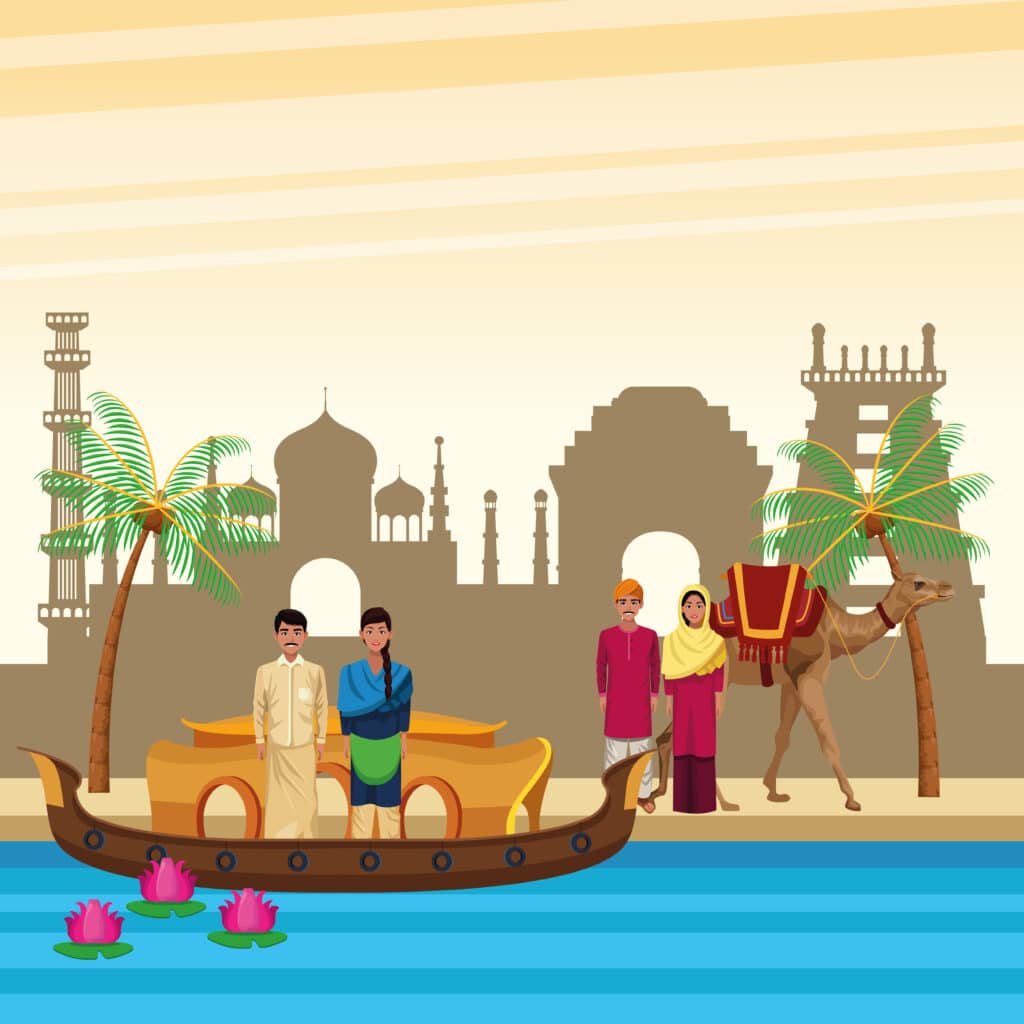
Cultural tourism allows travellers to immerse themselves in the history, heritage, and traditions of different places around the world. This form of tourism can be categorized into several types, each offering a unique way for visitors to experience and appreciate local cultures.
One type of cultural tourism is Historical and Heritage Tourism . This focuses on exploring sites related to a region’s past, such as ancient archaeological sites, monuments, and museums. It can instil a sense of wonder and appreciation for past civilizations’ achievements and teach travellers about the history of the places they visit.
Moving to the artistic side, Arts Tourism highlights the creative aspects of a culture. Tourists visit galleries, theatres, and concerts to experience local art, music, dance, and drama. It allows them to understand different communities’ aesthetic and expressive tendencies, opening their minds to new perspectives and forms of creativity.
Religious and Spiritual Tourism is another common form, where tourists visit religious sites, such as temples, churches, and mosques, or engage in spiritual practices like meditation and yoga. This type of cultural tourism can provide insights into various societies’ belief systems and rituals, fostering understanding and tolerance among people of different faiths.
However, culture isn’t just about history, arts, and religion but also daily life. Ethno and Indigenous Tourism involves tourists visiting and interacting with indigenous communities to learn about their customs, way of life, and unique perspectives on the world. This type of cultural tourism encourages empathy and cross-cultural understanding while emphasising respect for indigenous people’s rights and dignity.
Lastly, Culinary and Agritourism put emphasis on local food and drink traditions, as well as the agricultural practices that underpin them. This type of tourism can include attending food festivals, partaking in cooking classes or workshops, and visiting farms, vineyards, or breweries. Culinary experiences help tourists understand the richness of a region’s flavours and the relationship between local communities and their land and resources.
In summary, cultural tourism comes in various forms, appealing to different interests and tastes. It offers travellers a chance to explore and interact with diverse cultures, fostering connections and understanding among people around the world.
Forms of Cultural Tourism
Cultural tourism offers a wide range of experiences for travellers who seek to immerse themselves in different cultures, traditions, and ways of life. Various forms of cultural tourism cater to different interests and preferences.
Museums and galleries play a significant role in cultural tourism as they showcase a certain location’s history, art, and culture. Examples include art galleries displaying local and international masterpieces and museums featuring exhibits about the history and development of a specific region or theme.
Monuments and historic sites attract cultural tourists interested in exploring the past. Famous landmarks, archaeological sites, and heritage buildings tell the stories of civilizations and cultures that once thrived. UNESCO World Heritage Sites are often at the top of travellers’ lists, representing the world’s most significant cultural and natural heritage.
Architecture as a form of cultural tourism exposes tourists to varying architectural styles and meanings. Walking tours, cityscapes, and visits to iconic buildings provide a deeper understanding of a city’s architectural design’s cultural, social, and political influences.
Festivals and special events are another important aspect of cultural tourism, highlighting a particular community’s local customs and practices. These may include carnivals, parades, performances, traditional dances, and food festivals that provide a unique insight into the cultural identity of a place.
Gastronomy and cuisine play an integral role in the cultural tourism experience, as they allow tourists to savour the flavours and ingredients unique to a location. Local markets, food tours, cooking classes, and traditional restaurants all offer opportunities to appreciate the culinary heritage of a destination.
Shopping for crafts and textiles is a popular form of cultural tourism, as it allows travellers to bring home tangible memories of their journeys. Local artisans may showcase their talents through handmade textiles, pottery, jewellery, and other crafts, reflecting their community’s cultural heritage and artistic expression.
Cultural tourism encompasses diverse experiences, enabling travellers to engage with their chosen destination’s rich history, art, architecture, events, cuisine, and crafts. By exploring these varied aspects, visitors can deepen their understanding and appreciation of the world’s unique cultural landscapes.
Tangible and Intangible Cultural Attractions
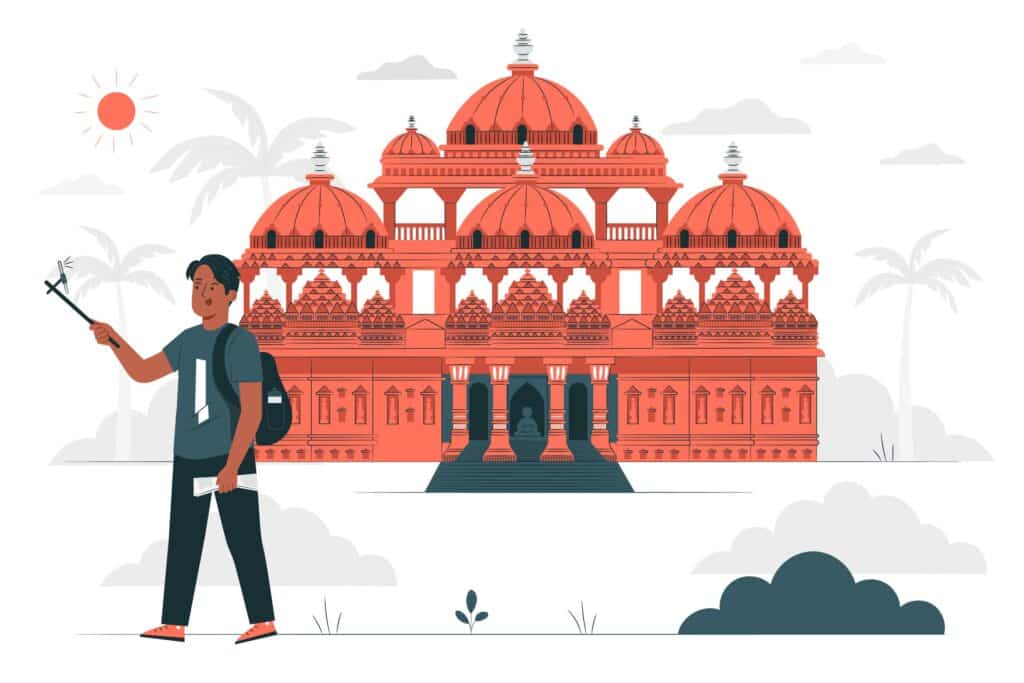
Cultural tourism often focuses on two major aspects: tangible and intangible cultural attractions. These attractions shape a destination’s identity, providing depth and context for visitors and facilitating cultural exchange. This section will explore various facets of tangible and intangible attractions, comprehensively understanding their significance and diversity.
Tangible cultural attractions encompass elements of history, arts, and architecture that visitors can physically experience. Notable examples include monuments, visual art, and crafts that showcase local communities’ unique skills and traditions. Such attractions often reflect centuries of evolution and showcase the ingenuity of a region’s inhabitants. By visiting these sites and engaging with these art forms, travellers gain firsthand insights into the cultural heritage of their destination.
On the other hand, intangible cultural attractions comprise the non-material aspects of a culture that contribute to its unique characteristics and traditions. Music, social practices, festive events, and customs are some of the intangible elements that enrich the cultural landscape of a tourist destination. Interaction with local people plays a crucial role in understanding the region’s intangible cultural attractions, as they act as custodians of these traditions and their oral histories.
A dynamic interplay exists between tangible and intangible cultural attractions, creating a vibrant, multi-dimensional experience for tourists. For instance, the physical structure in architectural landmarks represents the tangible aspect, while the stories, legends, and rituals connected to the site contribute to its intangible allure. This symbiotic relationship reflects the essential interdependence between culture’s material and immaterial aspects.
In conclusion, tangible and intangible cultural attractions are indispensable pillars of cultural tourism. They provide an enriching experience for visitors and play a vital role in preserving and promoting a destination’s unique cultural heritage. Both aspects should be regarded with equal importance and cultivated to ensure a comprehensive and engaging experience for travellers seeking to explore a destination’s cultural offerings.
Advantages of Cultural Tourism
Cultural tourism provides a unique opportunity for individuals to immerse themselves in a particular society’s history, traditions, and customs. In doing so, they can develop a deeper understanding and appreciation of the diverse cultures that make up the world.
One significant advantage of cultural tourism is its potential to boost local economies. Tourist expenditures in local businesses such as hotels , restaurants, and shops can contribute to the growth and development of a region. Additionally, cultural tourism can create jobs, especially for local artisans, performers, and guides who offer authentic cultural experiences to visitors.
Another benefit of cultural tourism is the preservation and revitalization of cultural heritage. By attracting tourists interested in learning about and experiencing different traditions, communities are encouraged to preserve and maintain their cultural assets, such as historic sites, museums, and festivals. This helps ensure that future generations can continue to enjoy and learn from these valuable resources.
Cultural tourism also fosters cross-cultural understanding and appreciation. As people engage with diverse cultures, they may develop a broader perspective and a greater respect for cultural differences. This can lead to increased tolerance and harmony among different societies.
However, it is important to be aware of the potential disadvantages of cultural tourism. For instance, there may be issues related to overcrowding, environmental impact, or the commodification of cultural traditions. This makes it crucial to manage cultural tourism responsibly, ensuring it benefits both the tourists and the host communities.
Disadvantages of Cultural Tourism
Cultural tourism has gained popularity in recent years, drawing visitors from around the globe to experience and appreciate diverse cultures. However, this type of tourism also brings several disadvantages that must be considered.
One significant drawback of cultural tourism is the potential for commodification of cultures. As communities open their doors to tourists, they risk losing the authenticity and uniqueness of their cultural identity. Traditional practices and artefacts may be tailored to appeal to the tourist market, diluting their cultural significance.
Moreover, cultural tourism can put pressure on resources and spaces used by local communities. The influx of tourists may lead to overcrowding and increased competition for essential amenities. This could negatively impact the quality of life for local residents and strain the available infrastructure.
Another issue is the potential for environmental degradation resulting from cultural tourism. Some tourist activities may involve access to sensitive natural areas, leading to erosion, pollution, or disturbance of wildlife habitats. The construction of tourist facilities and infrastructure can also threaten the environment.
Lastly, cultural tourism can contribute to the unequal distribution of economic benefits. While some members of the community may profit from tourism-related businesses, others may not be able to participate in or benefit from these enterprises. This could exaggerate income disparities and create economic imbalances within communities.
In conclusion, despite cultural tourism’s numerous benefits to travellers and host communities, it is crucial to acknowledge and address its potential negative aspects. To ensure the long-term success of cultural tourism, policies and practices must be implemented that prioritize the protection of cultural and environmental resources and promote equitable distribution of economic benefits.
Cultural Tourism Destinations

Cultural tourism is a popular type of travel that allows visitors to immerse themselves in various destinations’ history, heritage, and traditions. Throughout the world, numerous places provide rich cultural experiences for travellers. Here, we explore a few notable cultural tourism destinations.
China is a vast and diverse country with a history dating back thousands of years. One can explore the architectural wonders of the Great Wall, the Terracotta Army in Xi’an, or the magnificent Forbidden City in Beijing. Visiting local markets and trying traditional cuisine also adds to the cultural experience in China.
India is another top destination for cultural tourism, offering many historical sites and vibrant traditions. The Taj Mahal in Agra, a UNESCO World Heritage Site, is a must-see with its iconic marble mausoleum. Another popular destination is Rajasthan , where the colourful cities and the royal palaces, such as the spectacular City Palace of Jaipur, offer a glimpse into the past.
France , specifically Paris , provides visitors with rich art, architecture, and cuisine. Iconic sites such as the Louvre, Notre Dame Cathedral, and the Eiffel Tower showcase the country’s artistic and architectural achievements throughout history.
Similarly, Spain is renowned for its rich cultural heritage with attractions such as the Alhambra in Granada, the Park Güell in Barcelona, designed by Gaudí, and the Prado Museum in Madrid.
Turkey , especially Istanbul , offers an intricate blend of European and Asian influences, with historic sites such as the Hagia Sophia, the Blue Mosque, and the Topkapı Palace. Moreover, the open-air bazaars and Turkish baths deliver an authentic cultural experience.
Italy , the birthplace of the Renaissance, is brimming with artistic and architectural masterpieces. Cities like Rome, Florence, and Venice are steeped in history, allowing visitors to marvel at landmarks like the Colosseum, St. Peter’s Basilica, or the Uffizi Gallery.
The beautiful island of Bali in Indonesia is known for its lush landscapes, Hindu temples, and vibrant arts scene, making it an excellent location for immersing oneself in the culture of the region.
Uzbekistan has gained attention recently as tourism grows along the Silk Road route. Visitors can admire the stunning architecture and mosaics of cities such as Samarkand, Bukhara, and Khiva, which capture the rich heritage of the ancient trading route.
In conclusion, cultural tourism invites travellers to explore fascinating destinations across the globe. While each location offers unique experiences, they provide a deeper understanding of human history, traditions, and heritage.
Stakeholders of Cultural Tourism

Cultural tourism is a multi-faceted industry that brings value to travellers in search of authentic experiences and to a myriad of stakeholders. From local communities to government bodies and from small businesses to environmental conservation efforts, cultural tourism can shape economies and lifestyles in both positive and negative ways. This guide delves into the key stakeholders in the cultural tourism sector, exploring their roles, impacts, and interconnected interests.
Tourists: The Heart of the Industry
Arguably, tourists are the backbone of cultural tourism. Whether they are history enthusiasts seeking out ancient ruins or gastronomes on the hunt for authentic local cuisine, tourists drive demand and shape the landscape of the tourism industry. They often seek enriching experiences that can offer a deep understanding of local cultures.
Local Communities: The Soul of the Destination
Local communities provide the lived experience that many cultural tourists seek. These people preserve the traditions, language, and heritage sites that form the basis of cultural tourism. Unfortunately, they can also bear the brunt of poorly managed tourism through cultural commodification and environmental degradation.
Government Bodies: The Framework Providers
Local and national governments play an instrumental role in regulating and promoting cultural tourism. They invest in infrastructure, enforce zoning laws, and facilitate public services like safety and sanitation that are vital to the tourism industry.
Tourism Boards and Agencies: The Promoters
Tourism boards, often funded by governments, are responsible for marketing a destination’s cultural assets to the world. These bodies work closely with other stakeholders to develop tourism packages, advertise local attractions, and even set guidelines for responsible tourism.
Tour Operators and Travel Agents: The Experience Curators
Specializing in delivering personalized experiences, these businesses are intermediaries between tourists and destinations. They can make or break the quality of the cultural tourism experience through their choices of local partnerships, itineraries, and guides.
Cultural Institutions: The Keepers of Heritage
Museums, art galleries, and historical sites are essential touchpoints for cultural tourists. They collaborate closely with various stakeholders to ensure that cultural assets are preserved and made accessible to the public.
Artisans and Performers: The Artistic Impressions
Artisans and performers add texture to the cultural fabric of a destination. These stakeholders benefit from increased visibility and economic opportunities , providing tourists a gateway to the authentic local culture.
Small Business Owners: The Local Economy Boosters
From restaurants and cafes to souvenir shops, small businesses see a surge in revenue when cultural tourism is thriving. They form a vital part of the local economy, providing services that enrich the tourist experience.
Academics and Researchers: The Thought Leaders
Cultural tourism is a field ripe for academic inquiry, touching upon anthropology, economics, and sociology disciplines. Research in this area can help shape policies that benefit tourists and local communities.
NGOs: The Advocates of Sustainability
Organizations that focus on cultural or environmental conservation often align with the interests of responsible cultural tourism. They act as watchdogs and advocates, ensuring that tourism practices are sustainable and ethical.
Real Estate Developers: The Infrastructure Builders
Though not directly related to the culture, real estate is essential in accommodating the influx of tourists, especially in booming destinations. They must balance business interests with responsible development.
Media: The Influencers
Media outlets, including travel bloggers and journalists, have a significant role in shaping public perception of a destination. Their storytelling can amplify the benefits or expose the pitfalls of cultural tourism.
The Environment: The Unspoken Stakeholder
Although not a traditional “stakeholder,” the environment stands to be significantly affected by tourism activities. Sustainable practices must be adopted to preserve the natural and cultural landscapes that attract visitors in the first place.
Understanding the intricate web of stakeholders in cultural tourism is the first step in creating an industry that benefits all. As cultural tourism evolves, stakeholders must actively dialogue to ensure sustainable and enriching experiences for everyone involved.
Cultural Tourism Experience
Cultural tourism experiences provide a unique opportunity for travellers to immerse themselves in the local culture, customs, and traditions of the places they visit. These immersive travel experiences enable tourists to understand the heritage and identity of the communities they encounter.
One popular way to experience cultural tourism is through homestays. These accommodations offer the chance to live with a local family, providing a firsthand glimpse into their daily lives and customs. The cultural exchange within a homestay environment can be transformative, offering insights that would otherwise remain veiled during a typical sightseeing vacation.
Another important aspect of cultural tourism is engaging with the local communities, participating in their events and festivals, and learning about their history and heritage through interactions with the people there. These experiences enable travellers to connect meaningfully with locals, fostering mutual appreciation and understanding of different cultures.
Cultural experiences often focus on different dimensions, such as:
- Arts and crafts: Exploring local artisans’ craftsmanship and heritage by visiting workshops, galleries, and markets.
- Cuisine: Sampling regional culinary specialities can offer a taste of local culture, traditions, and history.
- Religious sites: Visiting places of worship offers insight into the spiritual beliefs and practices of the area.
- Performing arts: Engaging with local music, dance, and theatre performances can reveal unique cultural perspectives and expressions.
Cultural tourism emphasizes responsible travel and encourages visitors to respect and appreciate the local customs, traditions, and the natural environment while exploring new destinations. Tourists can create unforgettable memories by connecting with people from different backgrounds and gaining a deeper understanding of their practices and values, fostering greater global empathy and cultural appreciation.
Subscribe to our free Newsletter! →
Home › Best Of The Best
Top 7 Best Tourist Attractions In The US, Per Travel Experts
By Matthew Sherdan
Reviewed by Sophia Naughton
Jul 10, 2024
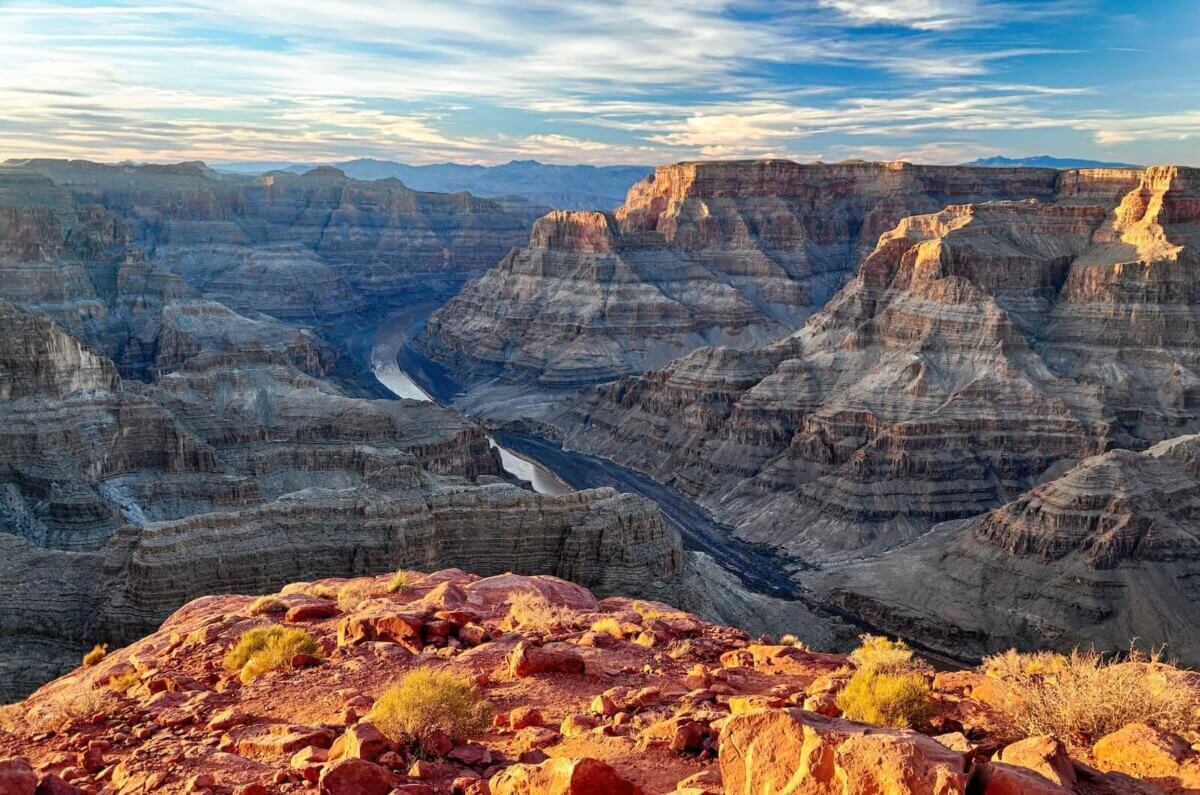
The Grand Canyon (Photo by Omer Nezih Gerek on Unsplash)
Gearing up and planning for your summer road trip is a great feeling of anticipation and excitement. America is filled with great vacation spots and tourist attractions. From coast to coast, every state has at least one great tourist destination. Whether it’s the beaches, the mountains, or the plains, you’re sure to find a beautiful place around America worthy of your vacation time. As you search for fun places to visit and exciting activities to plan, we’re here to give you some ideas with the best tourist attractions in the U.S.
So, where do we begin? StudyFinds did the digging, consulting 10 travel and tourism websites to bring you a consensus list of the best tourist attractions in the U.S. Our list comprises the seven most frequently listed attractions across these sites. Do you think we missed a hidden gem of an attraction? Feel free to share your thoughts with us in the comments section below!
StudyFinds compiles lists of consensus picks featured on credible review sites. We aim to lay out top consumer research finds for you by bringing expert rankings to one place.
Table of contents, 1. grand canyon, 2. yellowstone, 3. walt disney world, 4. golden gate bridge, 5. niagara falls, 6. yosemite, 7. national mall, washington d.c..
Topping the list of the best tourist attractions in the United States is none other than the Grand Canyon. It’s one of the most spectacular sights on Earth, so it stands to reason that people flock from all over the globe to take in its majestic beauty. The Grand Canyon is truly one of America’s greatest natural wonders , says U.S. News and World Report .
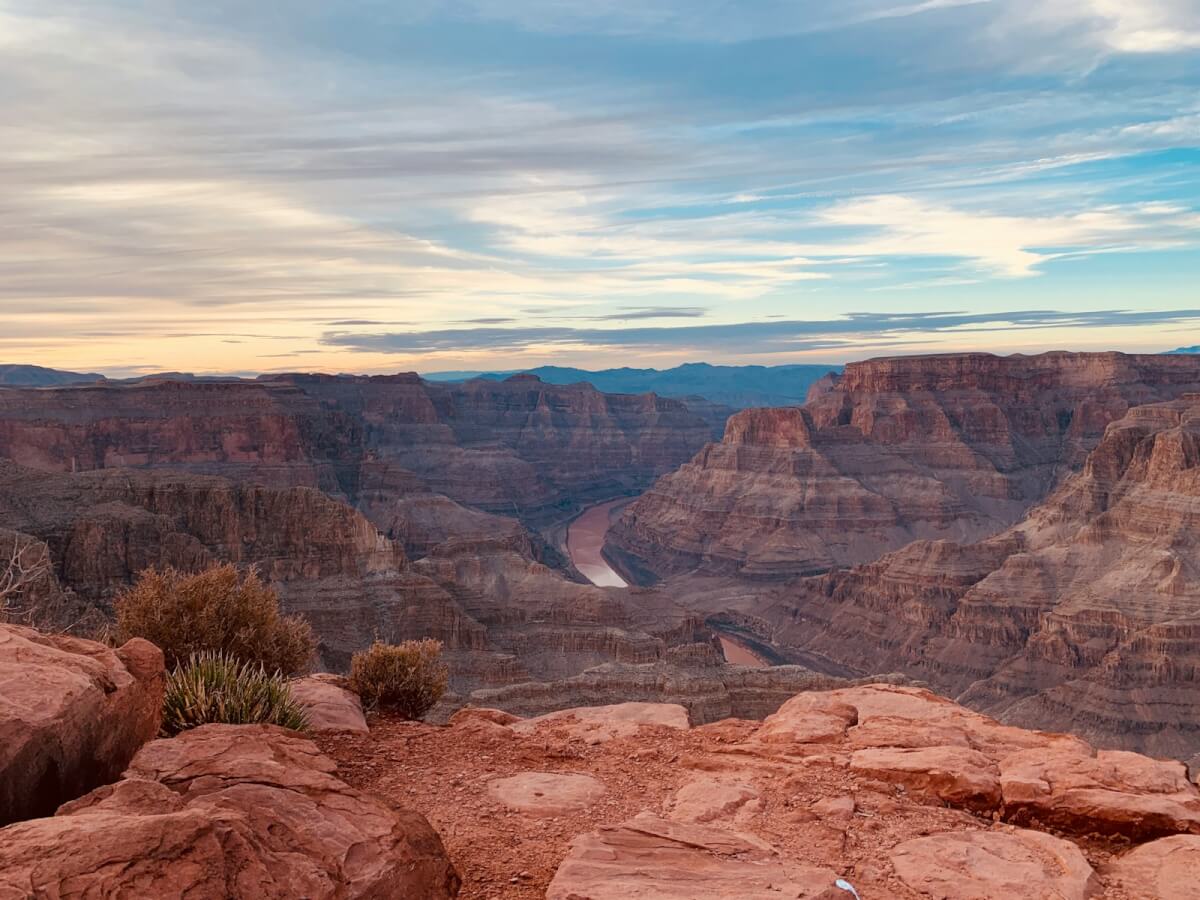
The Grand Canyon has been carved out by the Colorado River and the forces of nature , over millions of years. TourScanner calls the Grand Canyon “nature’s magnum opus” for a reason. The first time you lay eyes on the Grand Canyon, expect to have your breath taken away by its size and magnificence. One thing you’ll immediately notice is the layers of red rock which reveal millions of years of geologic history .
The canyon is roughly one mile deep and over 277 miles long , explains Touropia . However, the best place to take in the majestic sight is at Grand Canyon National Park . Although the Grand Canyon is not the world’s deepest or largest canyon, the rock layers combined with the stunning views and the Colorado River make it one of the most spectacular attractions in America.
Following the Grand Canyon is Yellowstone National Park. As Attractions of America describes, Yellowstone is the most famous and popular of all the national parks for a reason. From hiking to snowmobiling, Yellowstone is one of the premier family vacation destinations in the country.
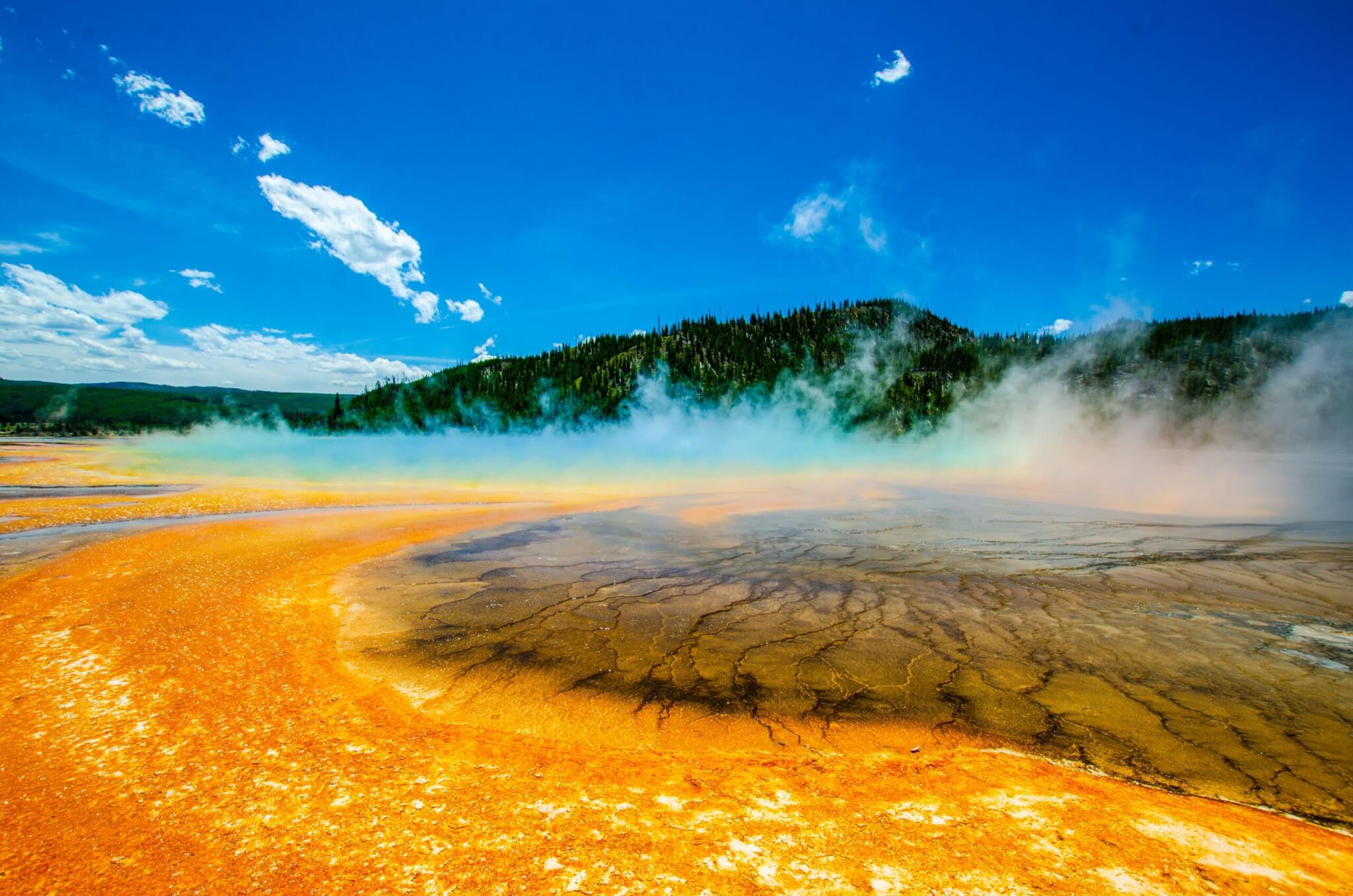
World Atlas calls Yellowstone “a spectacular sight to behold.” The majority of the park is located in Wyoming and sits on a dormant volcano , which helps it offer one of the largest collections of hot springs and natural geysers in the entire world. The park also features Yellowstone Lake and more than 900 miles of hiking trails . For bicycle enthusiasts, Yellowstone has you covered as well. Enjoy a scenic bike ride up Fountain Freight Road which leads through a section of the Midway Geyser Basin. Undoubtedly, Yellowstone offers recreational activities for all types of nature enthusiasts.
Yellowstone spans more than 3,000 square miles, notes Private Tour . The park has remained untouched for centuries and those preservation efforts mean everyone can enjoy the park as if you’re seeing it for the first time. From wildlife such as elks, buffaloes, wolves, and grizzly bears to more than 3,000 square miles of waterfalls, canyons, geysers, and mountains, Yellowstone is truly one of the can’t-miss tourist attractions in the United States.
If all these nature parks have you pining for a rollercoaster or a fun park, you’ll love the next attraction – Walt Disney World. Walt Disney World is located in Orlando, Florida and it draws millions upon millions of visitors from all over the globe, every year. It is the top family attraction in America, notes Planet Ware . Although this amusement park officially opened in 1971, Walt Disney World has been able to maintain its allure for family members of all ages.
As Explore explains, Walt Disney World is comprised of water parks, hotels, resorts, golf courses, camping grounds, and four theme parks – Magic Kingdom, Epcot, Hollywood Studios, and Animal Kingdom. To go with all of these attractions, Walt Disney World also features a downtown shopping center known as Disney Springs where you can find a range of shops, restaurants, and entertainment options. Walt Disney World attracts an estimated 52 million visitors every year with no signs of slowing down anytime soon.
As TourScanner explains, Walt Disney World was originally designed to be the “happiest place on earth” and for the most part, this attraction lives up to its billing. Disney movies have been entertaining families for generations, so it’s no surprise that even the most sophisticated adults instantly transform into 10-year-old kids again as soon as they enter one of the many theme parks or attractions at the park.
Let’s hop over to the West Coast to San Francisco’s Golden Gate Bridge. The nearly 2-mile-long bridge connects San Francisco with Marin County in California , and it’s one of America’s most iconic landmarks, notes U.S. News and World Report . The infamous Golden Gate Bridge has been featured in movies, TV shows , and across pop culture, but nothing beats seeing this magnificent piece of infrastructure in person.
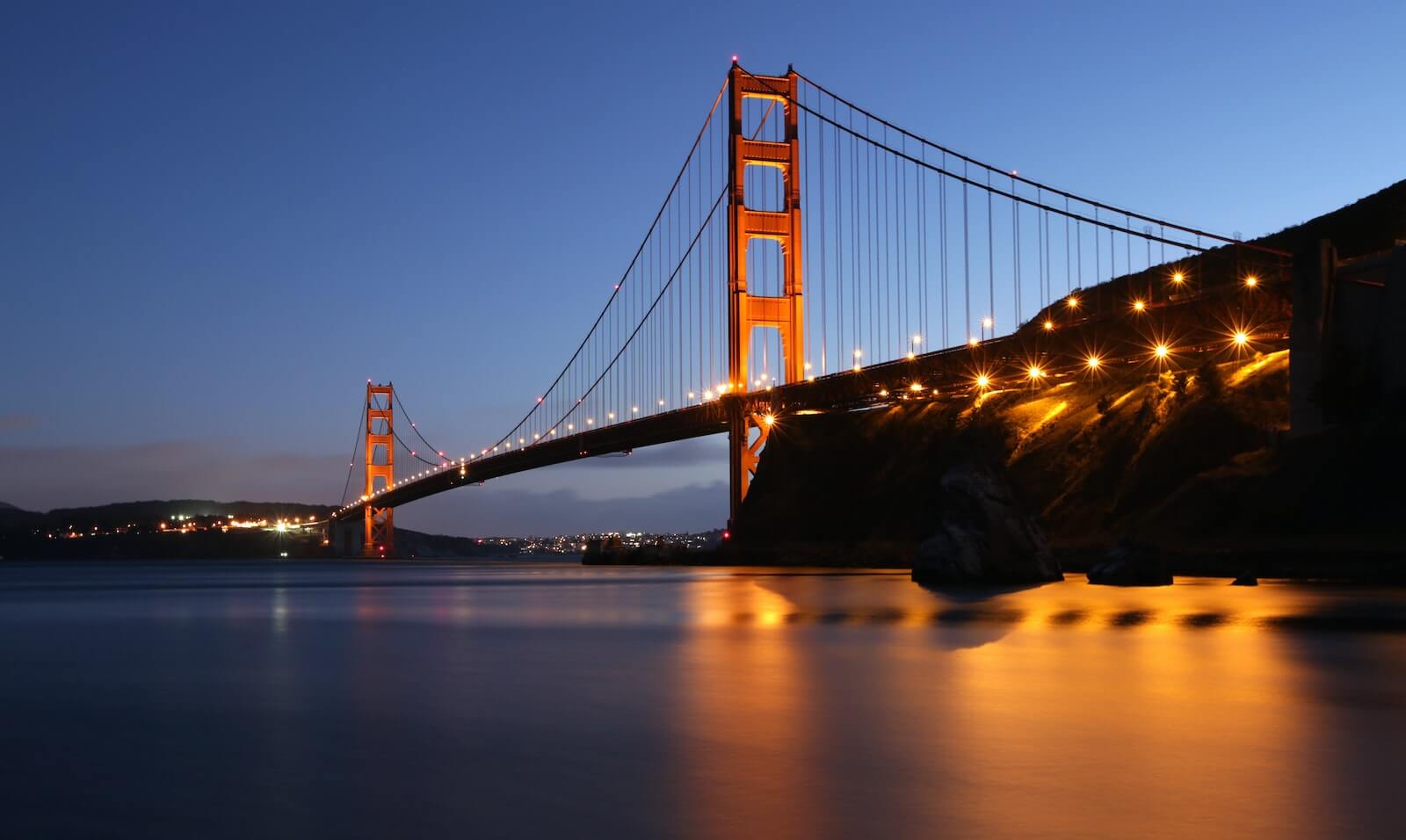
As Touropia explains, the Golden Gate Bridge was designed with a red-orange color to make the bridge visible through San Francisco’s thick fog. The bridge was completed in 1937 and for years it stood as the world’s longest suspension bridge. Today, tourists can enjoy driving over the bridge or visiting Golden Gate Park where you can walk, hike, or bike to explore the natural areas surrounding the bridge.
Not only are you visiting one of the most iconic landmarks in the United States, but you’re witnessing one of the Wonders of the World, notes Attractions of America . The bridge is one of the most photographed bridges in the world and it’s a true testament to the power of human engineering. If you ever find yourself on the West Coast during vacation, do yourself a favor and visit the Golden Gate Bridge.
Misting into the fifth spot can only be Niagara Falls. The falls are a combination of three waterfalls – Horseshoe Falls, American Falls, and Bridalveil Falls, explains TimeOut . The natural beauty of Niagara Falls makes it a top attraction for tourists from all over the globe, not just the United States. Part of the falls are located in Canada and the other in the U.S., but it’s truly a must-see sight regardless of which side you’re on.
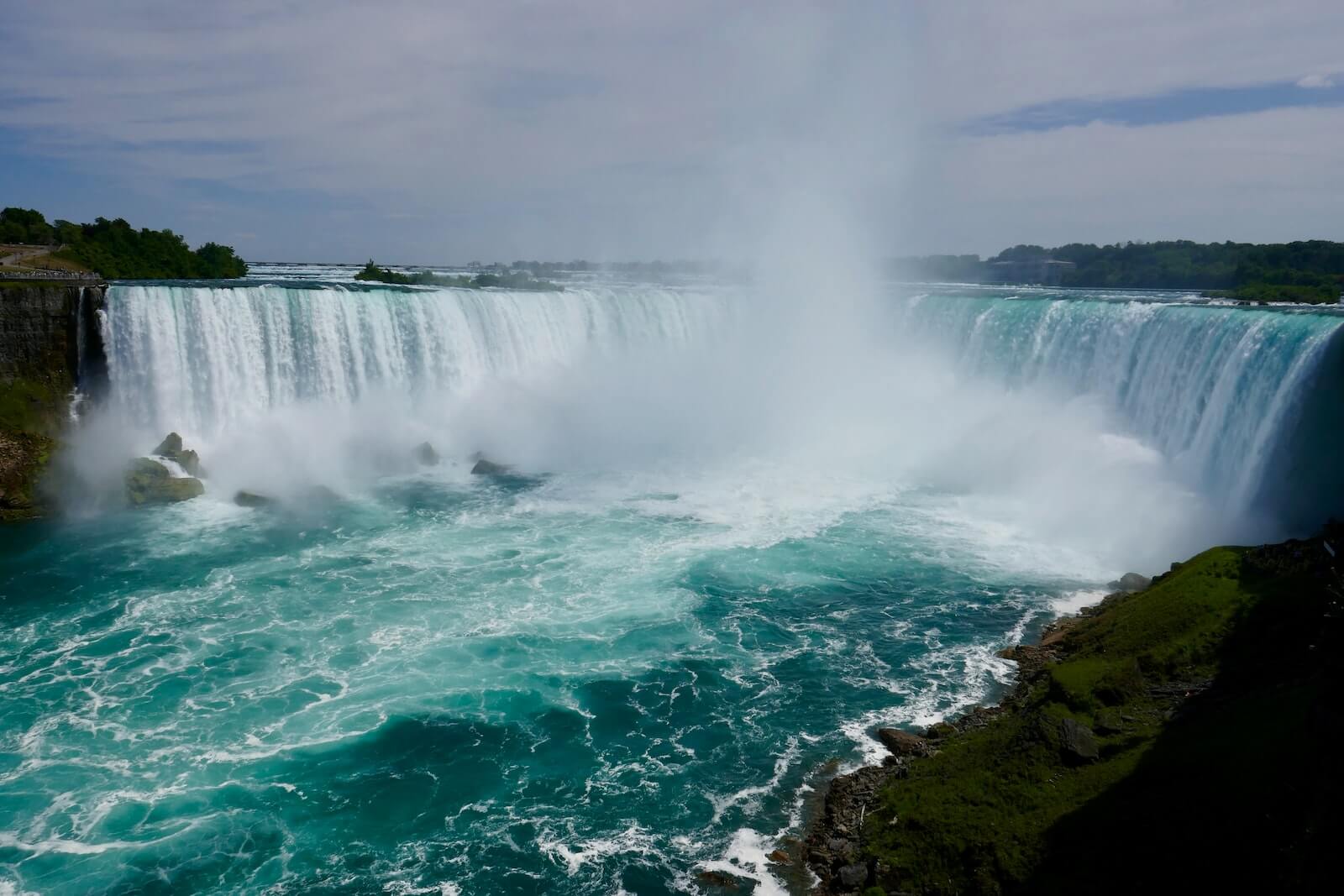
Horseshoe Falls is situated in Canada while the other two, Bridalveil and American Falls, are located in the U.S., explains Touropia . Niagara Falls sees more than 14 million visitors each year, making it one of the most visited tourist attractions in the entire world . Of course, Niagara Falls is also a popular wedding destination as well as a notorious honeymoon destination. Love, and mist, are certainly in the air in upstate New York.
The falls are part of the Niagara River which flows from Lake Erie to Lake Ontario. You can’t go wrong visiting Niagara Falls, day or night, explains Explore . Floodlights situated along the base of the falls allow for a nighttime view while the Maid of the Mist boat cruise makes for a perfect daytime activity. The boat cruise is one of the most popular things to do at Niagara Falls as it takes you into the basin of Horseshoe Falls which is one of the most powerful waterfalls in North America. If you’re anywhere near upstate New York on your next trip, be sure to witness the mighty Niagara Falls.
Located in the Sierra Nevada Mountains of central California , Yosemite is one of the best places to visit for nature lovers, explains Planet Ware . The incredible granite domes of sights such as El Capitan and Half Dome must be seen in person to fully appreciate the natural beauty and grandeur of these epic natural monuments.
Yosemite is full of fun family activities that everyone will enjoy. From hiking to climbing to horseback riding to river rafting , Yosemite offers something for everyone in your family, explains World Atlas . You’ll also bear witness to giant sequoia trees and gorgeous waterfalls tumbling off the granite cliffs in Yosemite. The infamous Horsetail Fall is a great spot to take in a sunset and witness the beauty of nature as the sun illuminates the water. From there, drive through the tunnel carved into a giant fallen Sequoia in Tuolumne Grove.
Yosemite offers more than 800 miles of hiking trails for explorers and hikers of all ages and skill levels. Hiking up one of the many trails is a great way to escape the crowds at various lookout points and enjoy the peace and serenity of the park. As Private Tour notes, Yosemite is 1,200 square miles of gorgeous granite monoliths, waterfalls, cliffs, and giant Sequoia trees that are hundreds of years old. Your family will never forget a trip to Yosemite.
Rounding out the list is none other than the National Mall in Washington, D.C. This is one of the premier destinations for 8th-grade field trips from around the country, but Washington D.C. is also one of the top tourist spots in America, and for good reason. As TimeOut notes, the National Mall in D.C. is immaculately maintained by the National Parks Service and features more than 1,000 acres of monuments, sights, and green space . You’ll first notice that the Washington Monument towers above everything else, which is because the area isn’t zoned for buildings taller than the Washington.

Still, the National Mall includes the Capitol Building, the Lincoln Memorial, the Martin Luther King Jr. Memorial, the Vietnam Memorial Wall, the World War II Memorial, the Jefferson Memorial, and many more . The heartbeat of our government and hundreds of years of American history resonates throughout the National Mall, writes TourScanner . A trip to the nation’s capitol isn’t just reserved for field trips and kids. There is plenty to see and do here as an independent tourist. From museums to monuments, the National Mall will not disappoint anyone looking to learn more about democracy and our great nation’s history. You could easily spend a day or a week taking in all the National Mall offers.
As Explore notes, the National Mall spans a two-mile area between the Capitol Building and the Lincoln Memorial. The National Mall sees a staggering 24 million visitors per year as tourists from across the world flock to the infamous Smithsonian museums , historic monuments, and beautifully manicured green spaces. The area is busy at all times of year with the busiest probably being the spring or the summer months. Either way, you can’t go wrong visiting the National Mall any time of year. It’s a bucket-list destination with plenty to offer the whole family.
- U.S. News and World Report
- TourScanner
- Best Diplomats
- Planet Ware
- Attractions of America
- World Atlas
- Private Tour
Note: This article was not paid for nor sponsored. StudyFinds is not connected to nor partnered with any of the brands mentioned and receives no compensation for its recommendations. This article may contain affiliate links in which we receive a commission if you make a purchase.
About Matthew Sherdan
Our Editorial Process
StudyFinds publishes digestible, agenda-free, transparent research summaries that are intended to inform the reader as well as stir civil, educated debate. We do not agree nor disagree with any of the studies we post, rather, we encourage our readers to debate the veracity of the findings themselves. All articles published on StudyFinds are vetted by our editors prior to publication and include links back to the source or corresponding journal article, if possible.
Our Editorial Team
Editor-in-Chief
Chris Melore
Sophia Naughton
Associate Editor
Related Content

The green veggie you’re not eating enough of, according to a dietitian
July 12, 2024

Real-life ‘stillsuit’: Dune-inspired upgrade for spacesuits allow astronauts to recycle urine into water

Blood fat report card reveals benefits of making healthy food swaps
Leave a comment cancel reply.
You must be logged in to post a comment.

©2024 Study Finds. All rights reserved. Privacy Policy • Disclosure Policy • Do Not Sell My Personal Information

IMAGES
VIDEO
COMMENTS
Wildlife attraction examples: San Diego Zoo (USA), Monkey Island, Sanya (China), Atlantis Aquarium, Dubai (UAE), Tiger Temple, Chiang Mai ( Thailand ). There are many types of tourist attractions that involve the use of wildlife. Some of these are natural areas, such as grazing lands when you go on a safari.
The world's top tourist attractions by the number of visitors have a lot in common: they are typically in urban centers (Union Station, Washington, D.C.), free of charge (Central Park, New York ...
Each type offers unique experiences and insights into different aspects of our world, from iconic landmarks and natural wonders to theme parks and museums. 1. Iconic Landmarks. Iconic Landmarks are perhaps some of the most well-known tourist attractions globally. They represent a country or city's identity and are significant symbols ...
At this tourist attraction, you can sample more than 100 types of soda from around the world, witness the bottling process, see classic ads and slogans, and enter the Vault of the Secret Formula.
Times Square is the most visited public (not privately owned) tourist site in the United States, with about 50 million visitors annually.. This is a list of the most popular individual tourist attractions in the United States, lists of tourist attractions organized by subject region, and a selection of other notable tourist attractions and destinations.
Towns and cities. Examples of tourist cities: Paris, Rome, London, New York, Sydney, Shanghai, Cape Town, Rio de Janeiro. Towns and cities are popular types of tourist destinations. One of the reasons for this popularity is accessibility. Typically, large towns and cities are well connected.
Types Tropical beaches and Balinese culture are attractions that draw tourists to this popular island resort, such as Melasti rituals performed on the beach. Tourists in the medieval old town of Porvoo. Places of natural beauty such as beaches, tropical island resorts, national parks, mountains, deserts and forests, are examples of traditional tourist attractions which people may visit.
Beyond the ones we listed, there are plenty of other types of tourism, such as medical tourism, religious tourism, wellness tourism, dark tourism, and more. Broadly speaking, however, we could consider leisure and business tourism to be among the two main categories based on travelers' motivation. Categories.
2. Niagara Falls | New York State. Photograph: Shutterstock. Situated on the border of New York and Canada, the three waterfalls (Horseshoe Falls, American Falls and Bridalveil Falls) have the ...
This is one of the most common types of tourism. Millions of people travel to the beach every year. A few of the top beach tourism destinations include Spain, Thailand, Australia, the United States, Brazil, Mauritius, the Bahamas, the Philippines, and more. There are thousands of spectacular beaches around the world.
Domestic tourism. Domestic tourism involves traveling within one's own country rather than going abroad. This type of tourism allows individuals to explore different regions, cultures, and attractions within their national borders. It's a way to support local economies and discover the diversity of one's own country.
The tourism sector is constantly evolving, expanding beyond the basics of domestic, inbound, and outbound tourism. As travel agencies, it is crucial to stay informed about the diverse range of tourism types to develop effective strategies and fuel the growth of your business. This comprehensive guide presents 62 types of tourism, offering ...
Here are some common types of tourist attractions, arranged by category or type: Table Of Contents 1. Natural Attractions: 2. Cultural Attractions: 3. Urban Attractions: 4. Adventure and Outdoor Attractions: 5. Educational Attractions: 6. Relaxation and Wellness Attractions: 7. Special Events
Alhambra, Spain. 27. Buckingham Palace, London. 28. Ubud, Bali, Indonesia. 1. Eiffel Tower, Paris. Spring flowers in front of the Eiffel Tower. The symbol of Paris and one of the most photographed structures in the world, a visit to the Eiffel Tower is a must for all travelers.
There are 4 major types of tourist attractions found around the world: natural attractions, man-made attractions, sport attractions and events. Tourist attra...
Family tourism refers to traveling as a family, typically for leisure and relaxation purposes. This type of tourism is often characterized by a focus on family-friendly activities and experiences, and may include visits to theme parks, zoos, and other attractions, as well as outdoor activities such as hiking and camping.
Different types of tourist attractions have a lot to offer the tourism industry. From entertainment to leisure to being amongst nature, there are many different reasons why tourists want to visit areas that are home to major (or minor) tourist attractions. Natural attractions. Natural attractions are often what attracts tourists to particular ...
Welcome, wanderlust seekers and adventure enthusiasts, to a thrilling exploration of the world's diverse tapestry of tourism! Embark on a captivating journey as we unveil the tantalising realm of travel, introducing you to the mesmerising array of types of tourism that will ignite your wanderlust. From the adrenaline-pumping escapades of adventure tourism to the enriching experiences of ...
Famous cultural tourism places are:-. India - Durga puja in Kolkata, Temples at Banaras, Jaipur, known as the pink city Palace in Rajasthan. Forts and monuments in Delhi, Agra, UP. UK - Tower of London, The British Museum, Big Ben, London Durga puja, etc. Kenya - The main attraction is the dance of the Maasai tribe.
9. Generalists. Generalist tourists are a combination of all types of tourists. These travelers set out to a certain destination with an open mind to experience as much as it has to offer. A generalist tourist can look at a certain style of architecture one day and be interested in the food of a city the next day.
Cultural tourism is a significant and growing aspect of the global tourism industry. The United Nations World Tourism Organization (UNWTO) defines cultural tourism as the movement of people to cultural attractions away from their normal residence, with the intention of gathering new information and experiences that satisfy their cultural needs. It encompasses various activities undertaken by ...
2) Countryside tourism. This one is exactly what it says on the tin. Travellers visit remote areas in order to get a taste of something simpler - often for cheaper than anything is available in the big city. This type of tourism isn't as rooted in tours or tourist attractions so much as others.
Undoubtedly, Yellowstone offers recreational activities for all types of nature enthusiasts. ... making it one of the most visited tourist attractions in the entire world. Of course, Niagara Falls is also a popular wedding destination as well as a notorious honeymoon destination. Love, and mist, are certainly in the air in upstate New York. ...
You can also use social media platforms to interact with people and attract tourists to your destination. Investing in digital marketing and search engine optimization can drastically improve your destination visibility, driving increased website traffic, and building tourism awareness. 3. Promote local attractions.